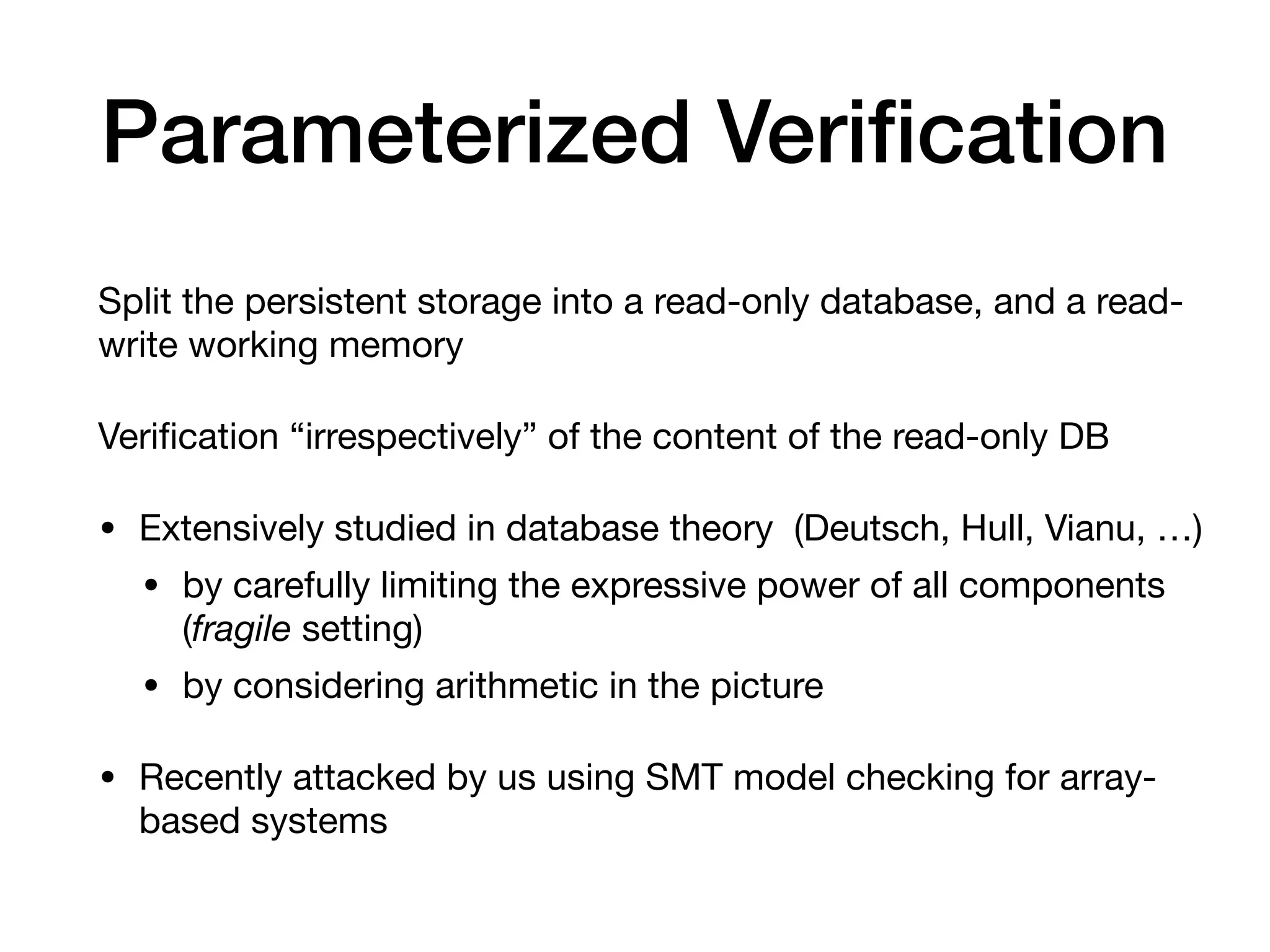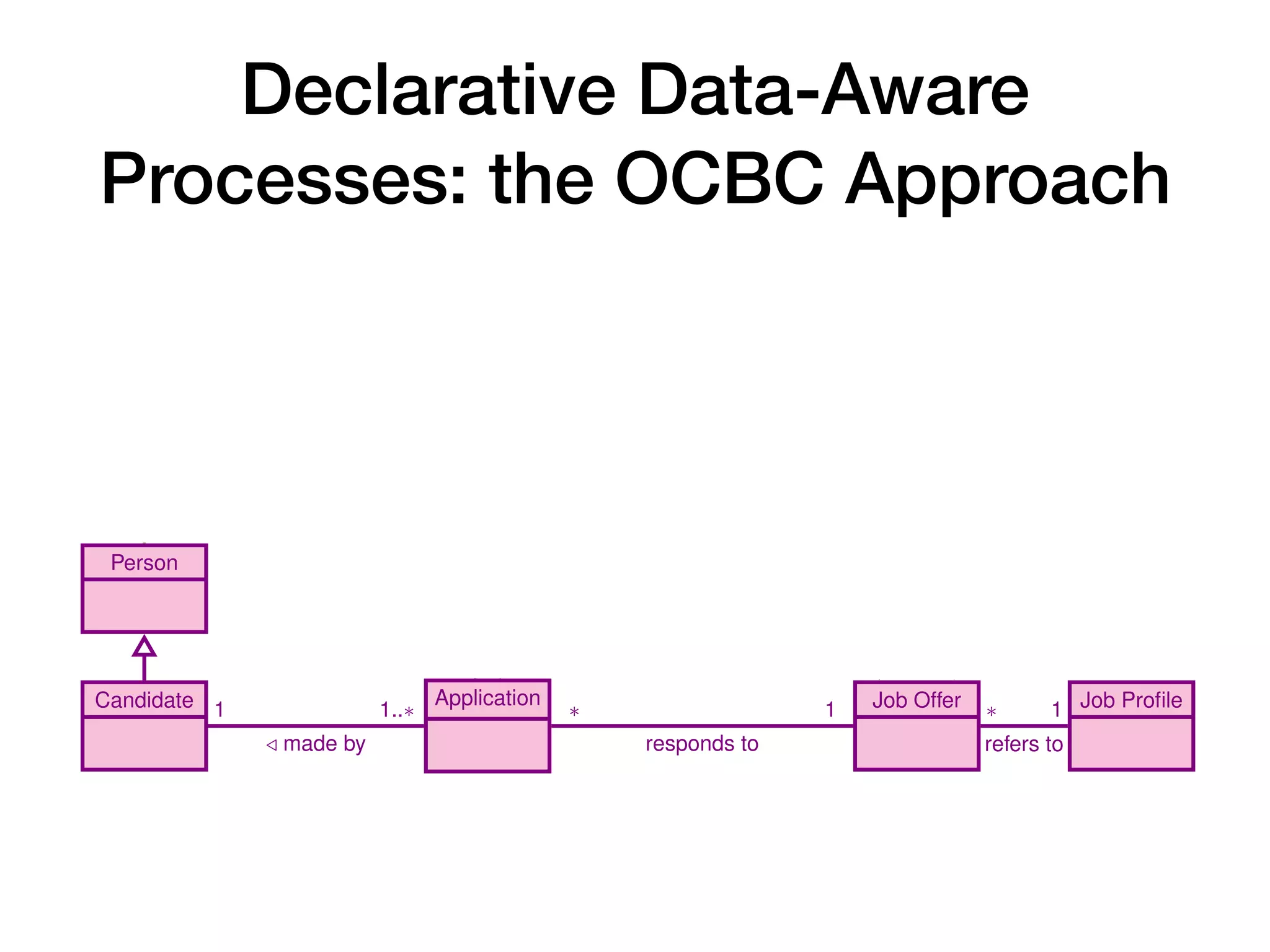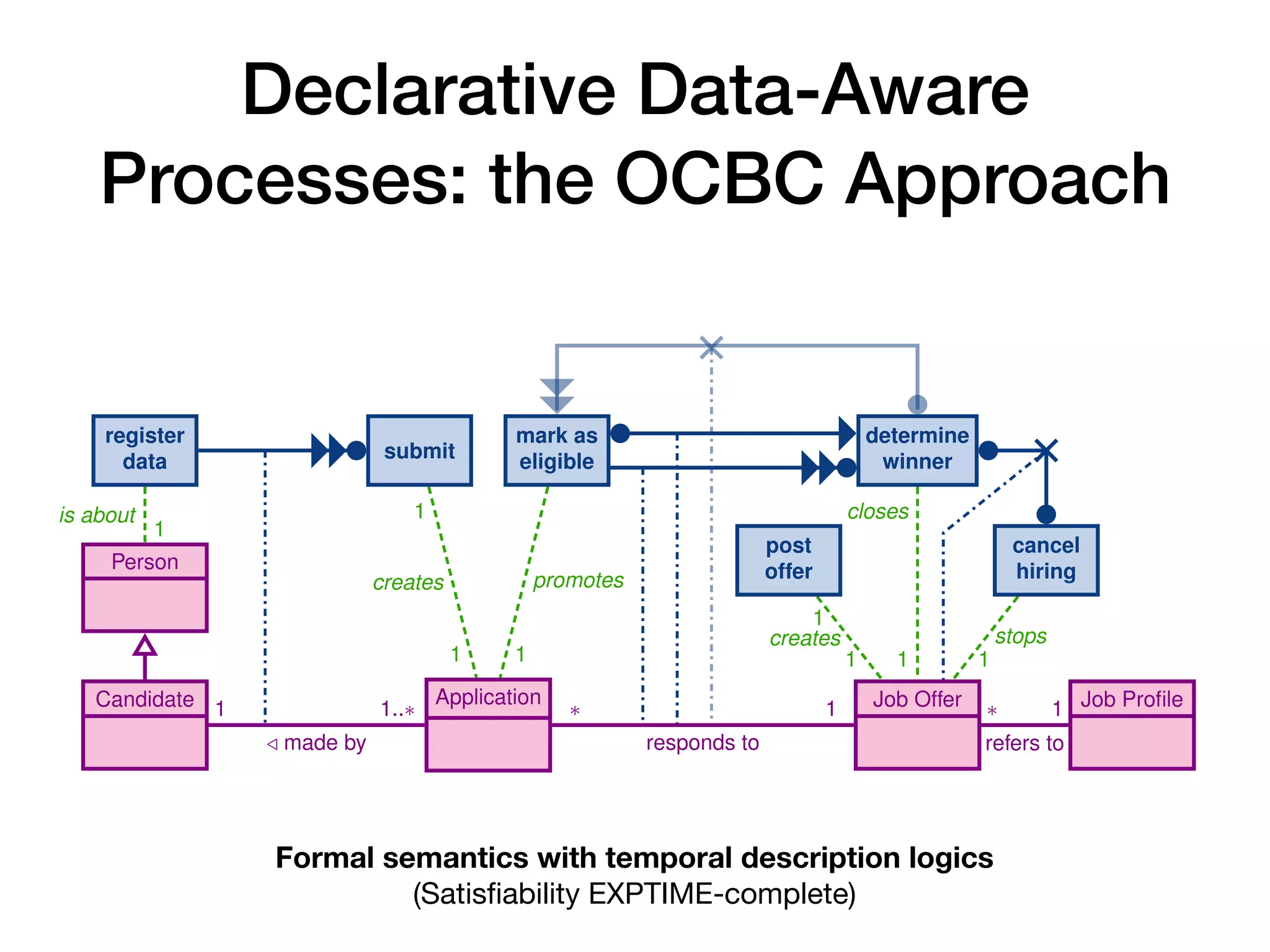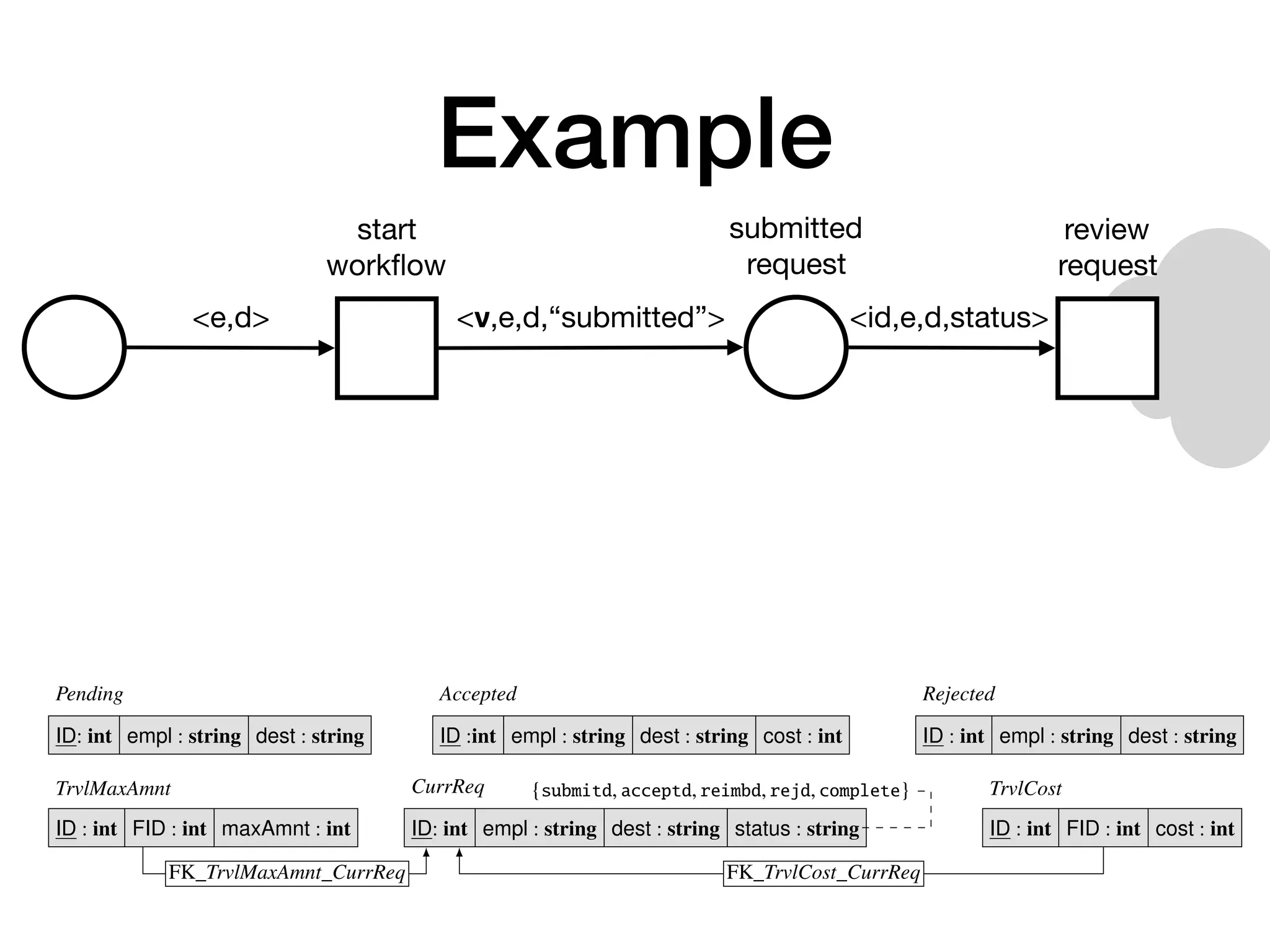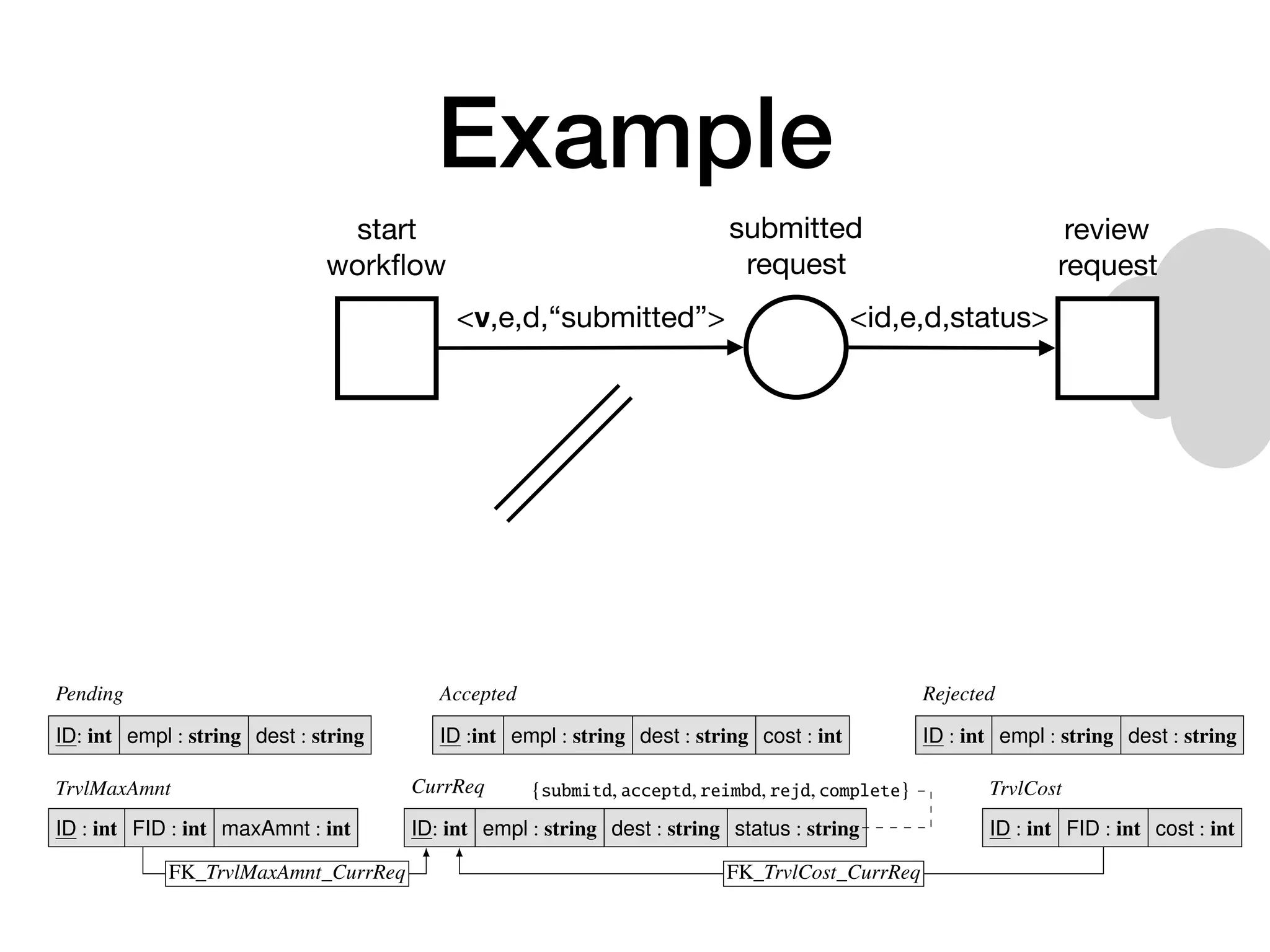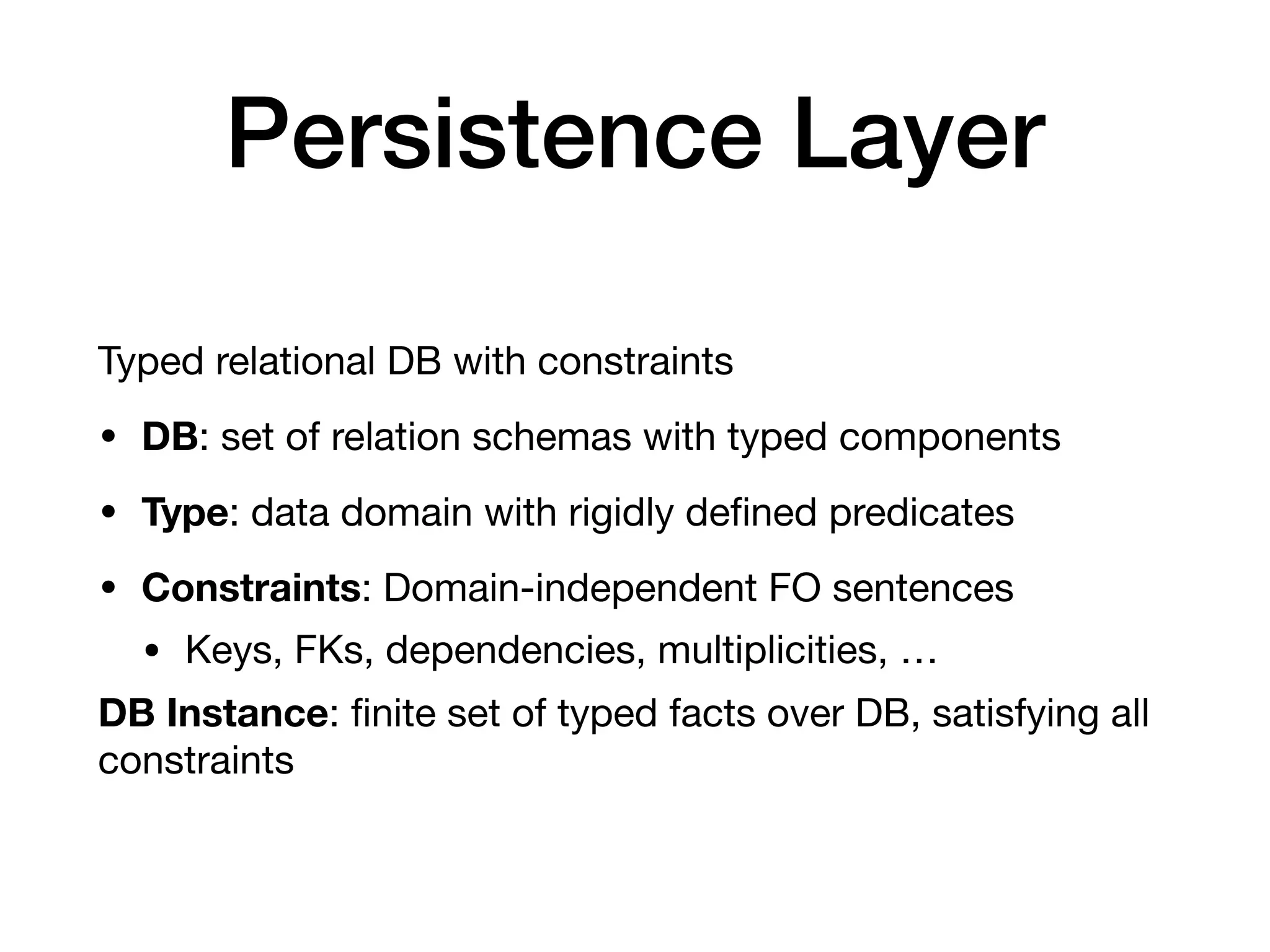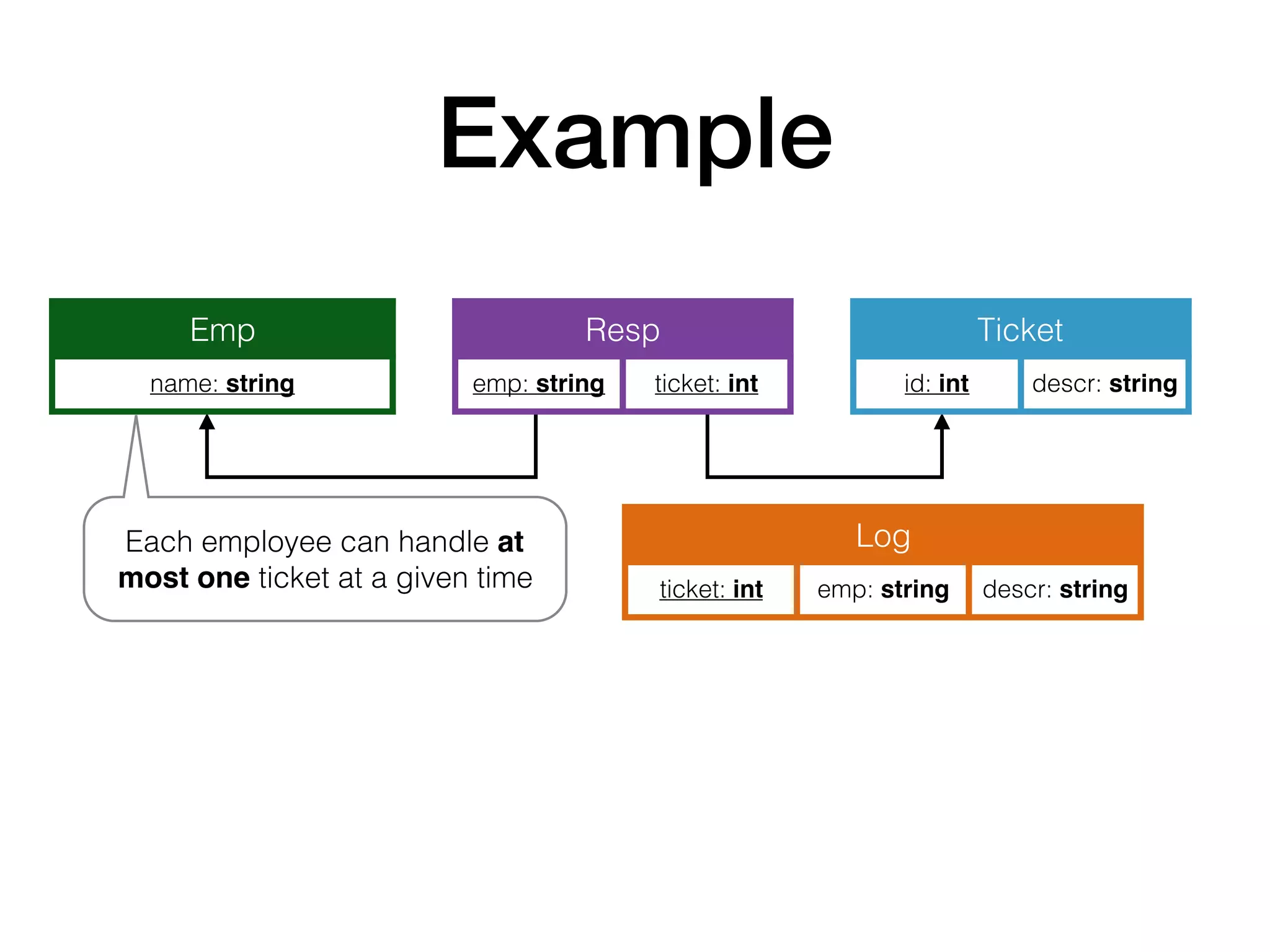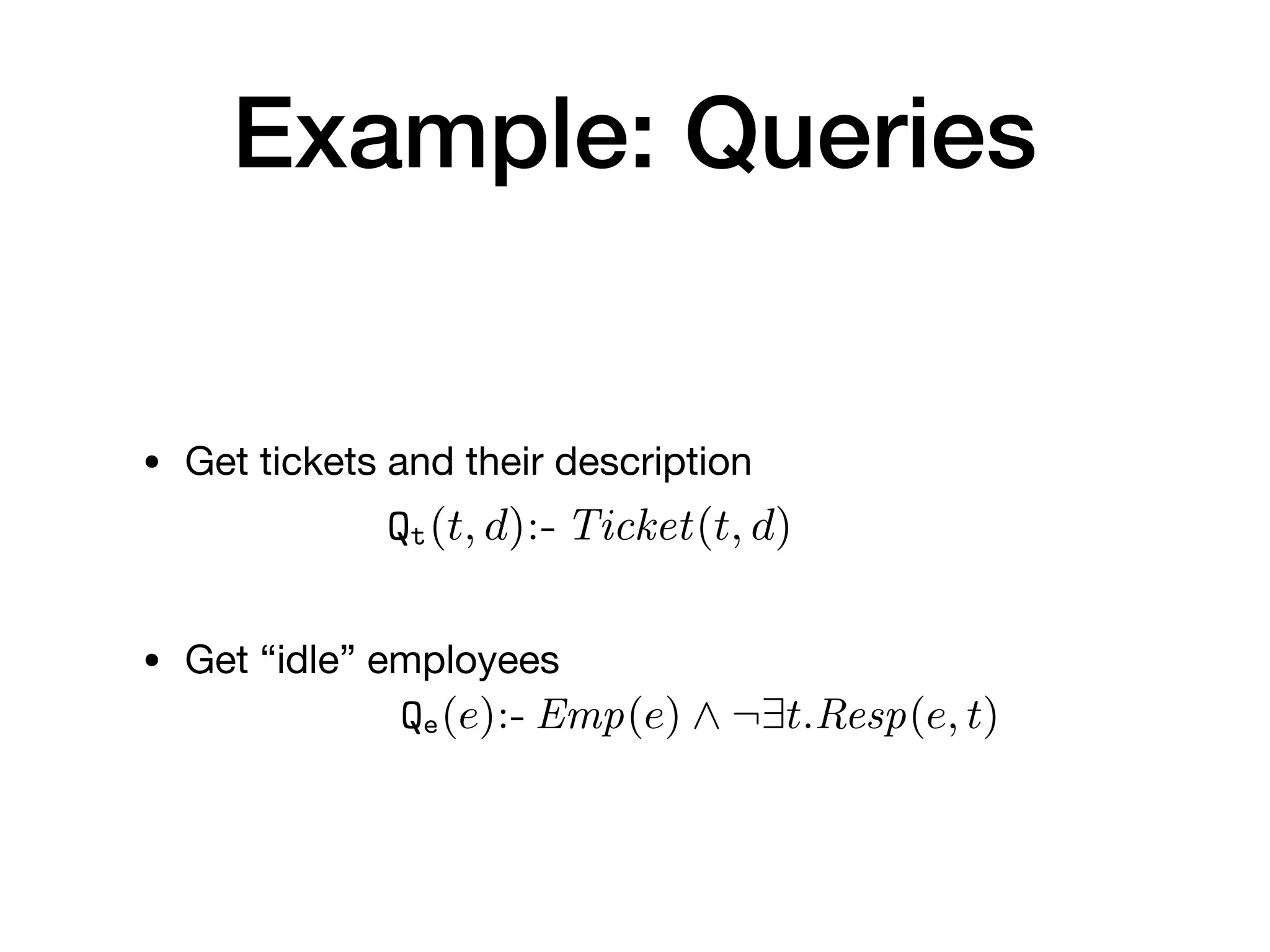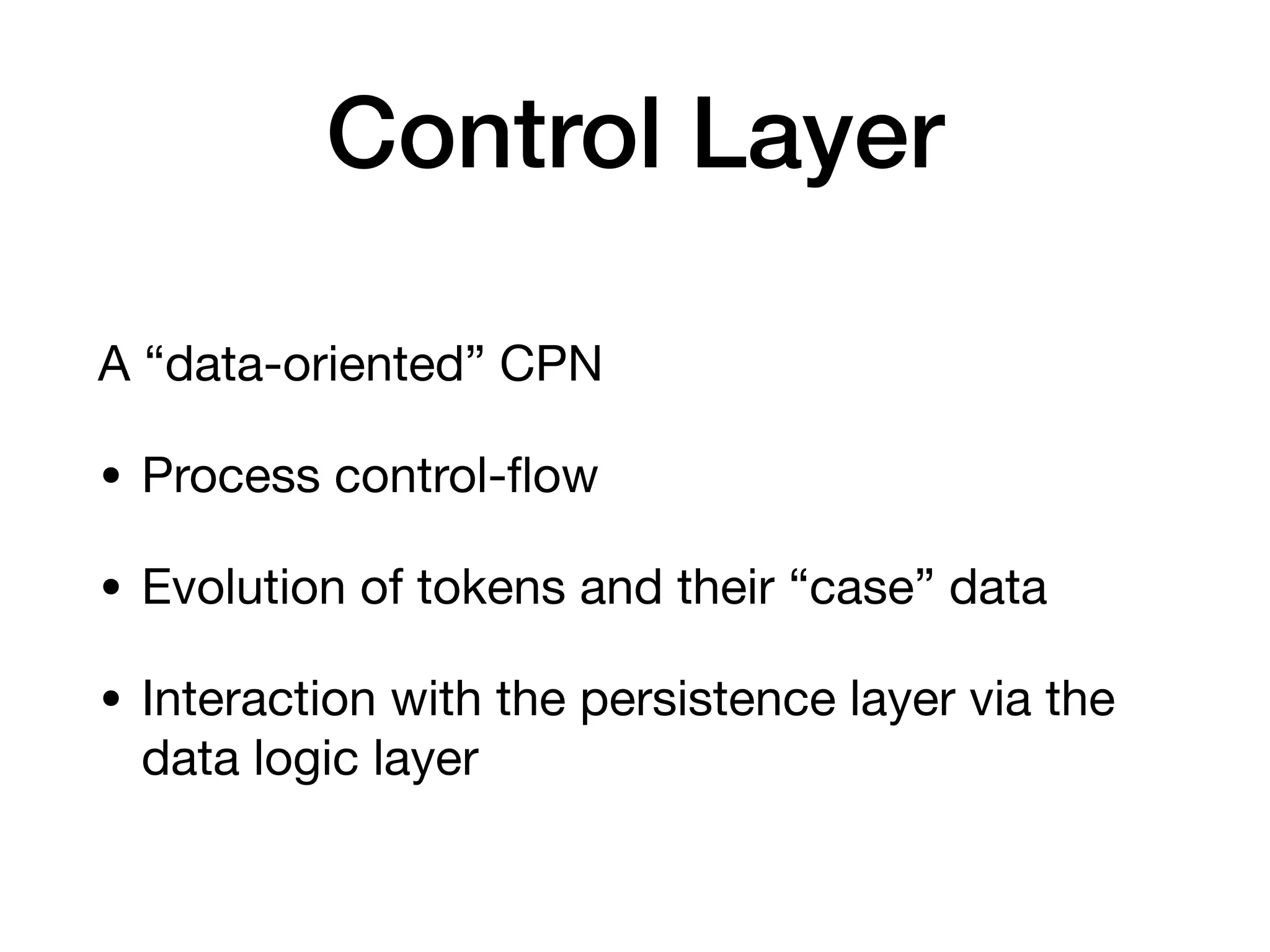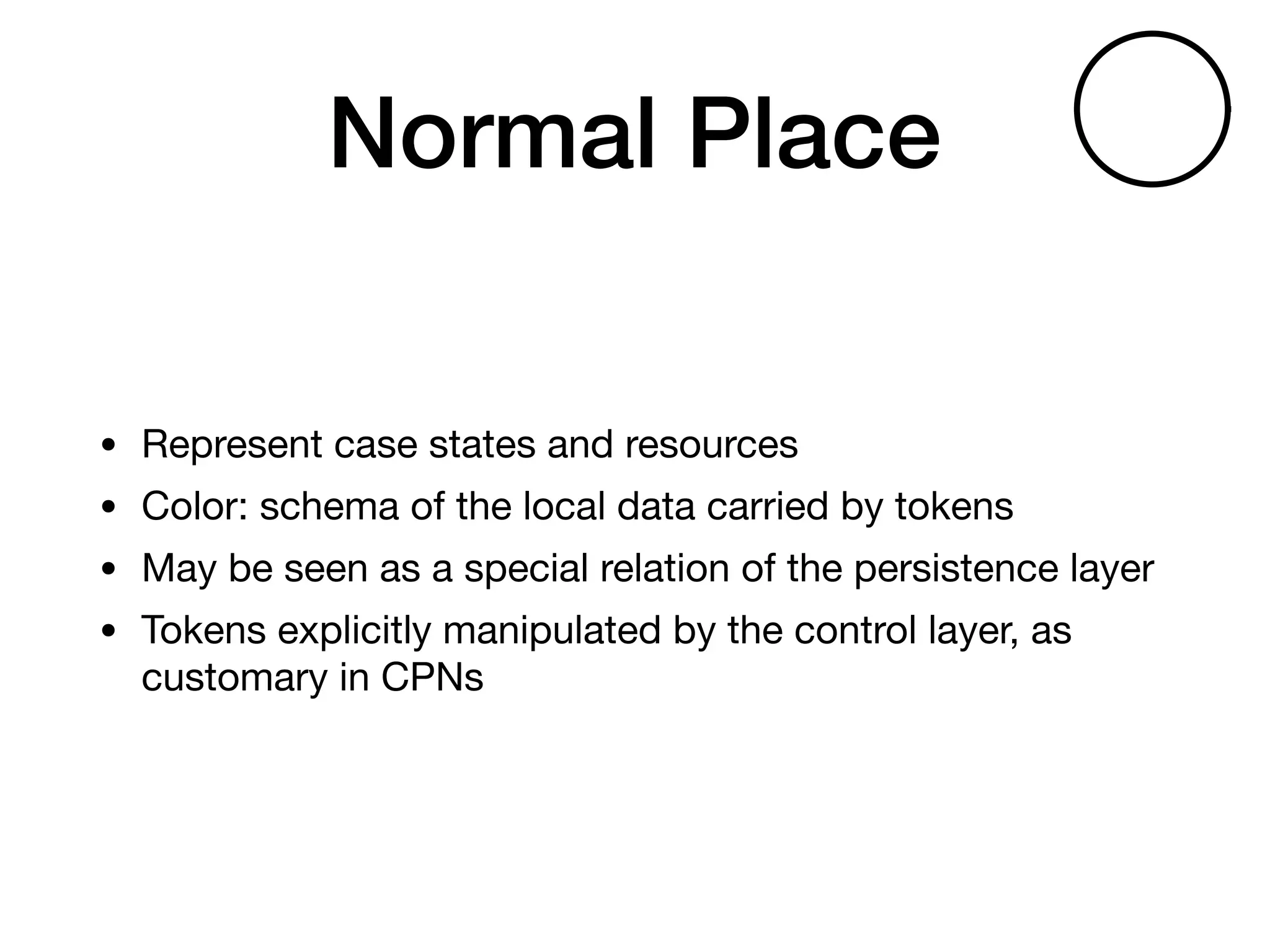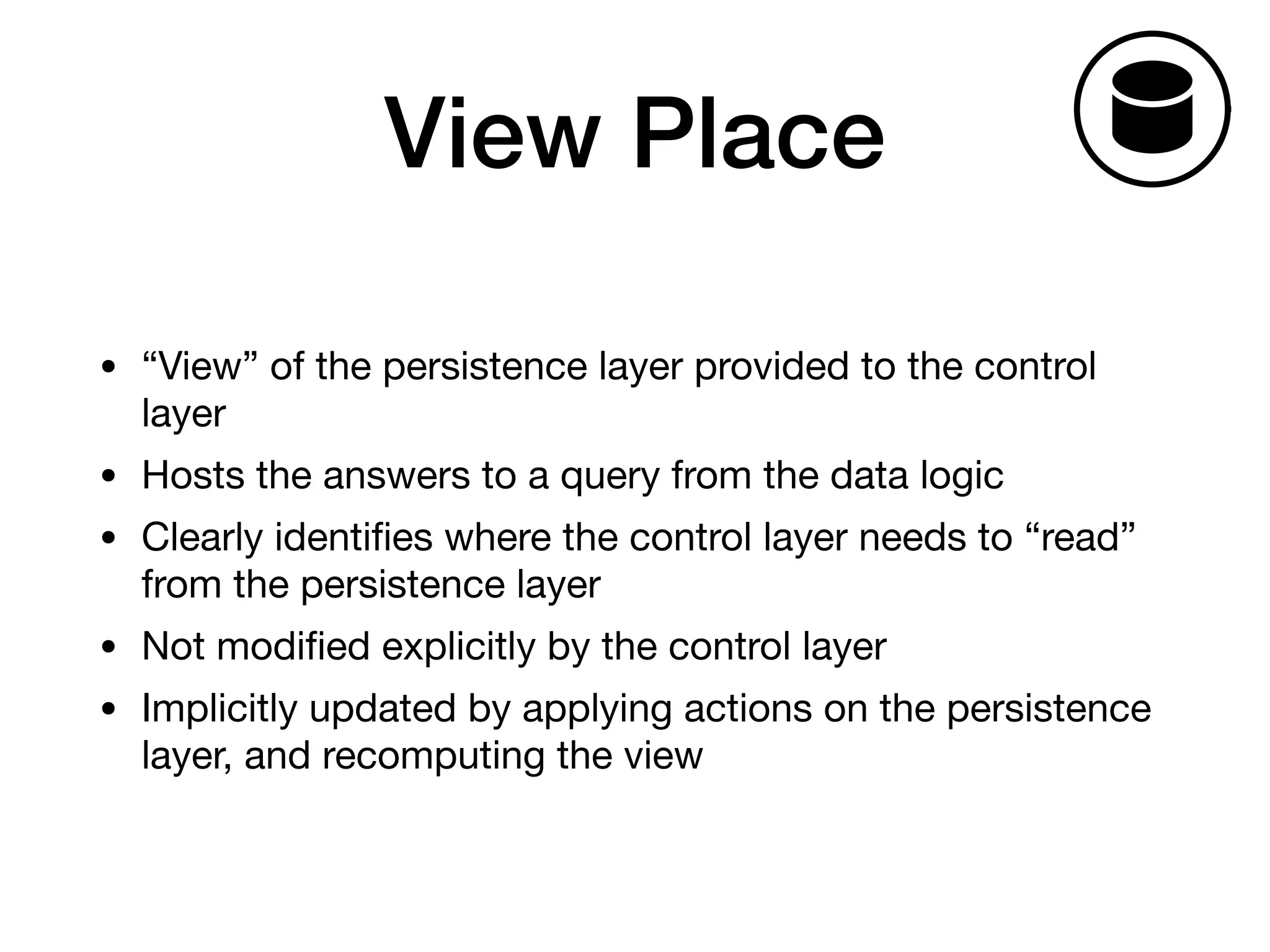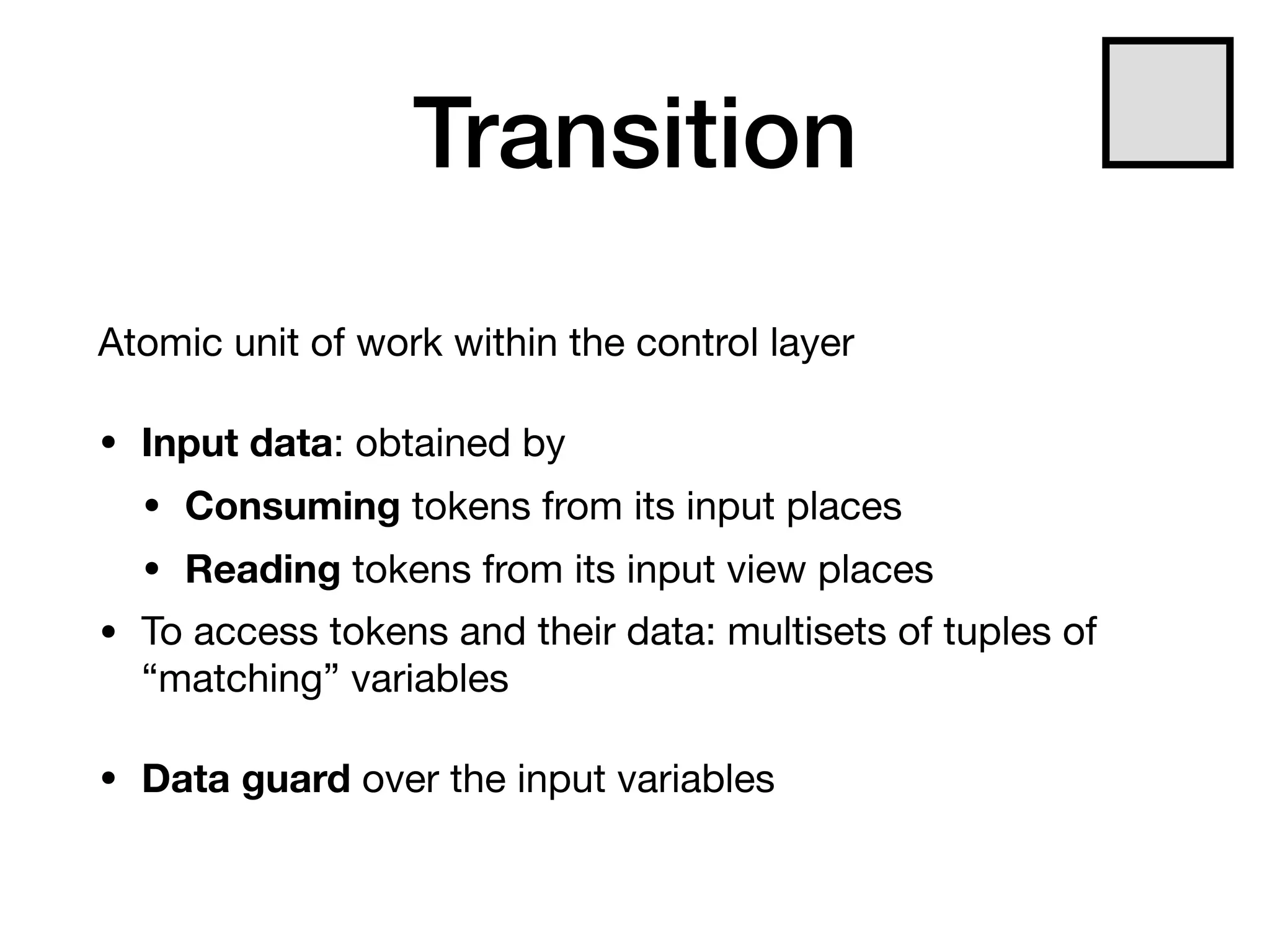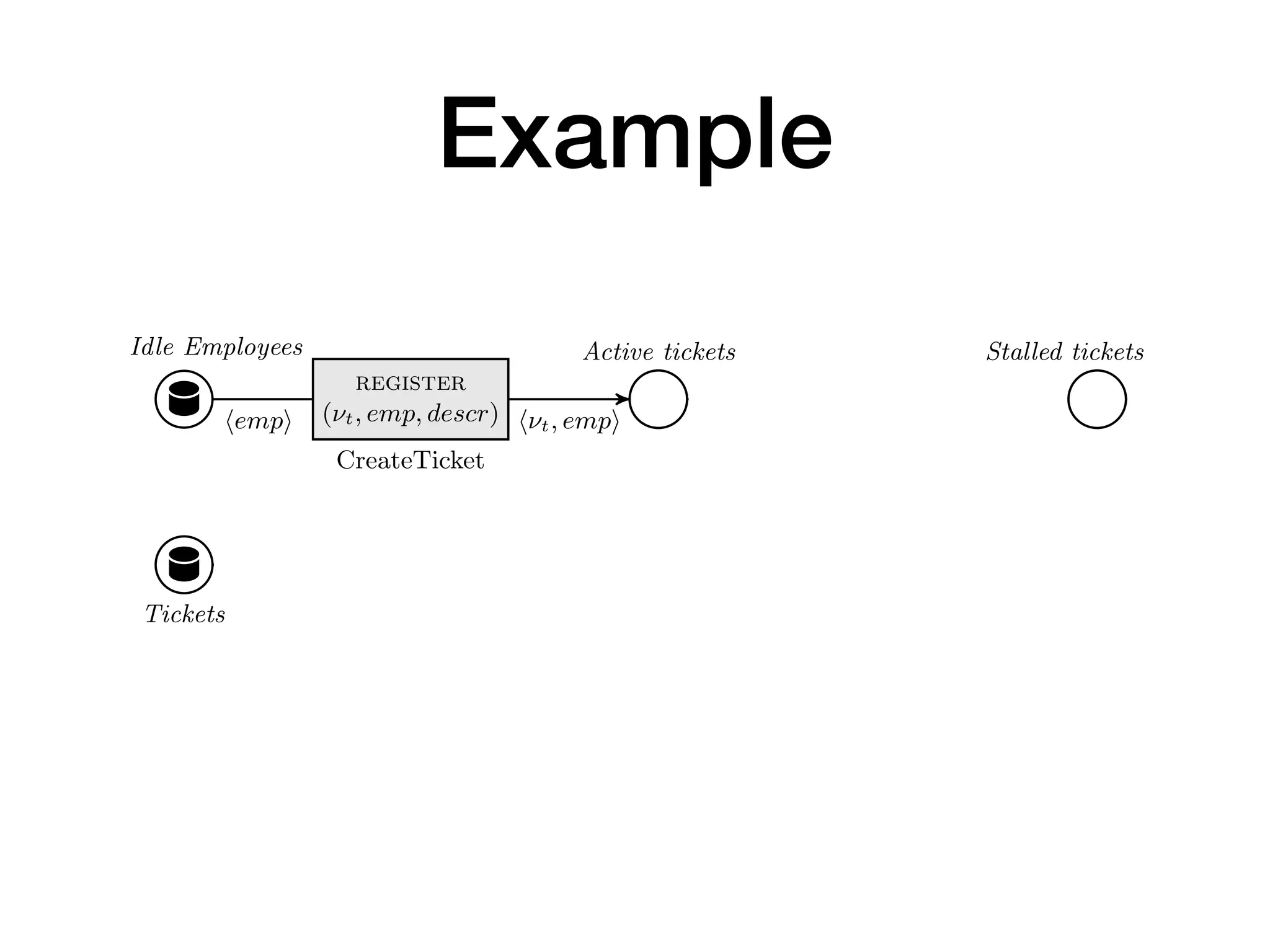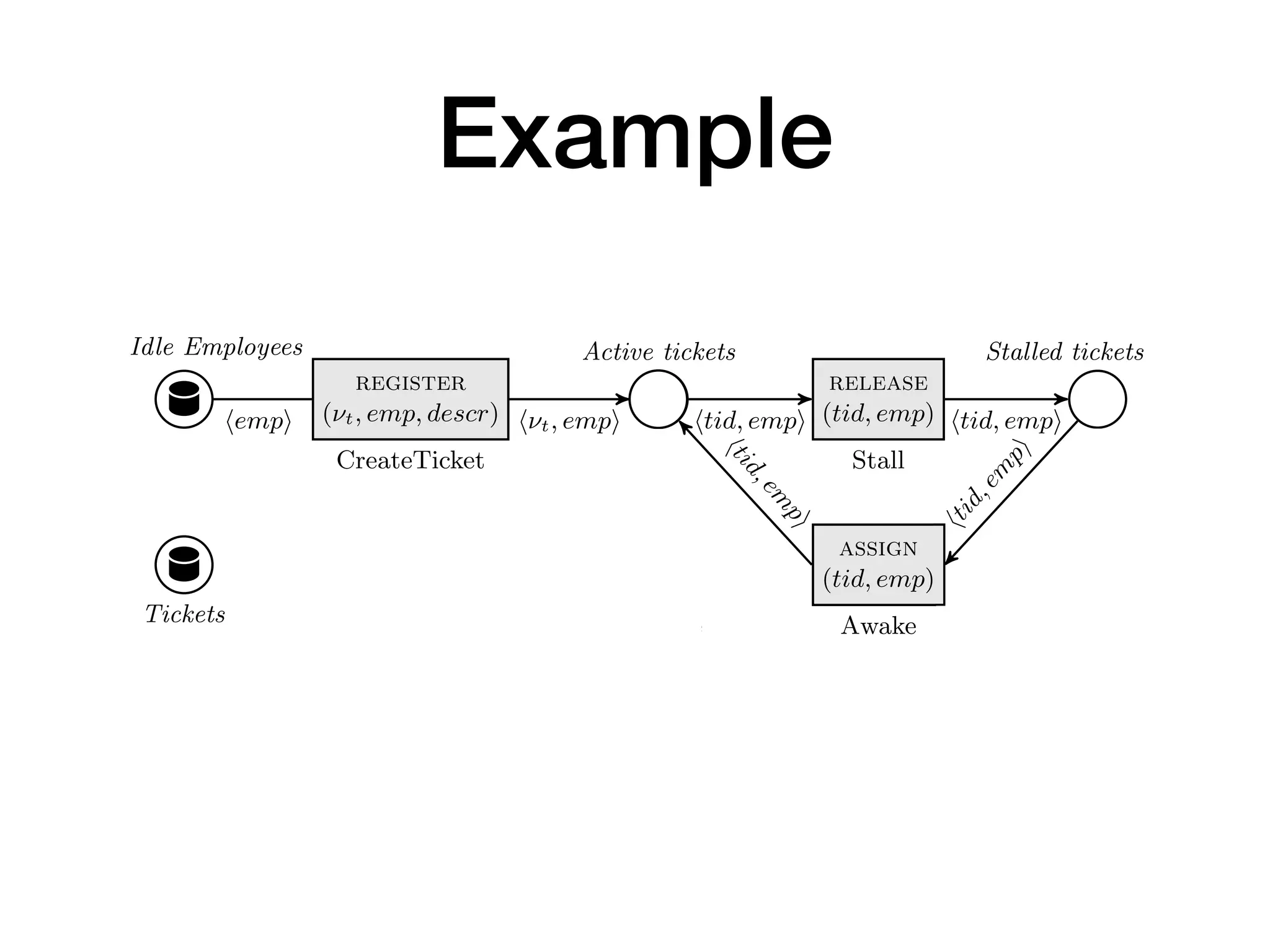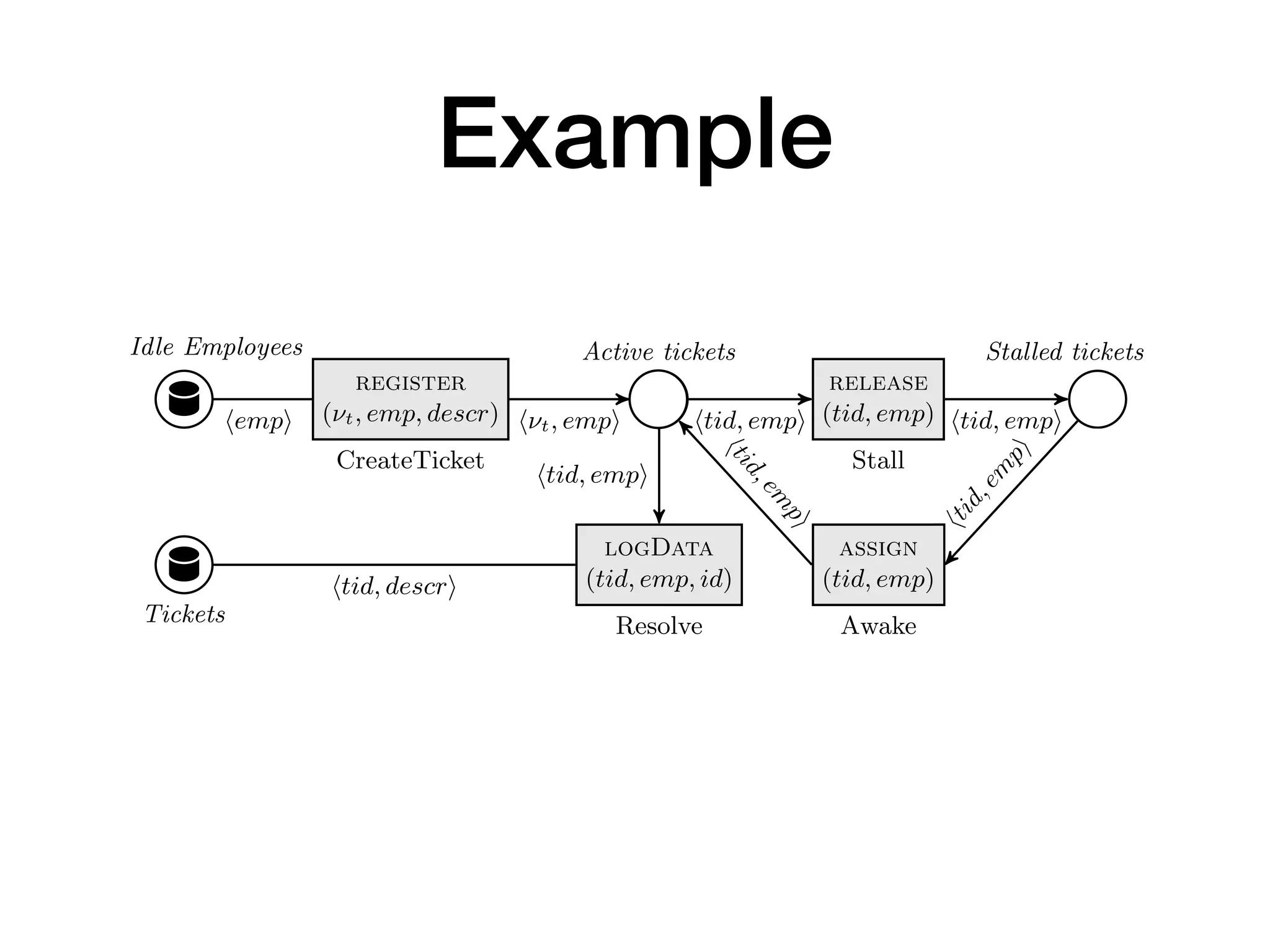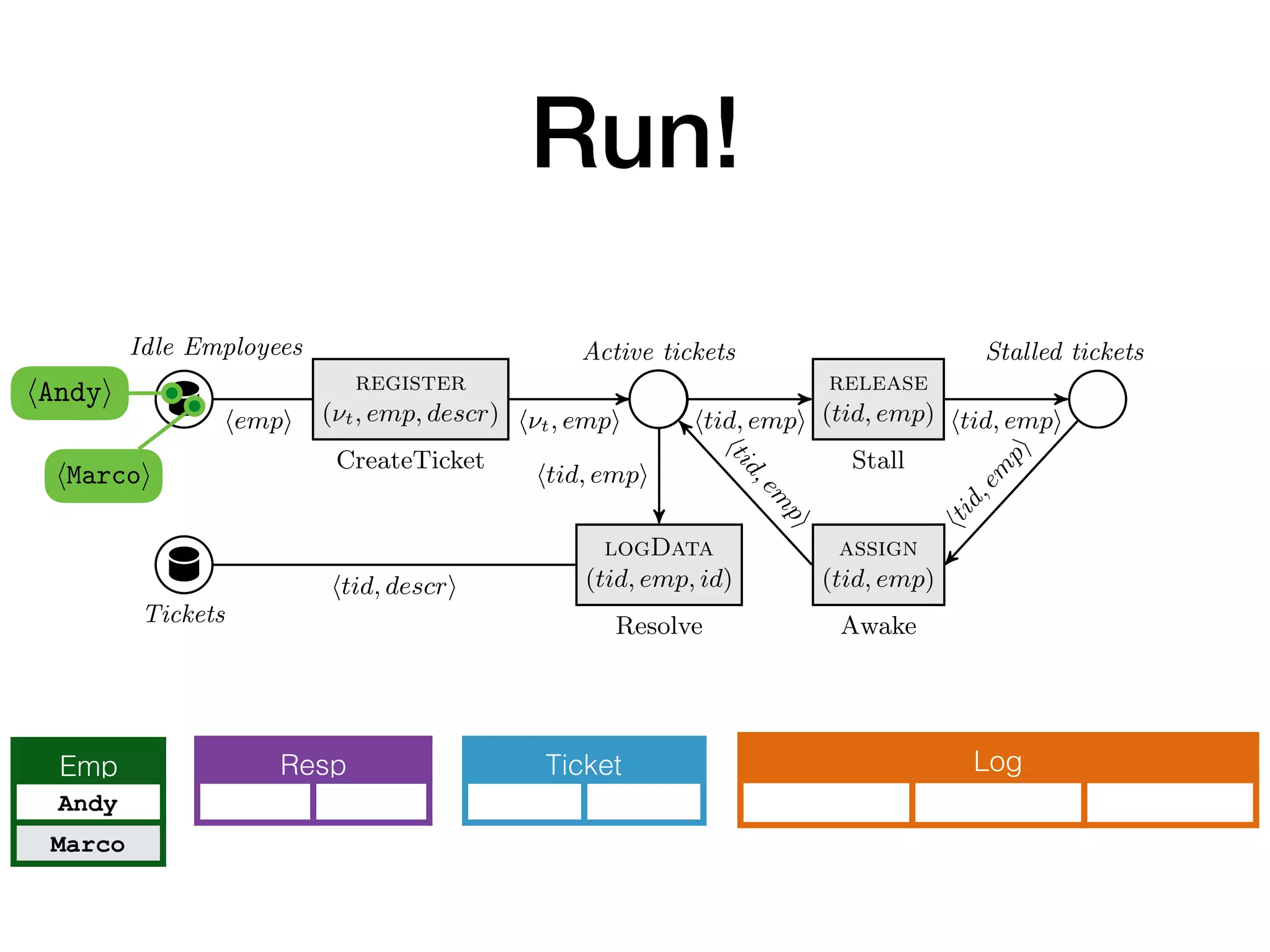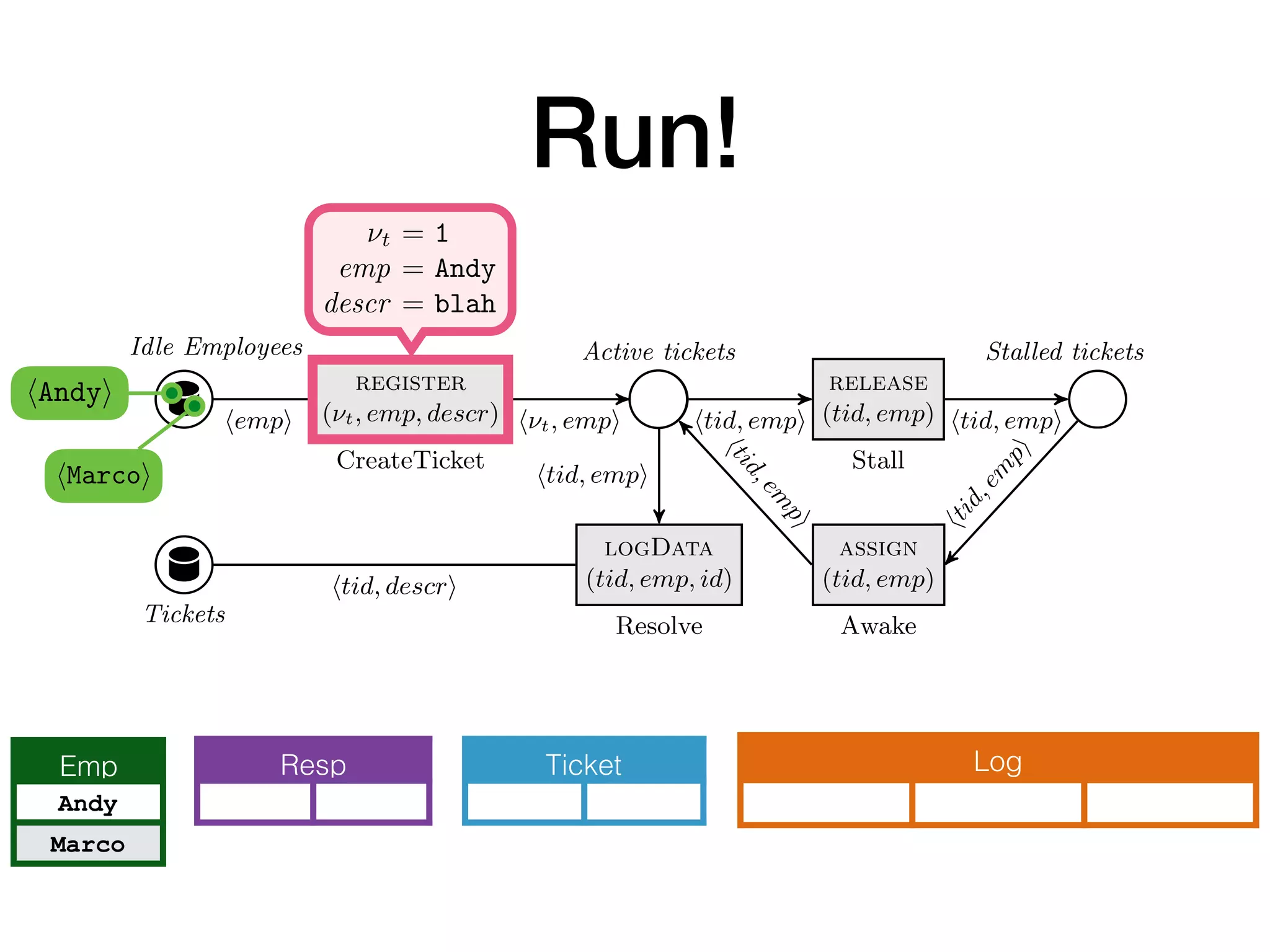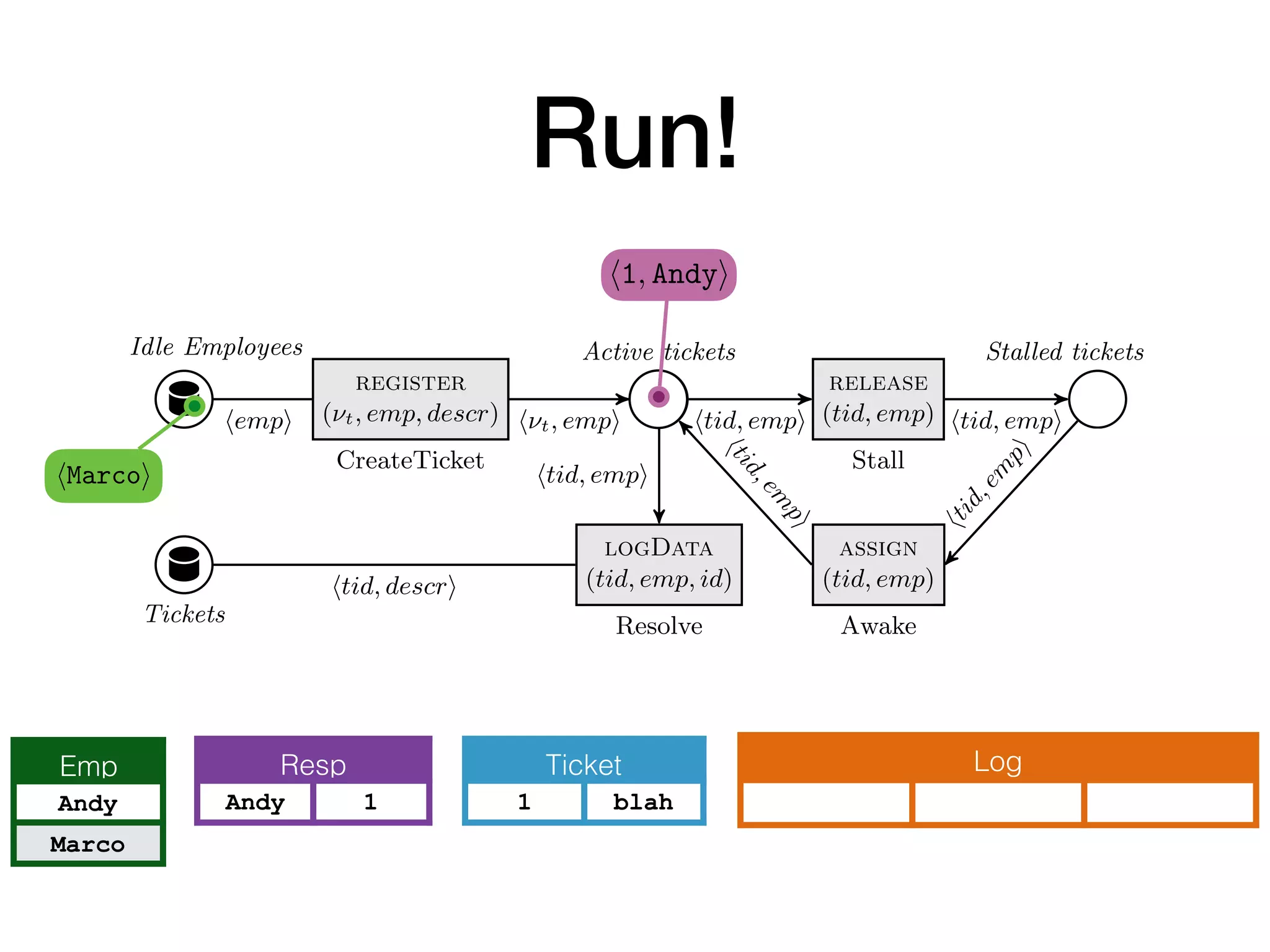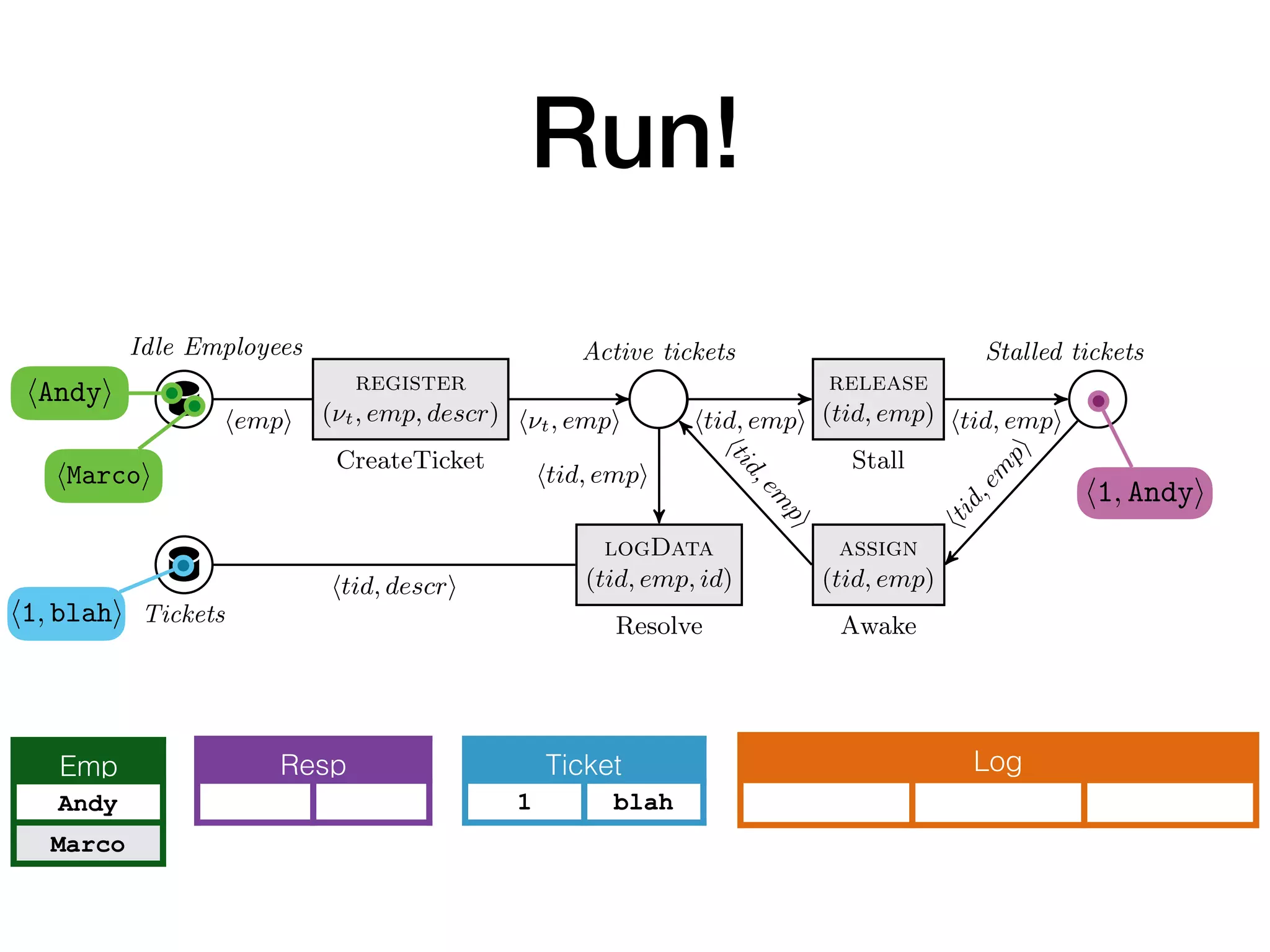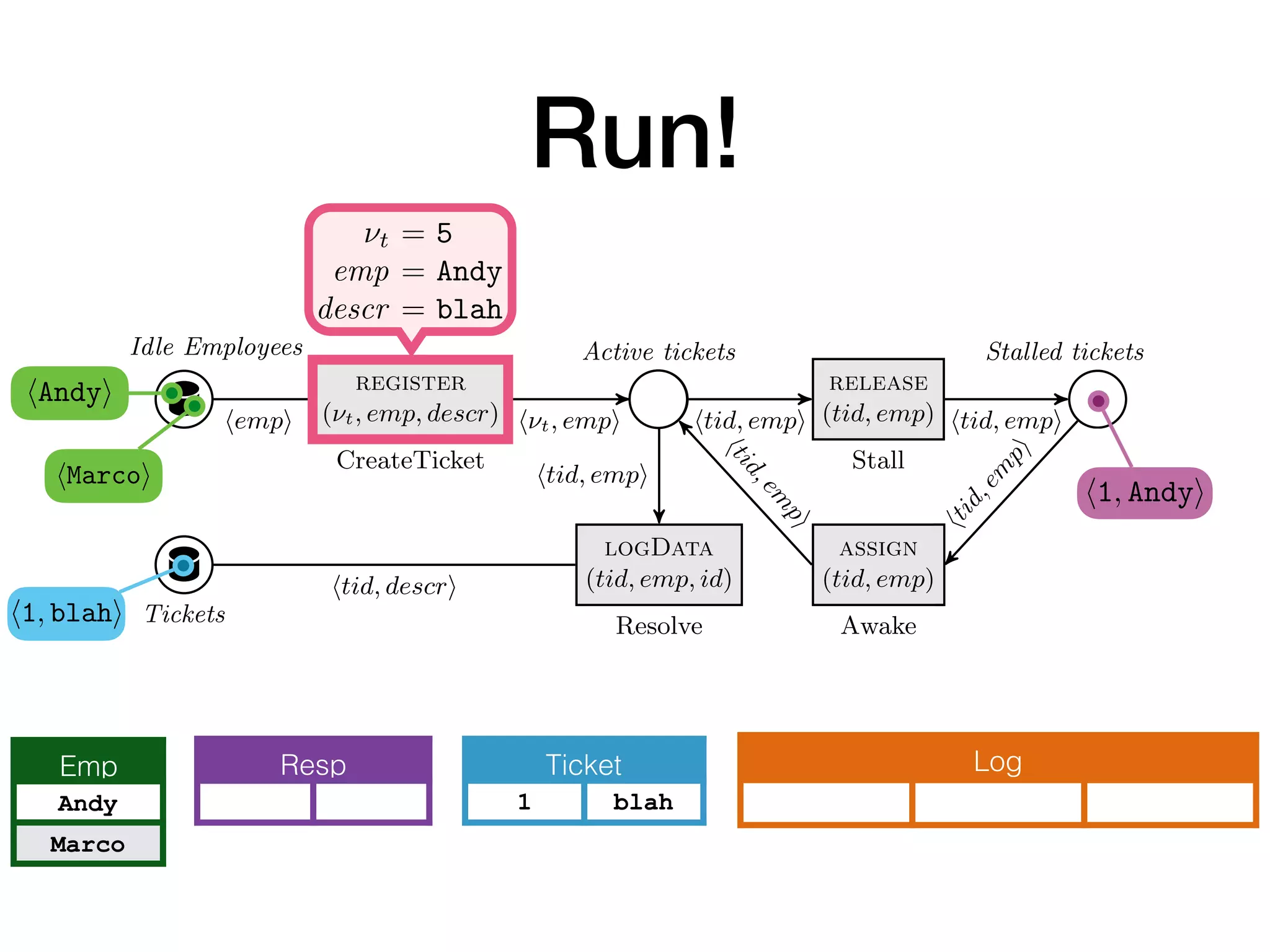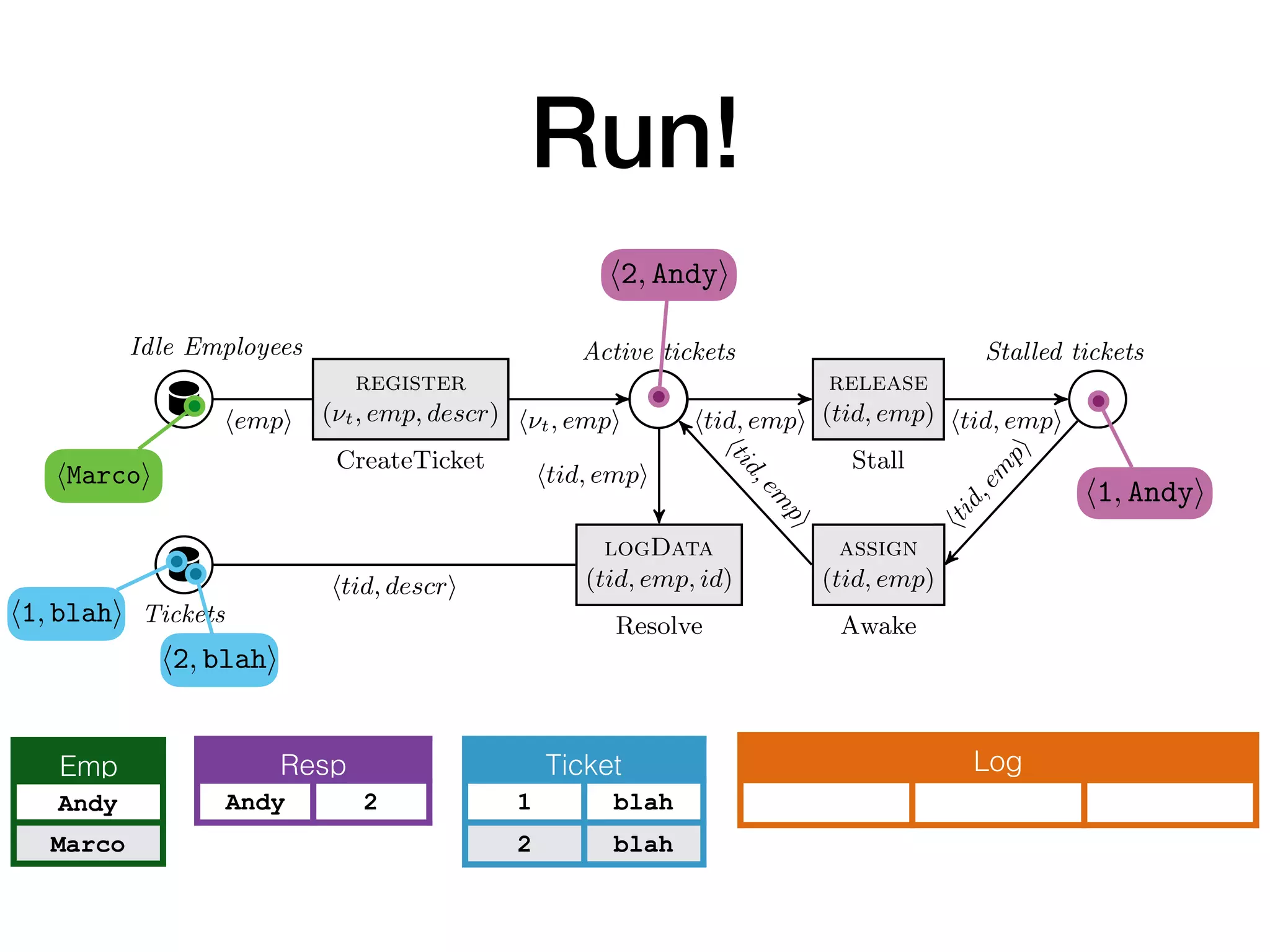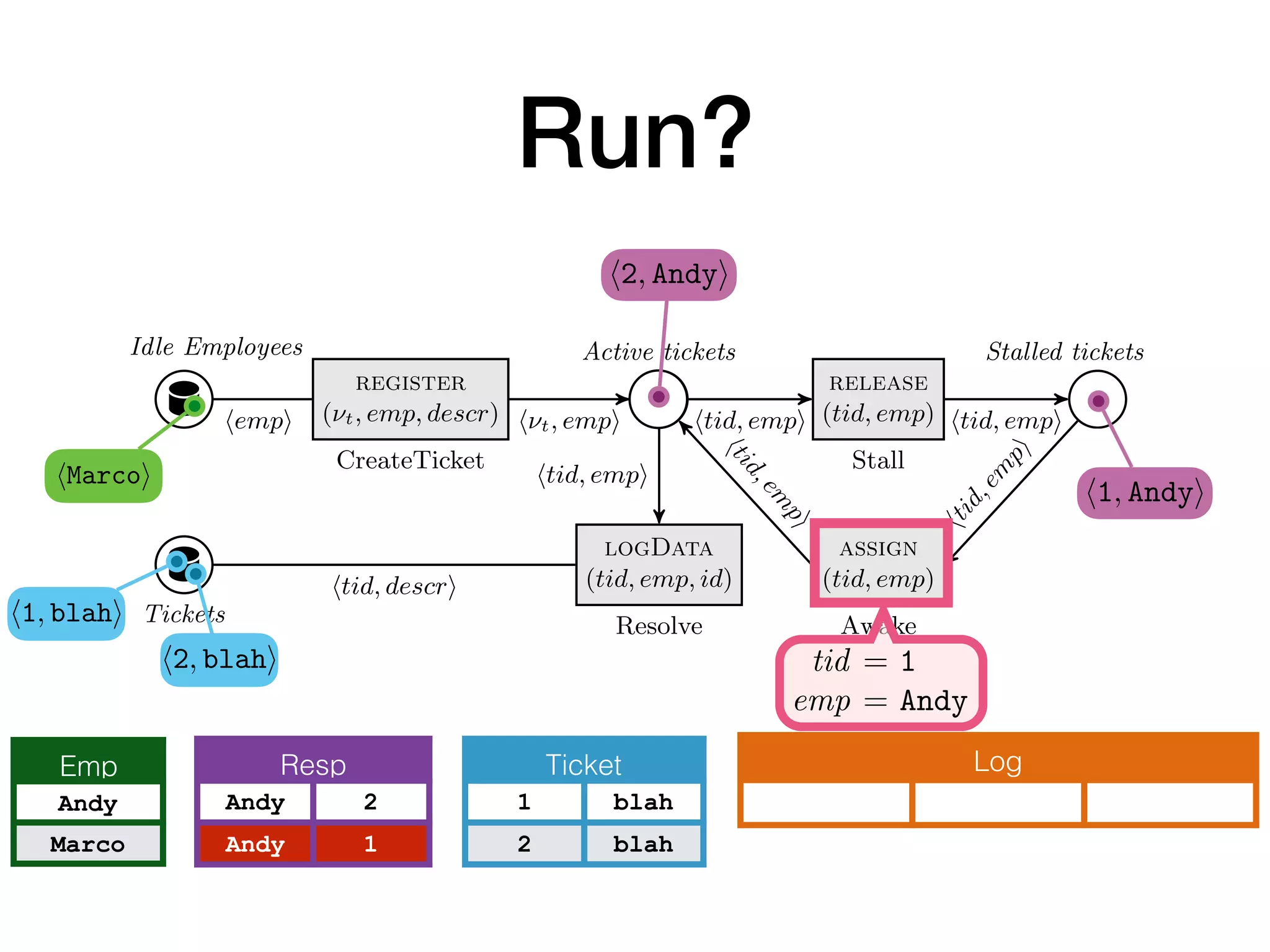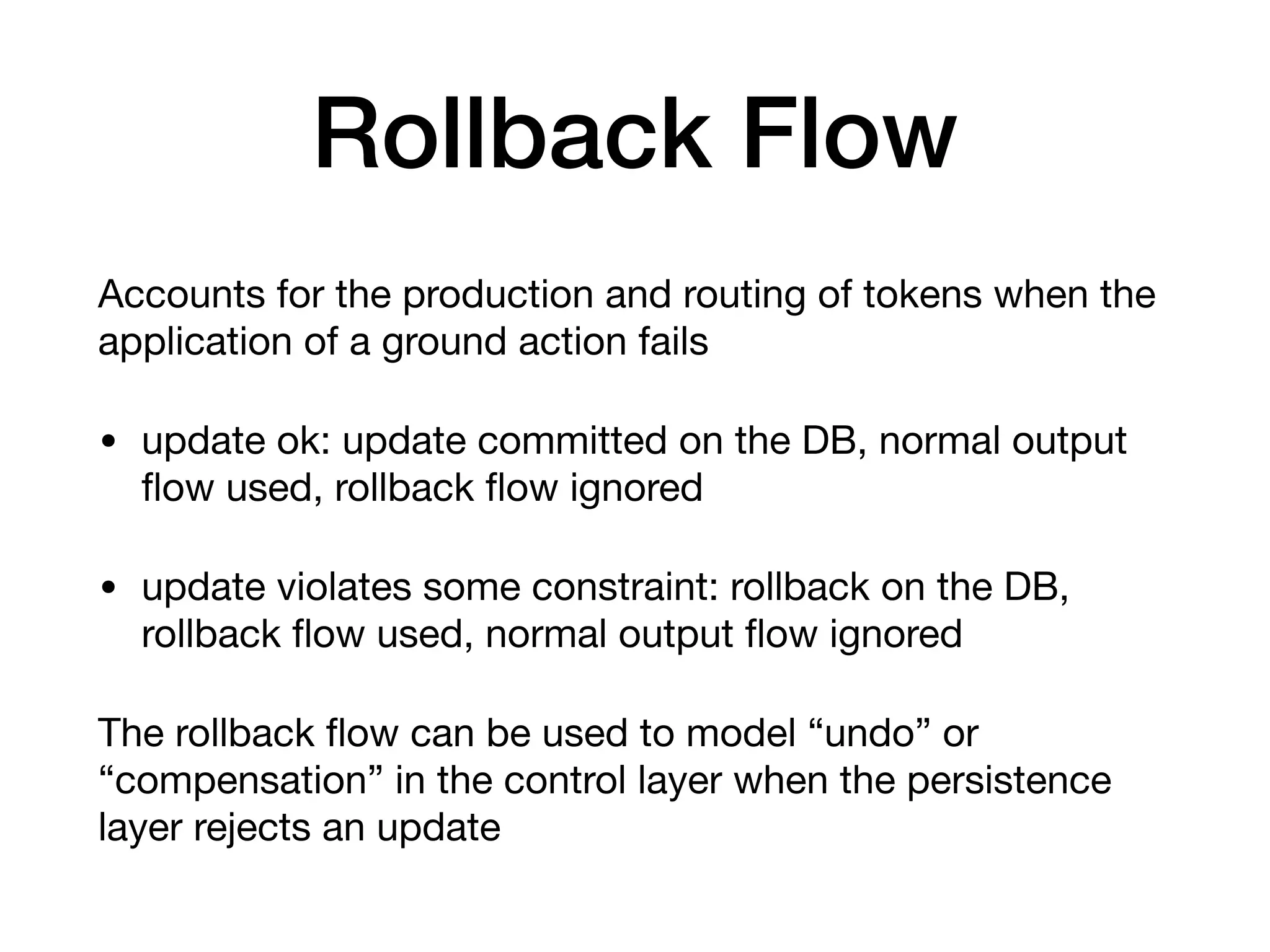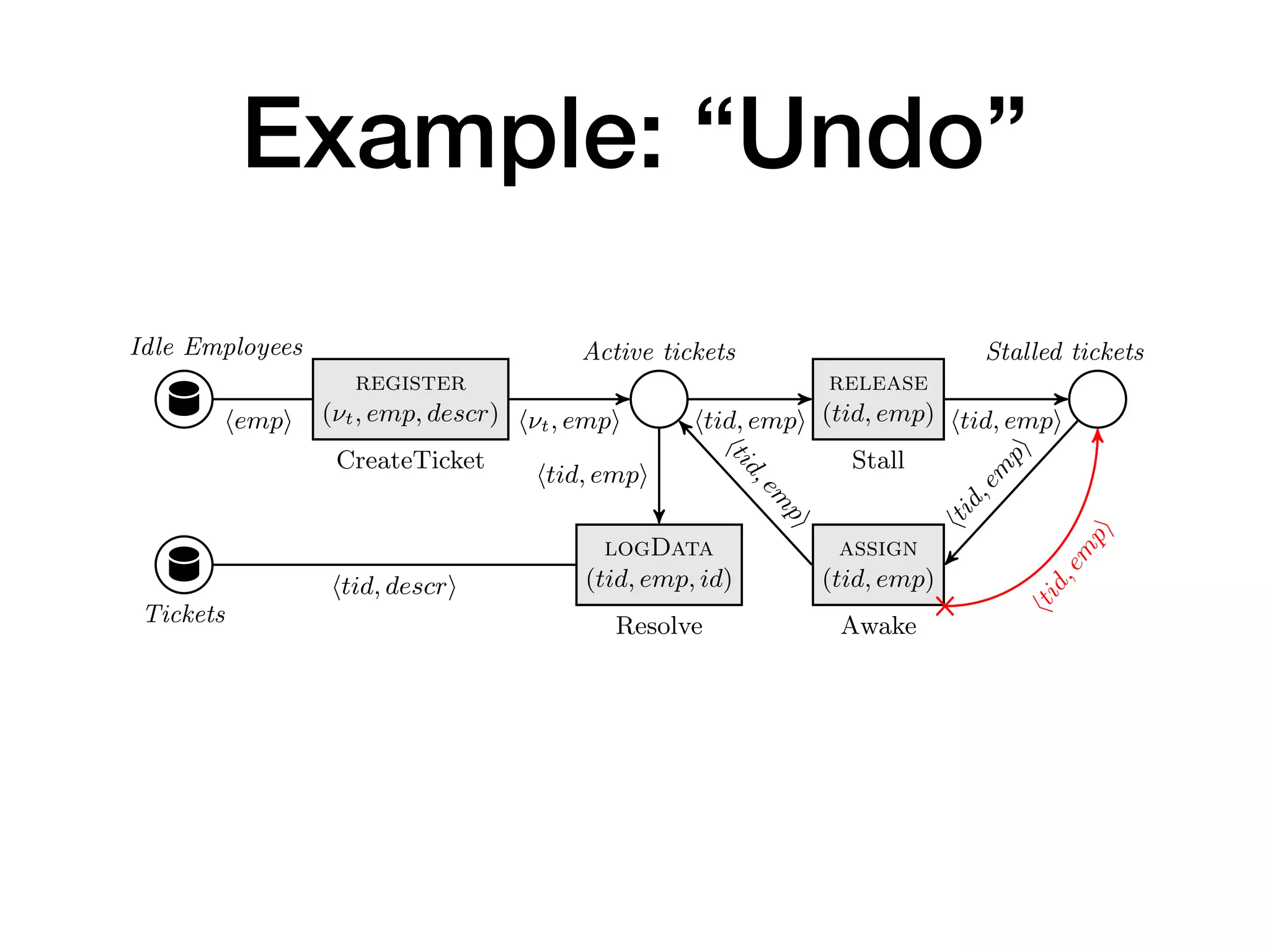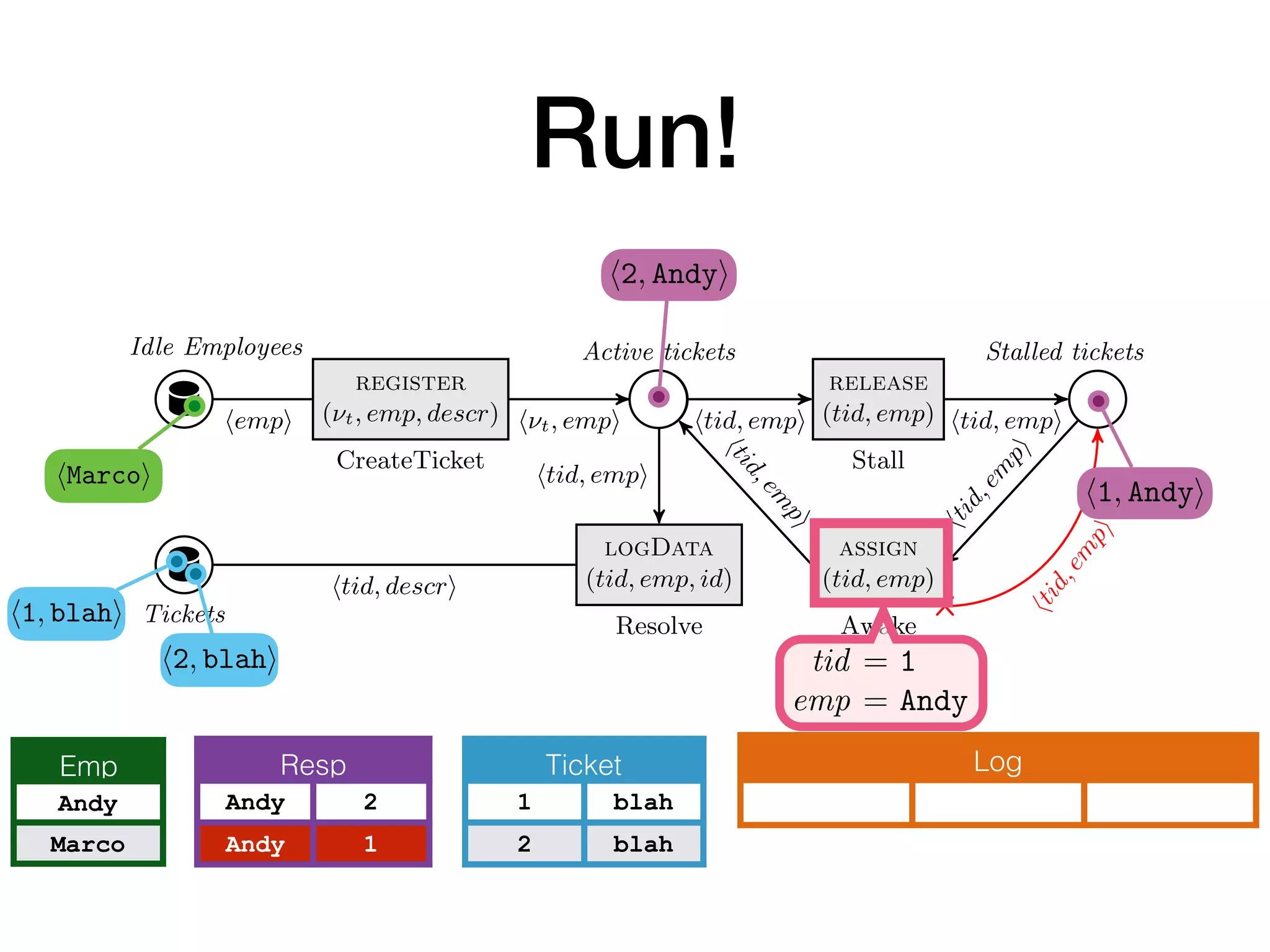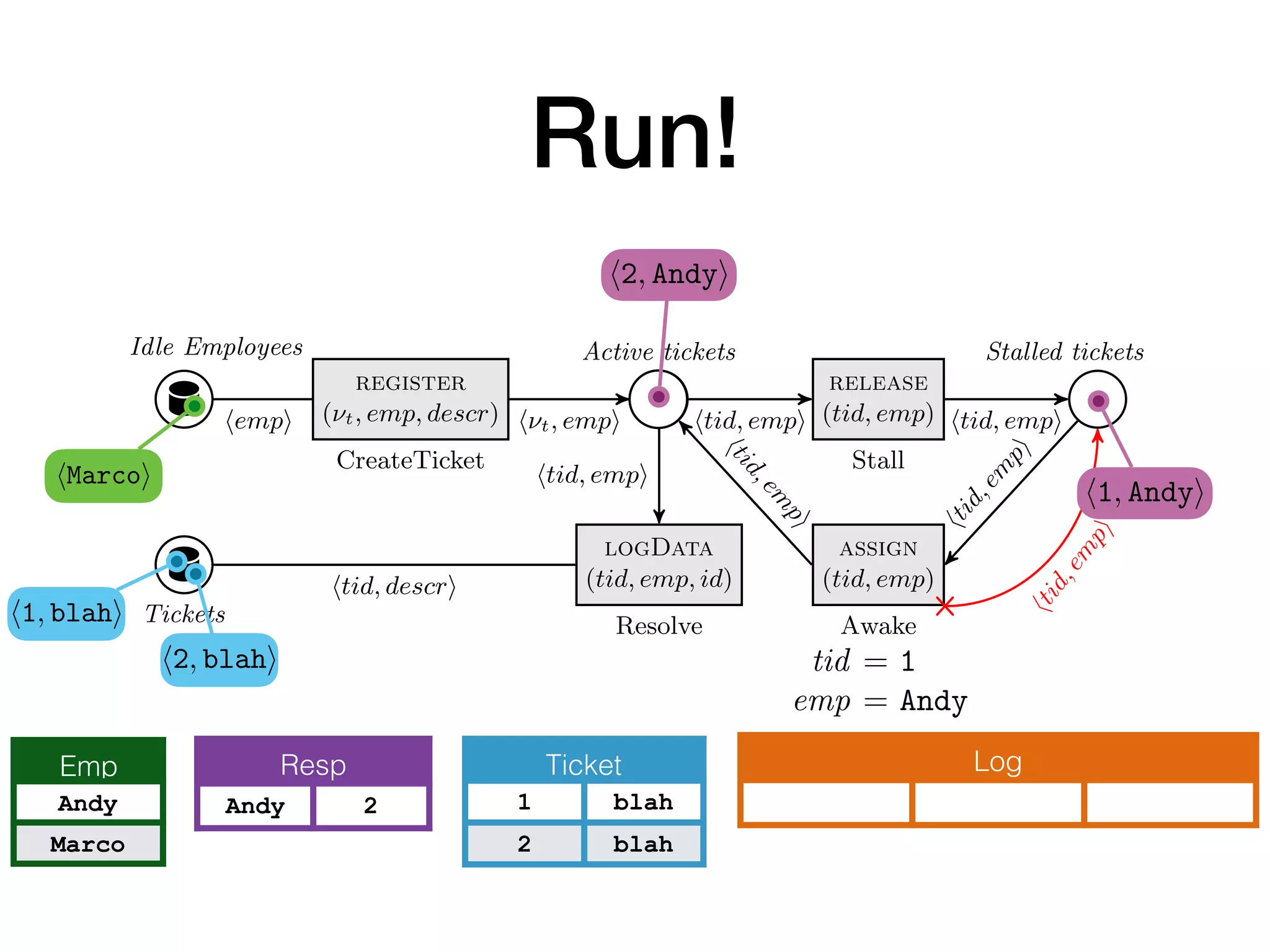This document discusses data-aware business processes and data-centric process modeling. It introduces data-centric dynamic systems (DCDSs) as a formal model for artifact-centric systems that uses a relational data layer and process layer to evolve the data. An example of a travel reimbursement process is used to illustrate DCDS modeling, including defining the data schema, modeling process actions that update the data, and showing an example execution. Automated enactment and verification of DCDS models is also discussed.

![2
Management
[models]
Workers
[reality]
Experience Dichotomy](https://image.slidesharecdn.com/cooking-data-processes-tue-feb-2019-190520214845/75/Cooking-with-Data-and-Processes-2-2048.jpg)
![3
Management Dichotomy
Business
[decision making]
IT
[infrastructure]](https://image.slidesharecdn.com/cooking-data-processes-tue-feb-2019-190520214845/75/Cooking-with-Data-and-Processes-3-2048.jpg)
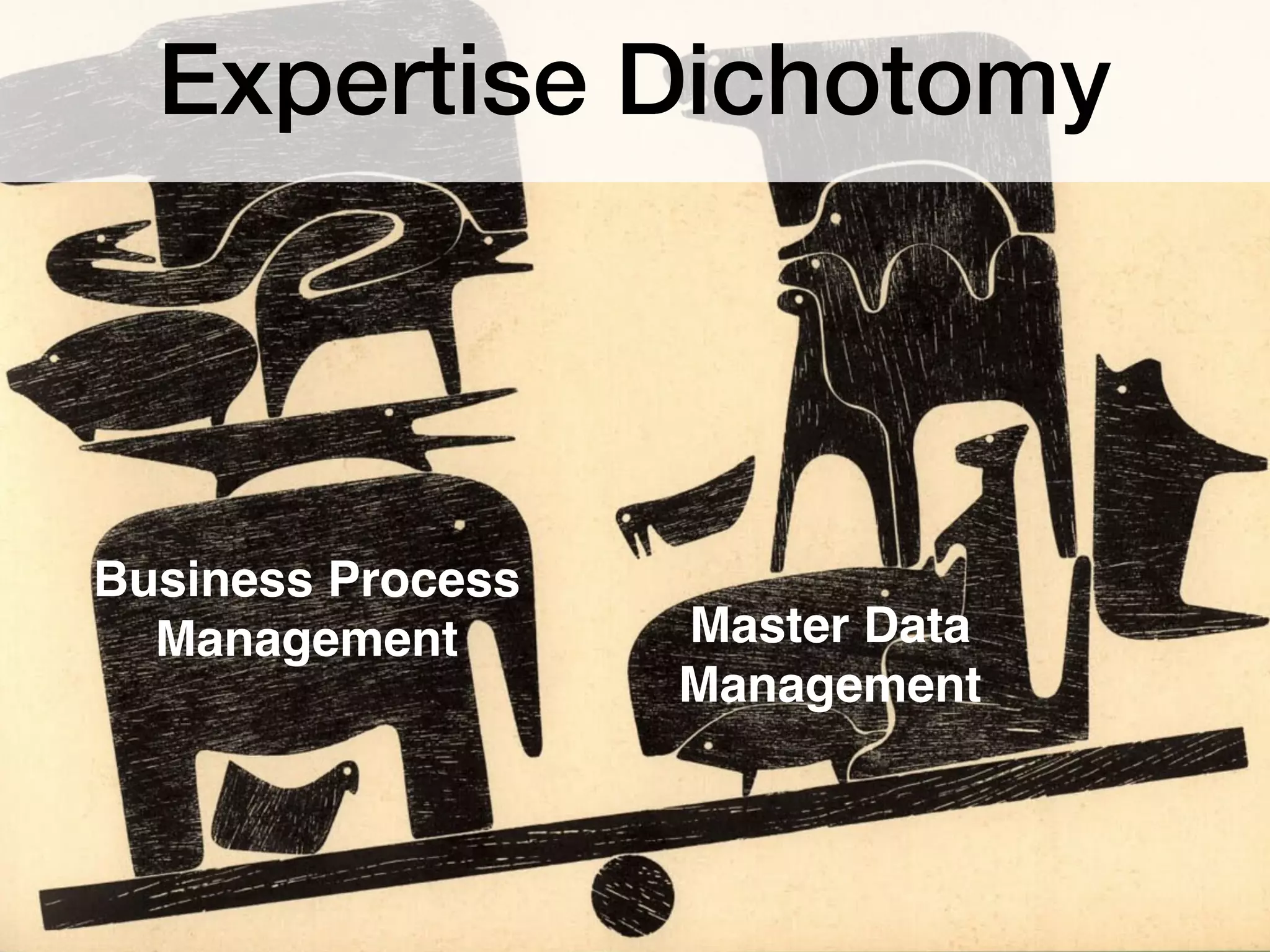
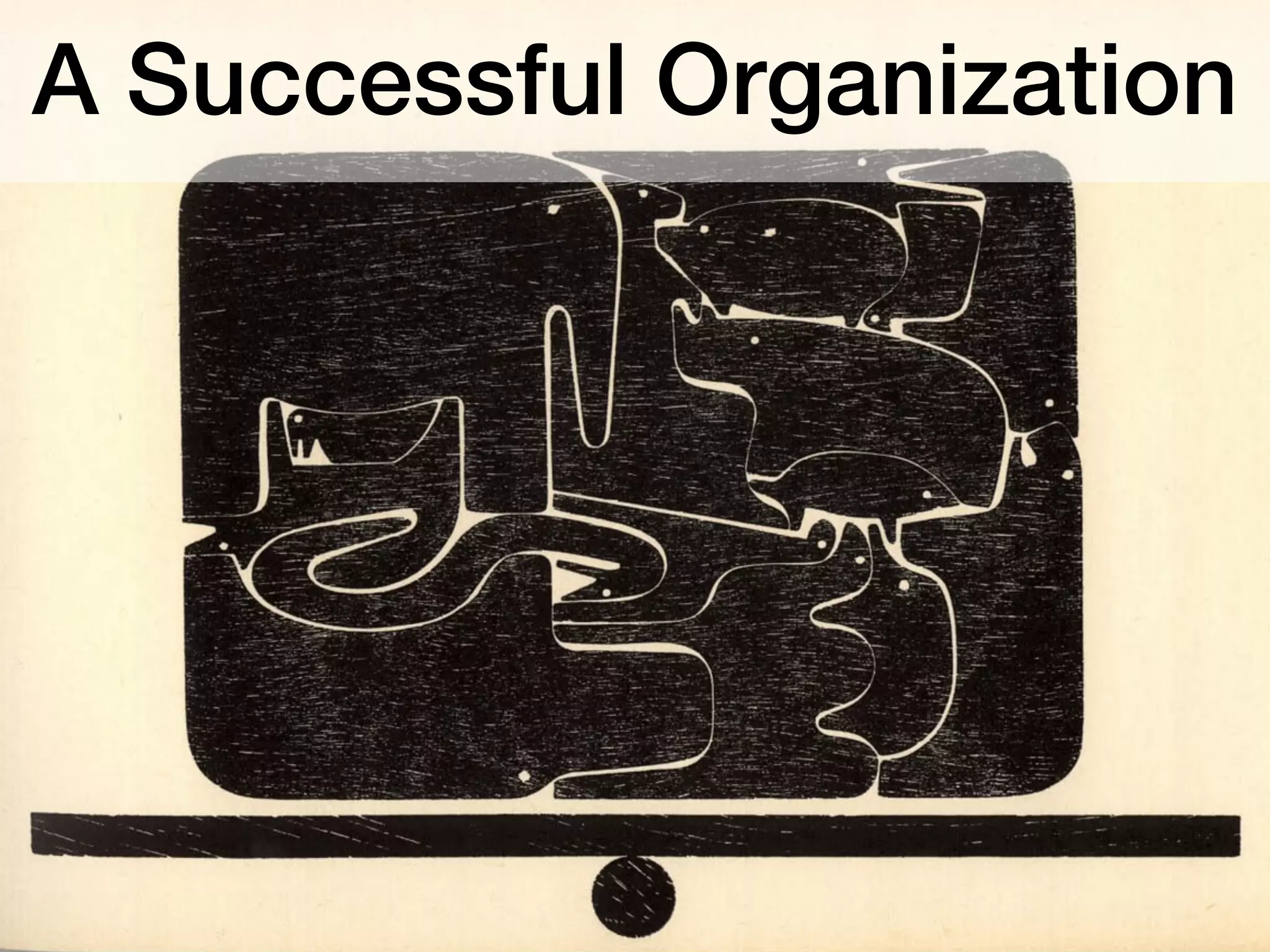
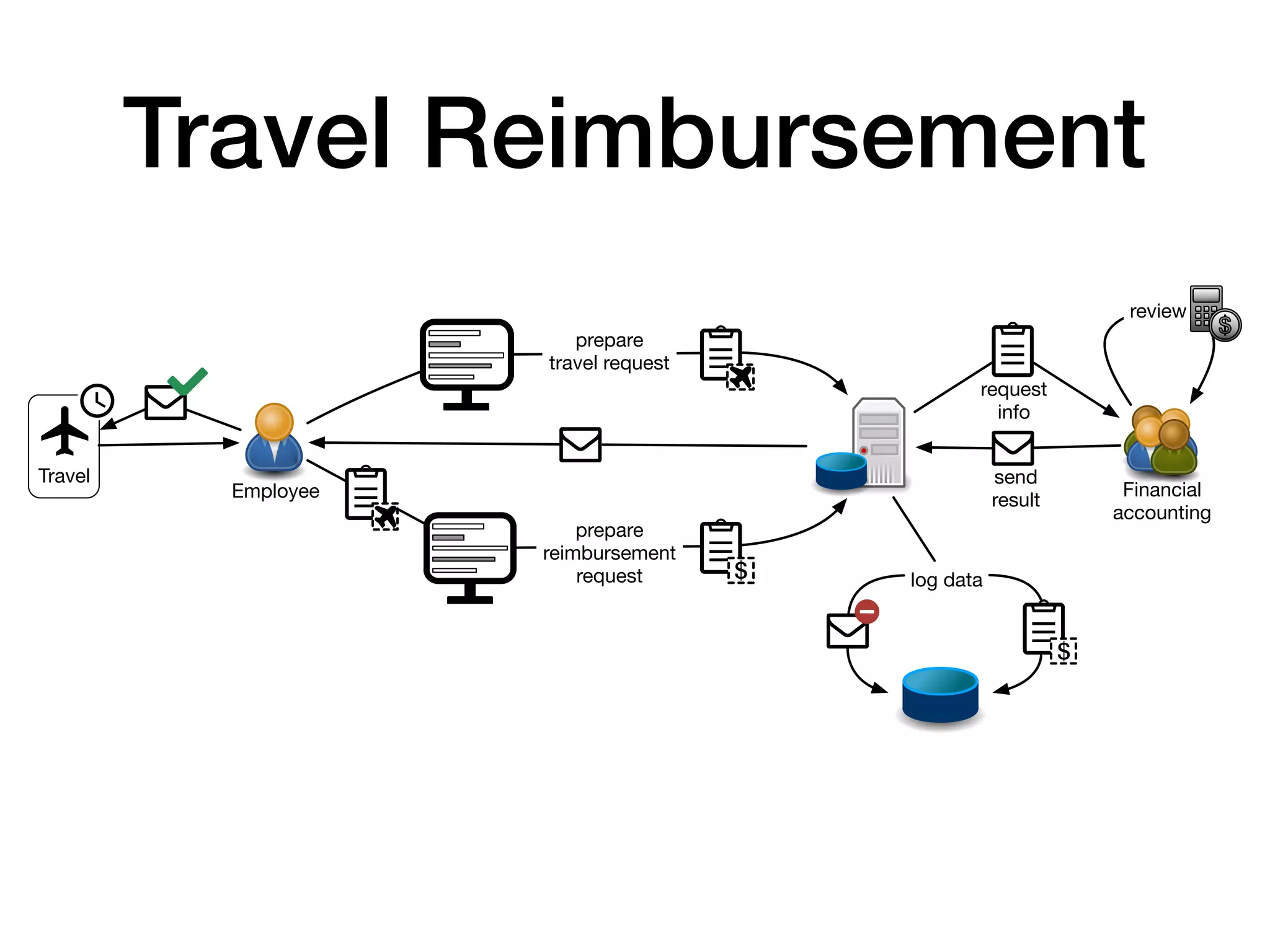

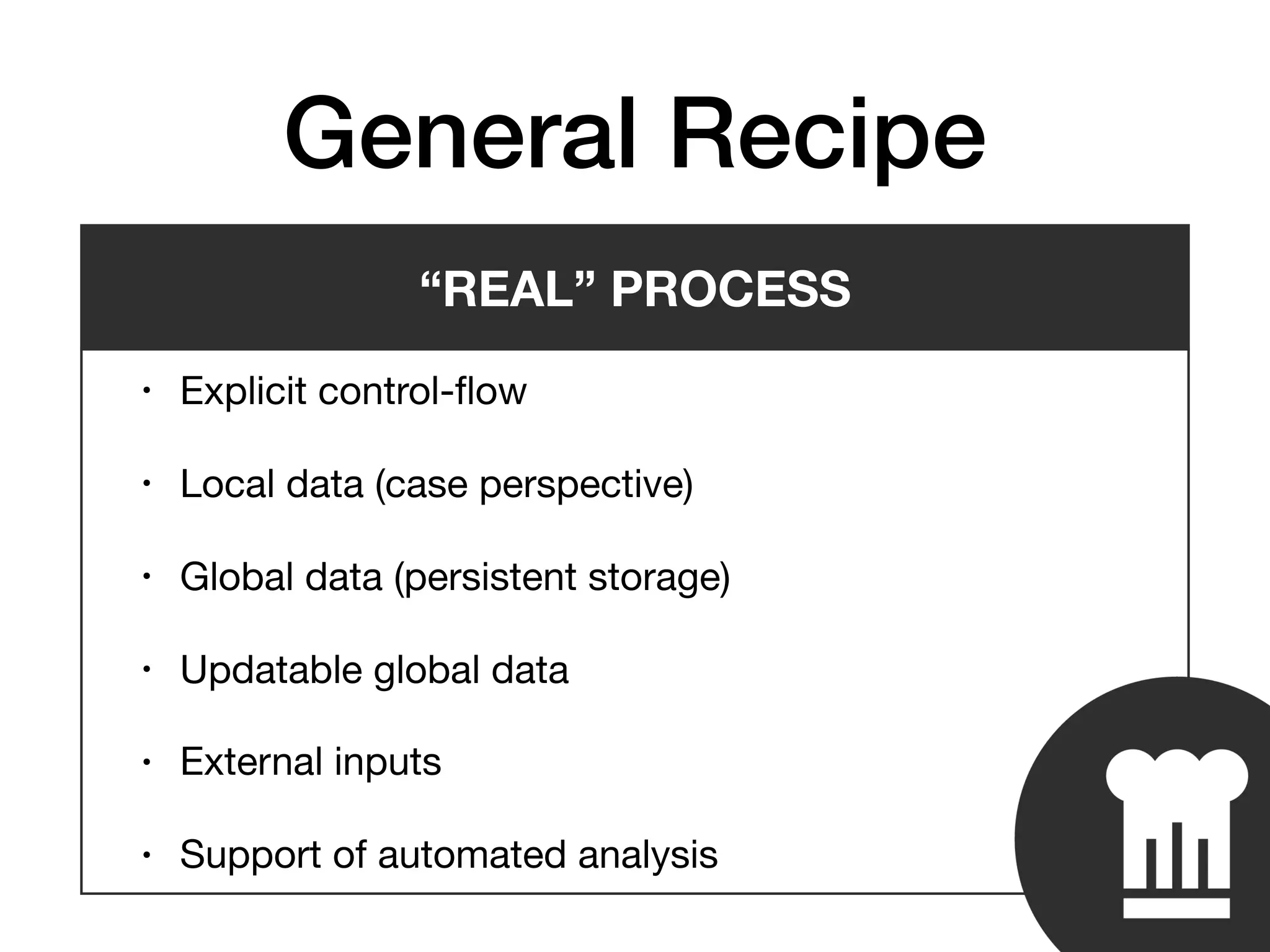
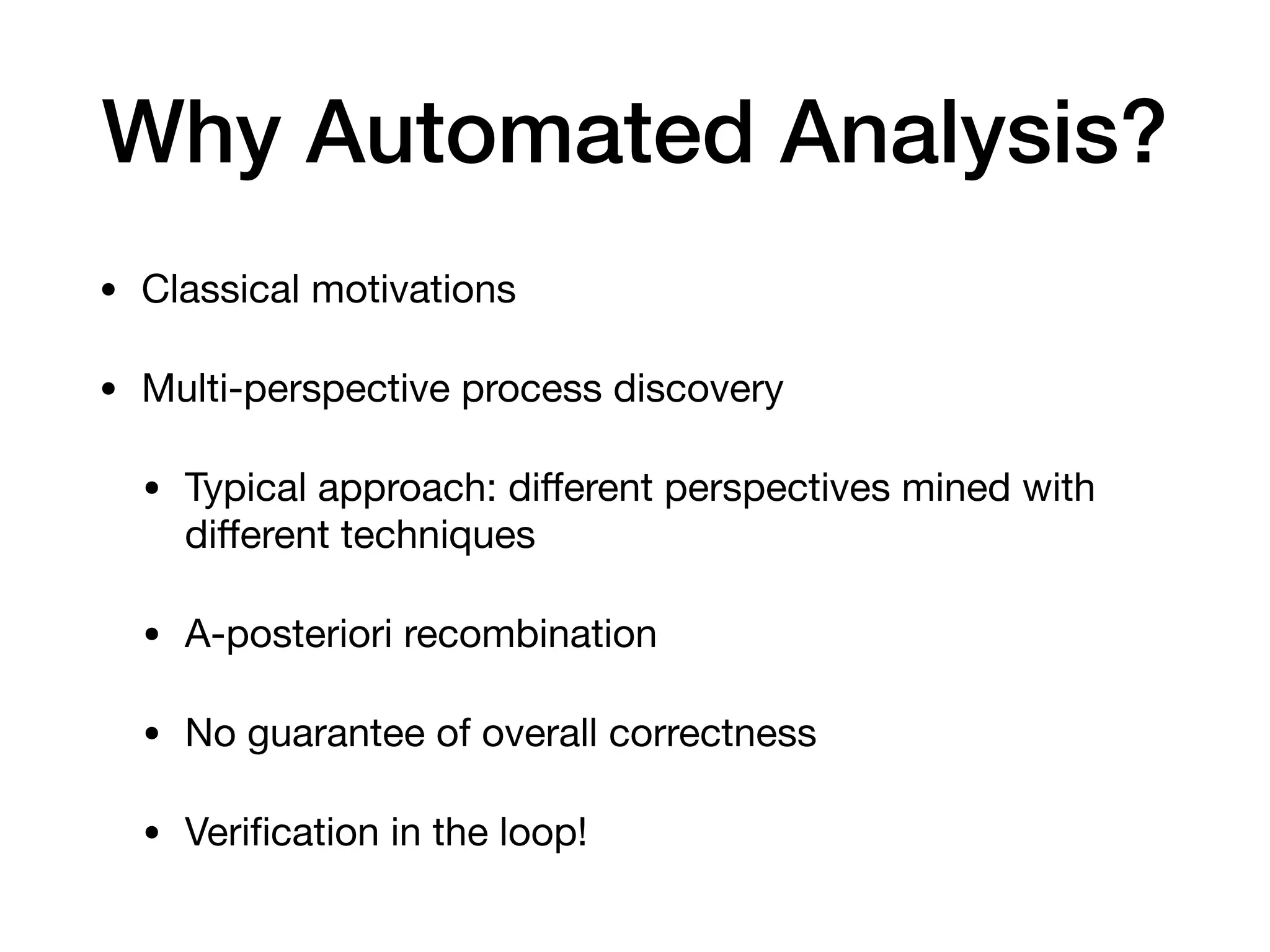
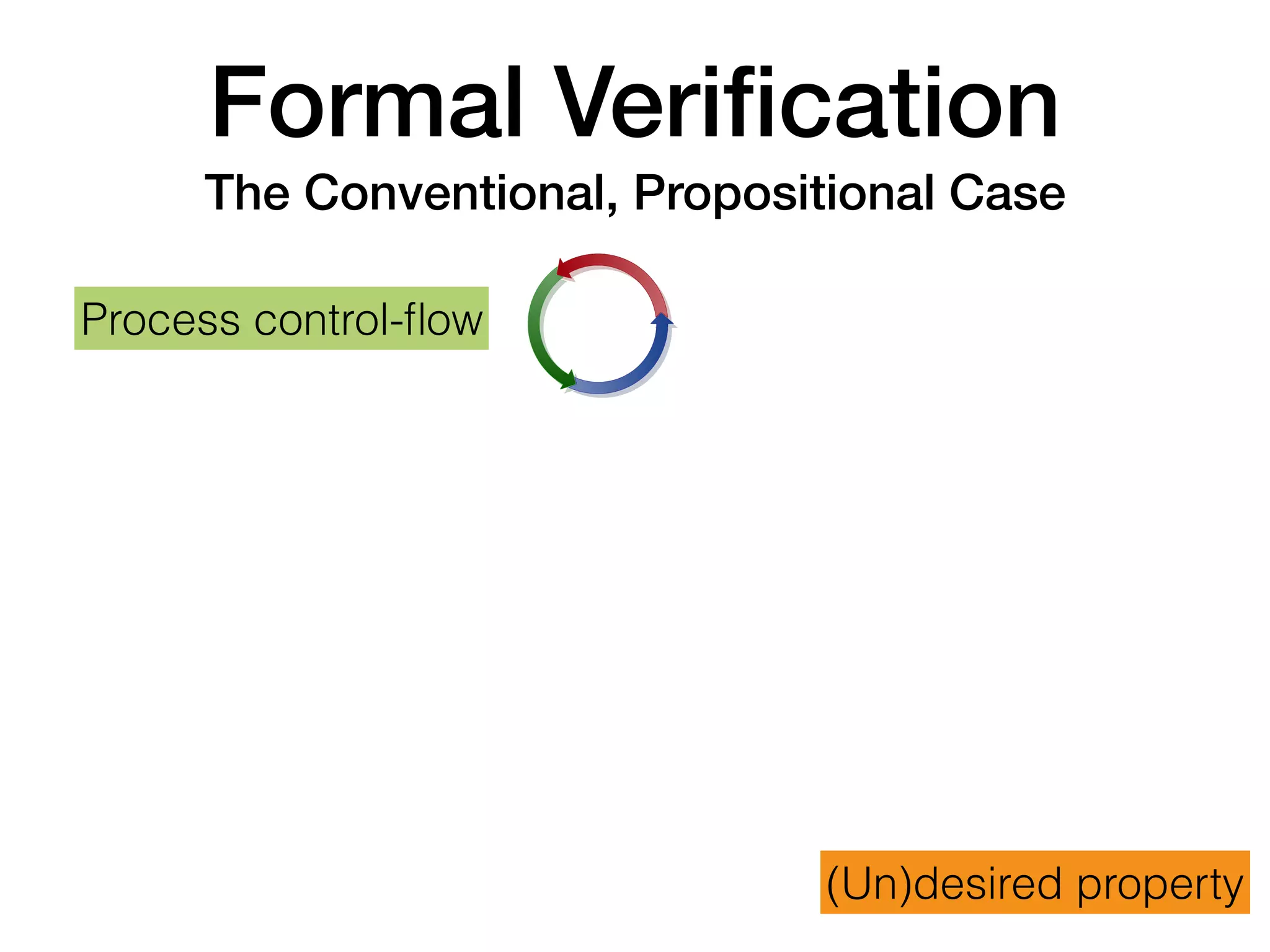
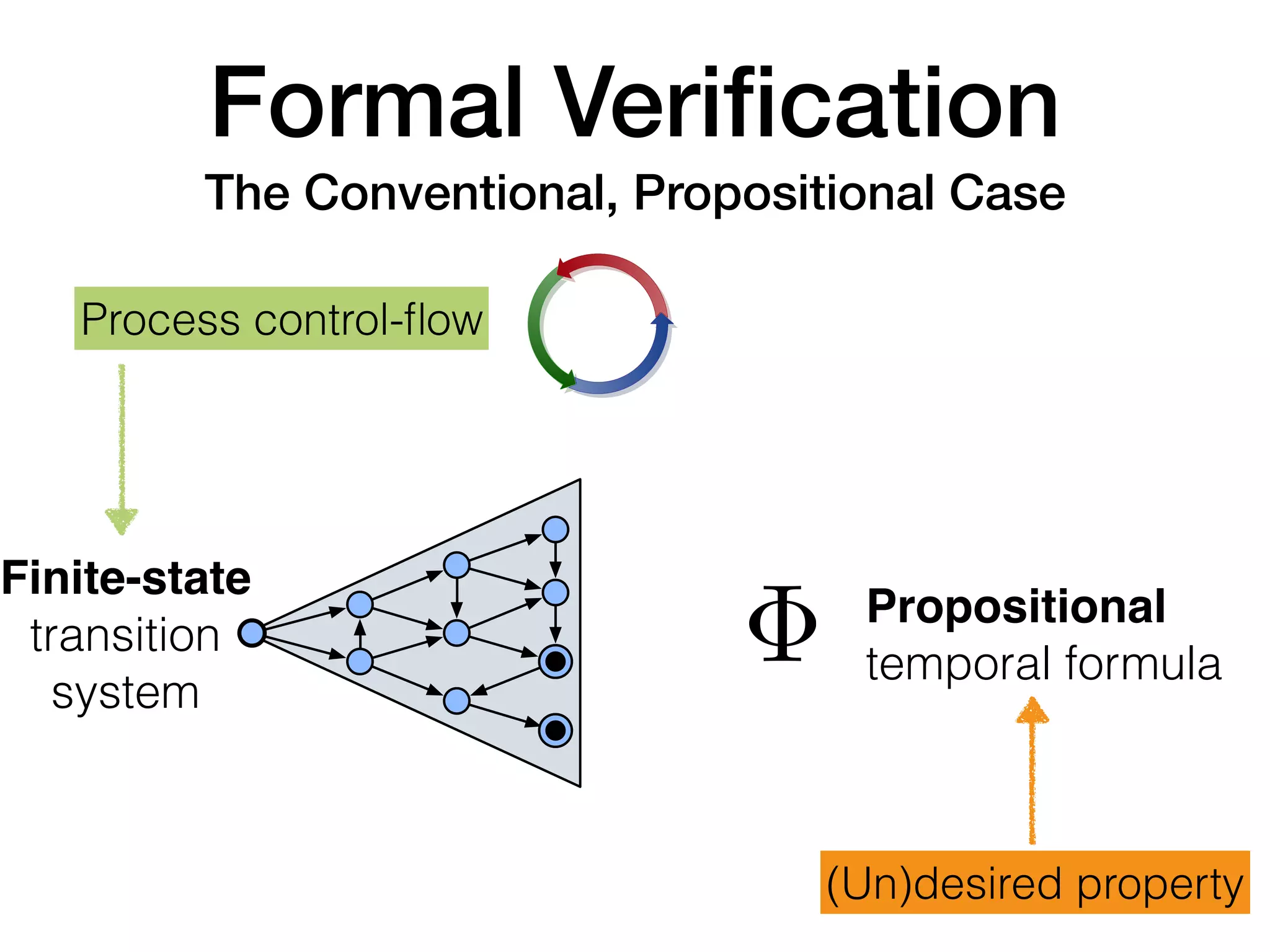
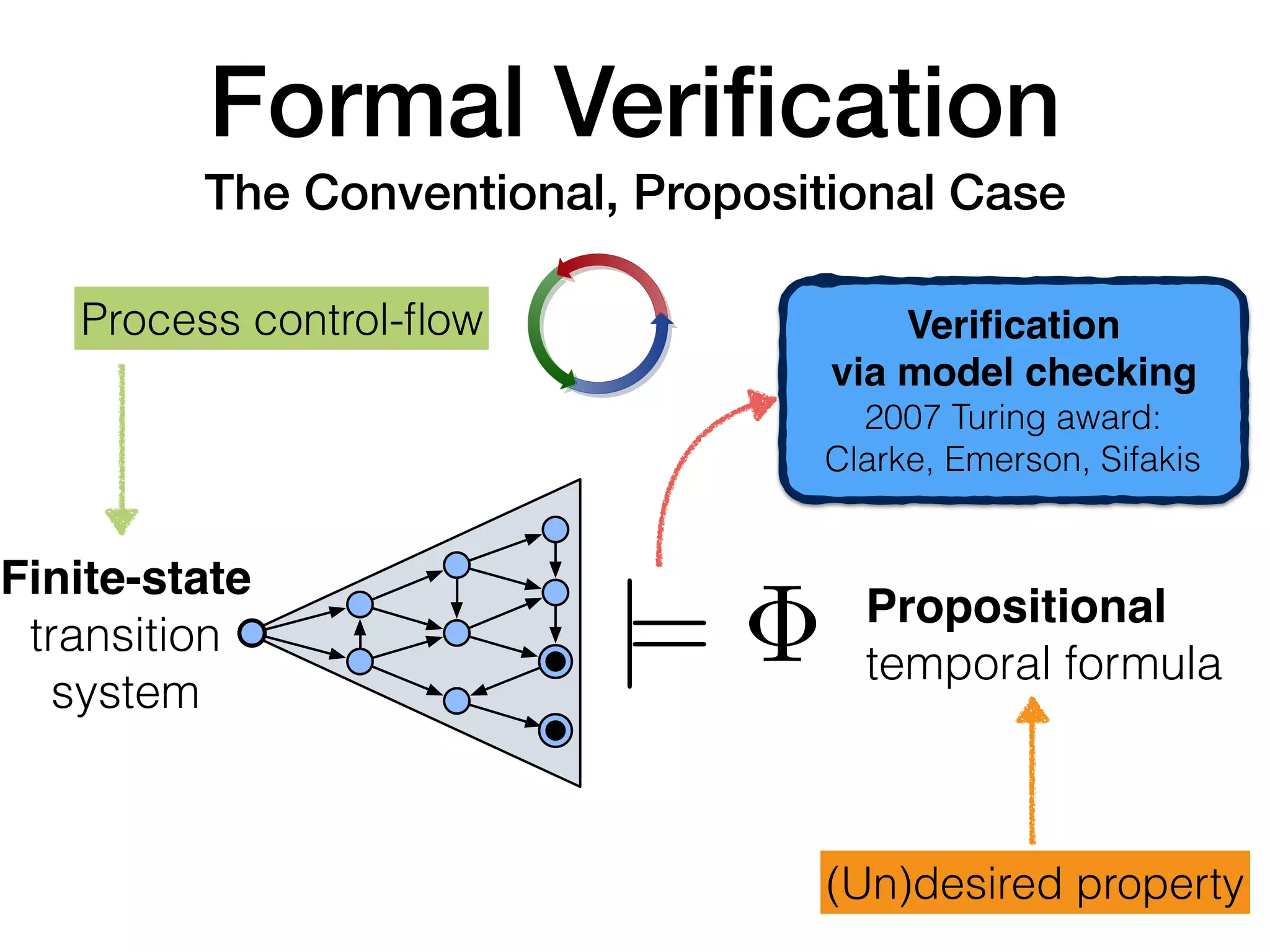
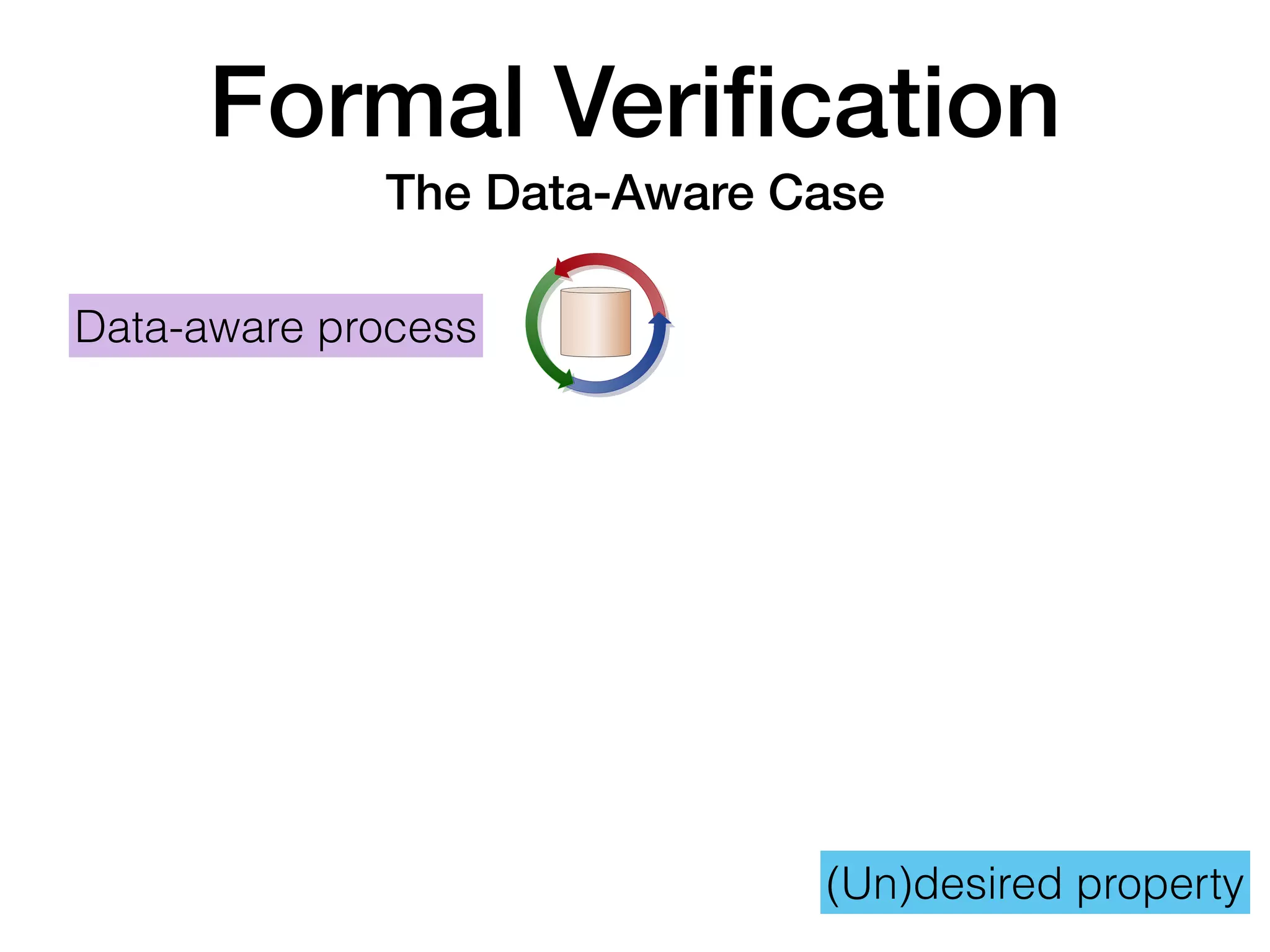
![(Un)desired property
First-order
temporal formula|=
Infinite-state, relational
transition system [Vardi 2005]
el underlying variants of artifact-centric systems.
quivalent to the most expressive models for business process
GSM).
Data Process Data+Process
elational databases / ontologies
ma, specifying constraints on the allowed states
nce: state of the DCDS
key elements are
tions
action-rules for application of actions
alls: communication with external environment, new data!
Foundations of Data-Aware Process Analysis INRIA Saclay Paris – 18/3/2016 (24/1)
Data-aware process
Formal Verification
The Data-Aware Case](https://image.slidesharecdn.com/cooking-data-processes-tue-feb-2019-190520214845/75/Cooking-with-Data-and-Processes-14-2048.jpg)
![(Un)desired property
First-order
temporal formula|=
?
Infinite-state, relational
transition system [Vardi 2005]
el underlying variants of artifact-centric systems.
quivalent to the most expressive models for business process
GSM).
Data Process Data+Process
elational databases / ontologies
ma, specifying constraints on the allowed states
nce: state of the DCDS
key elements are
tions
action-rules for application of actions
alls: communication with external environment, new data!
Foundations of Data-Aware Process Analysis INRIA Saclay Paris – 18/3/2016 (24/1)
Data-aware process
Formal Verification
The Data-Aware Case](https://image.slidesharecdn.com/cooking-data-processes-tue-feb-2019-190520214845/75/Cooking-with-Data-and-Processes-15-2048.jpg)
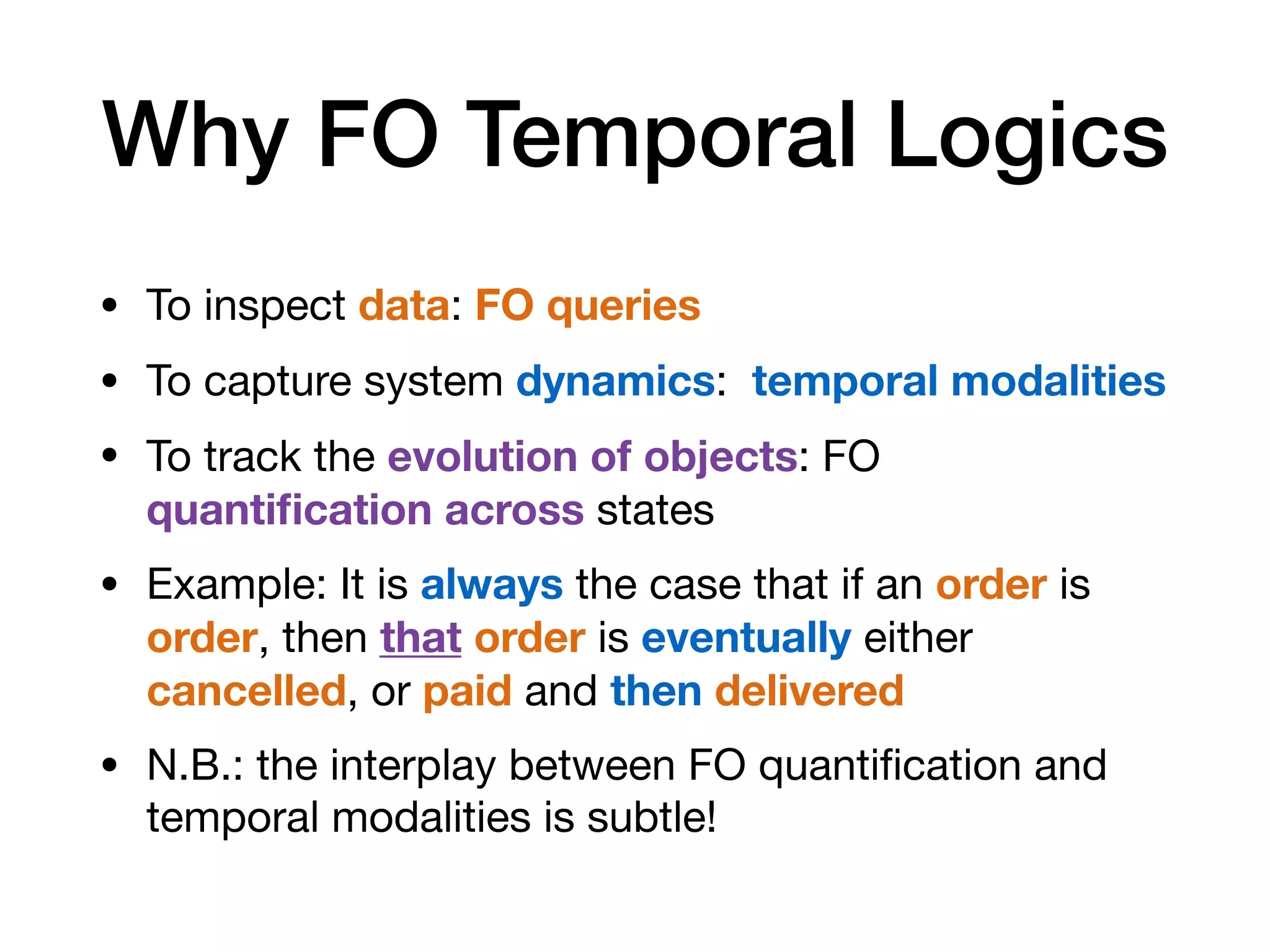
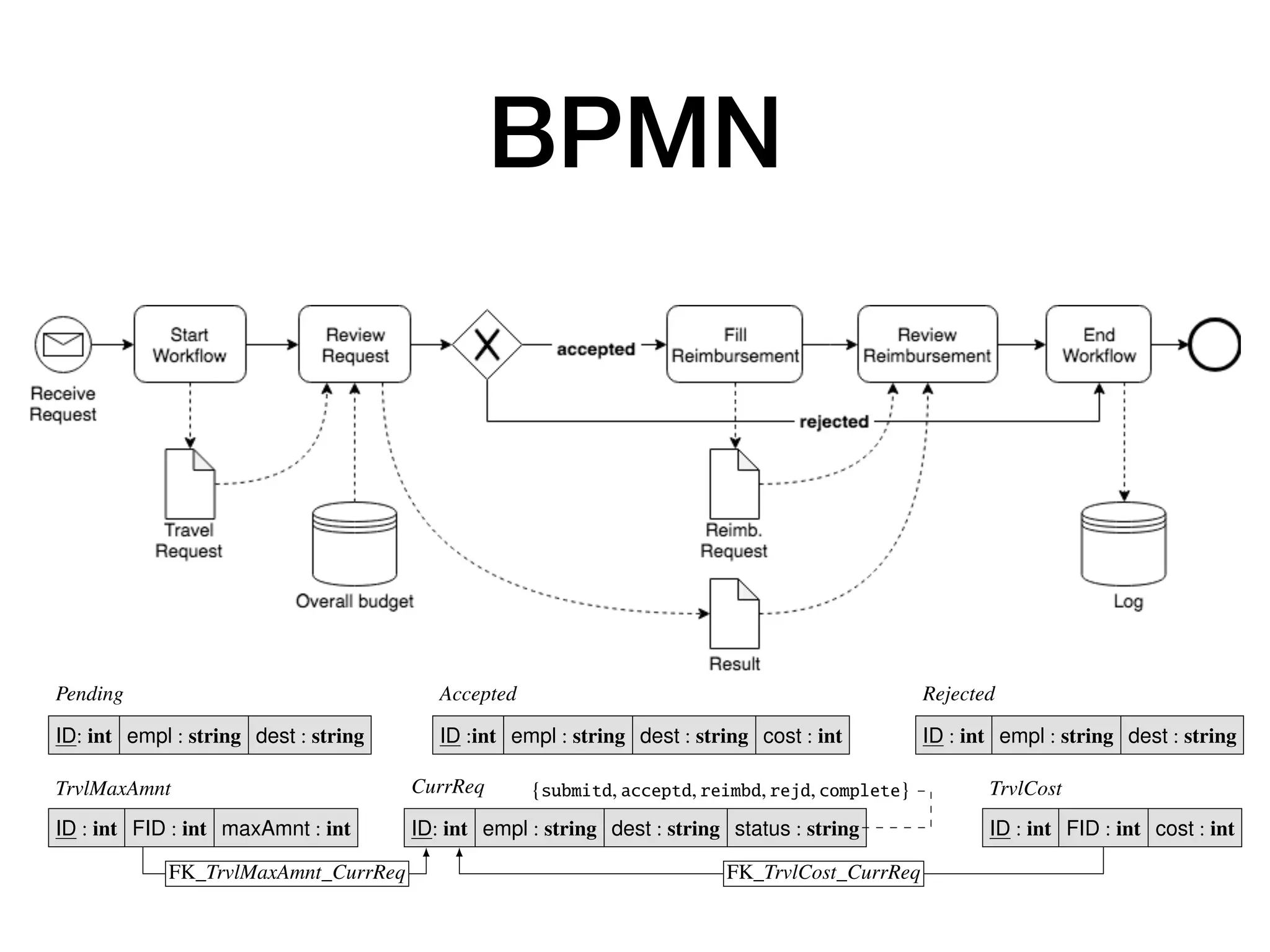
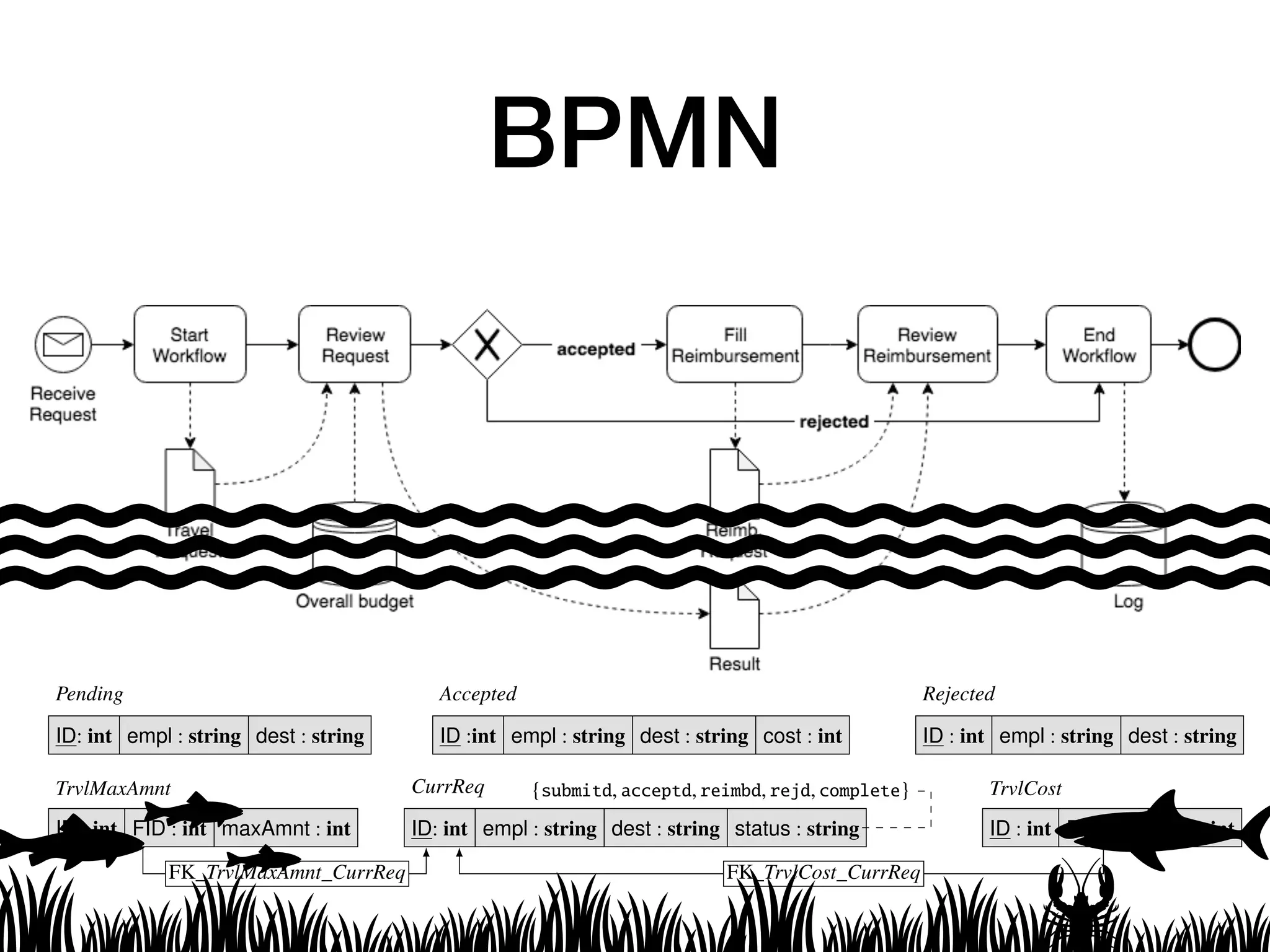
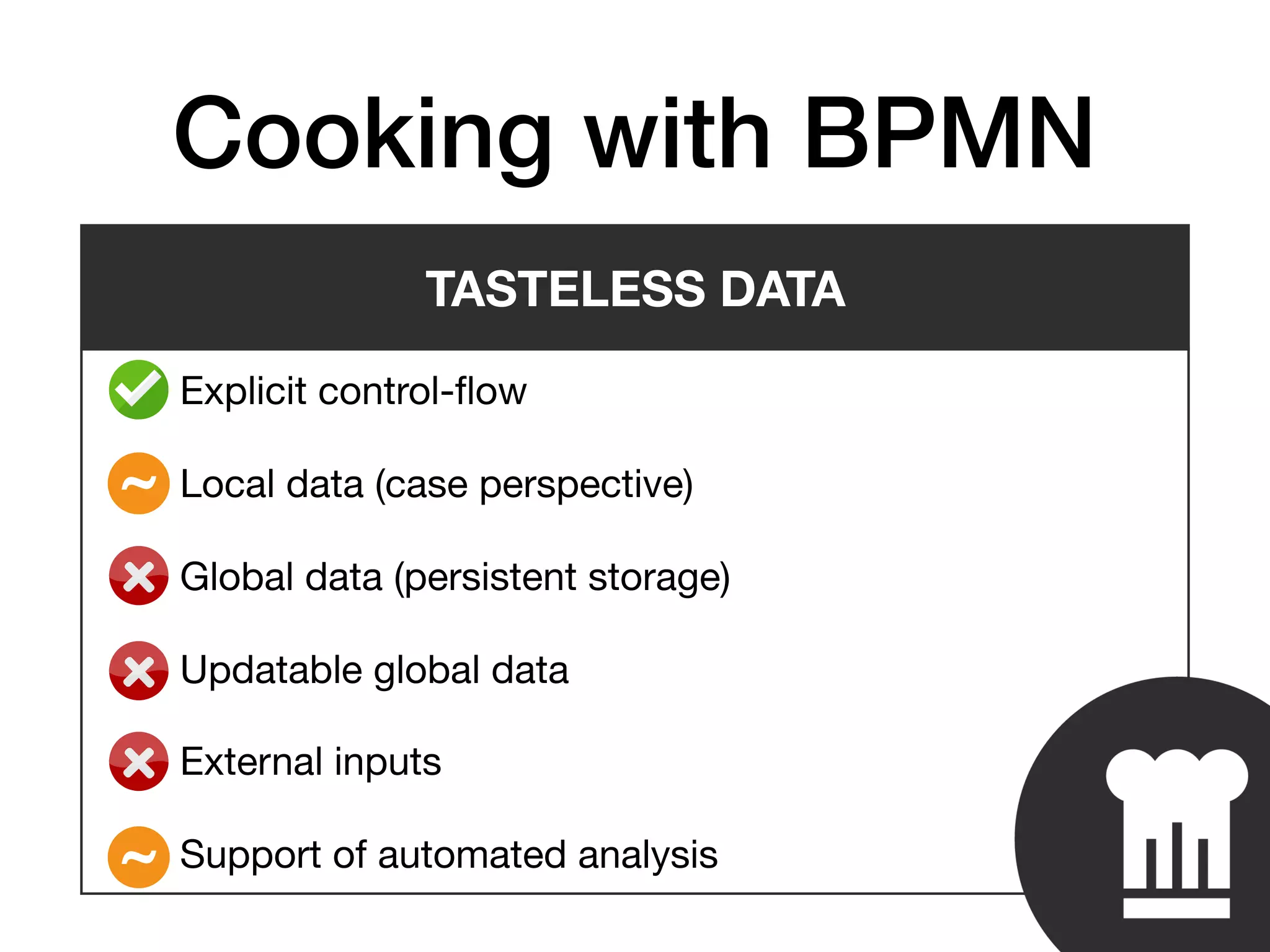
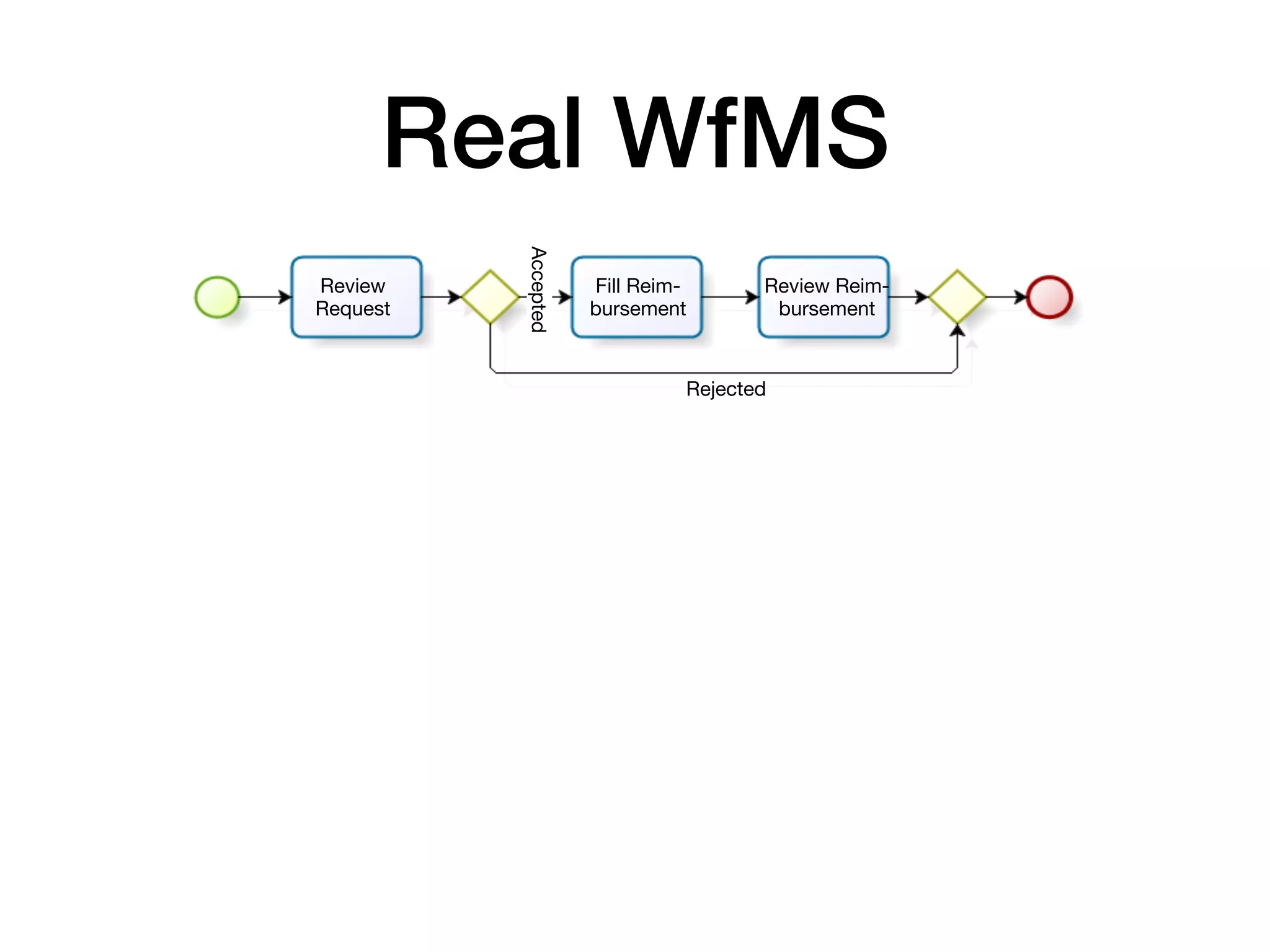
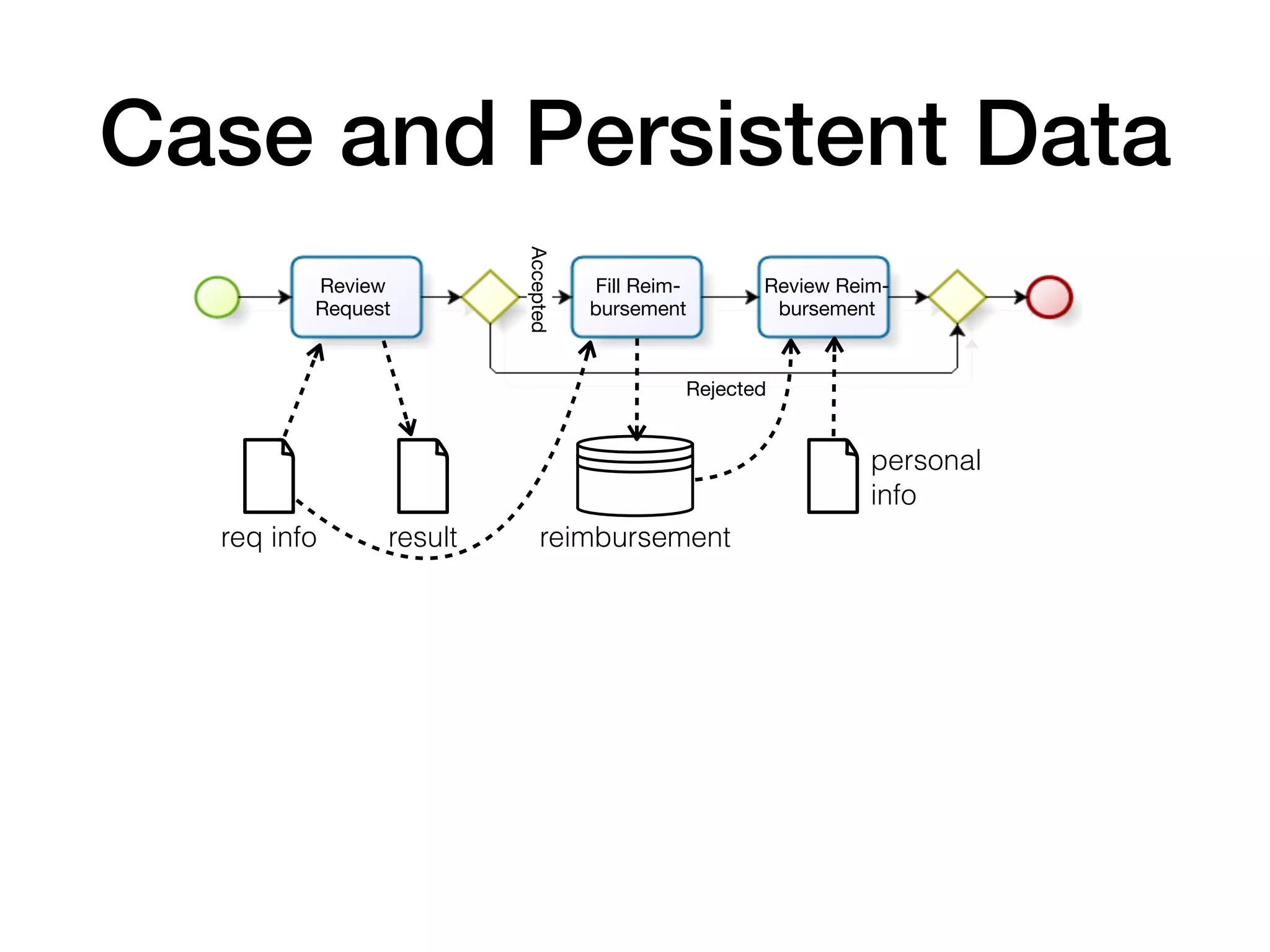
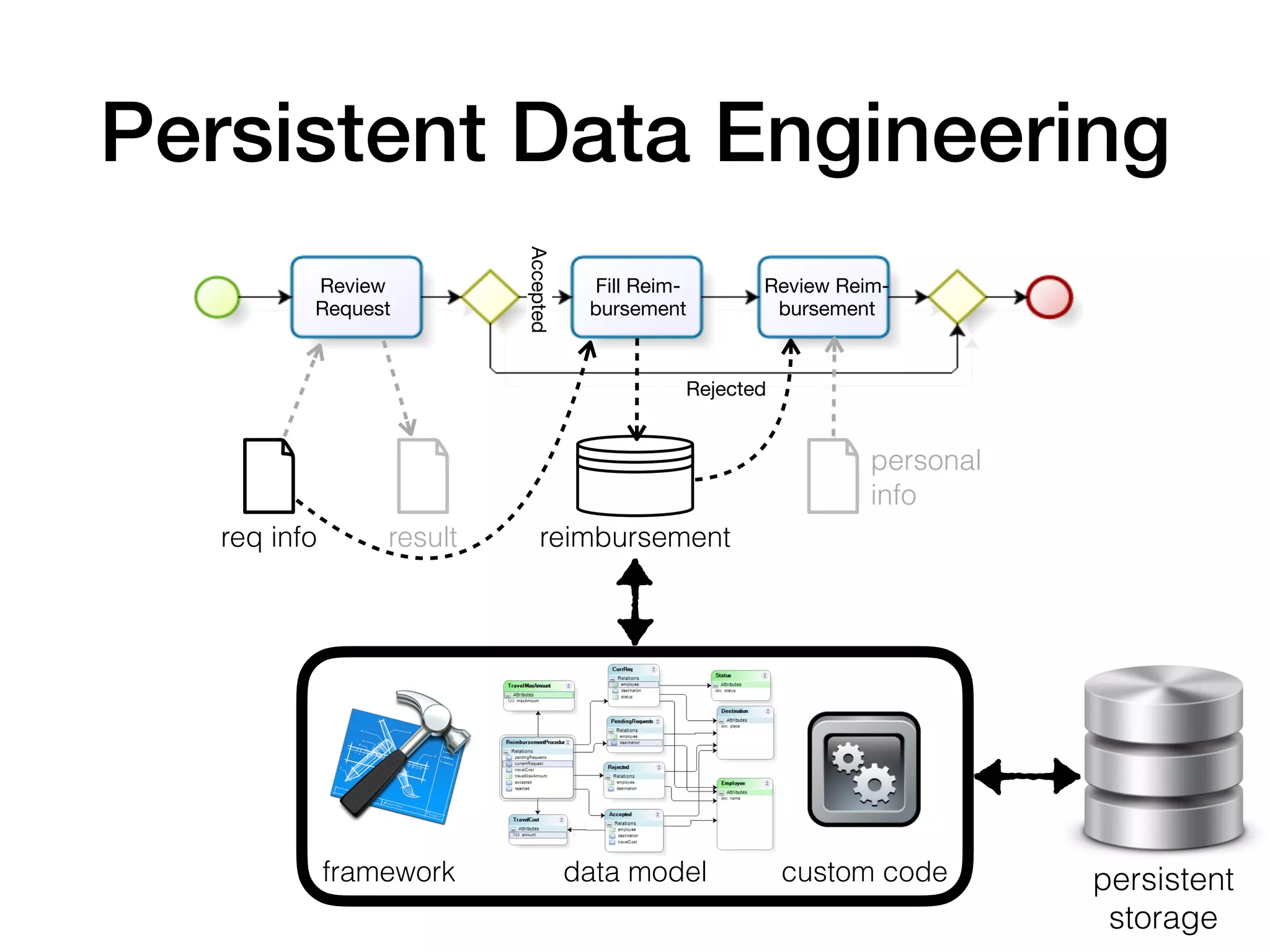
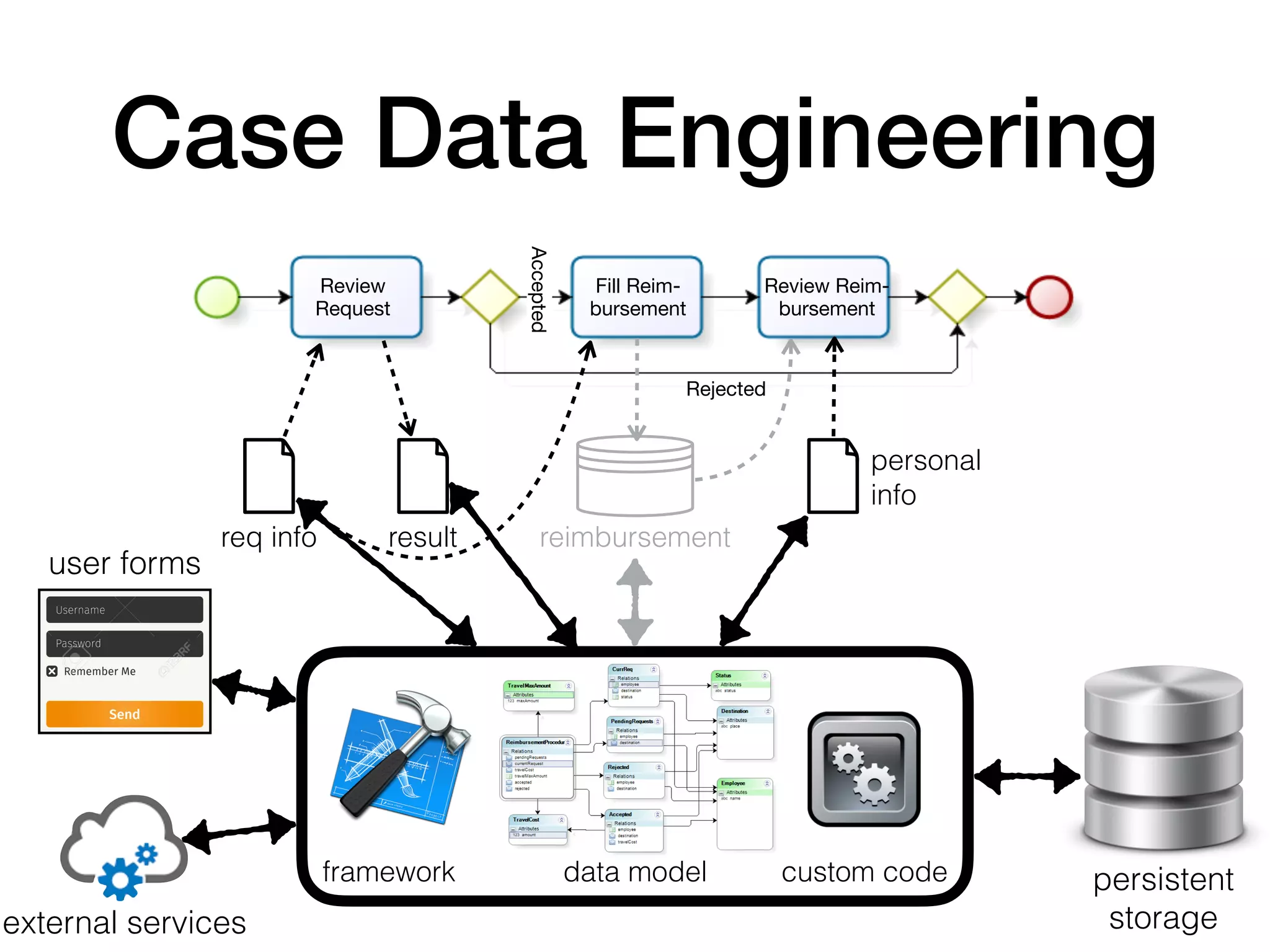
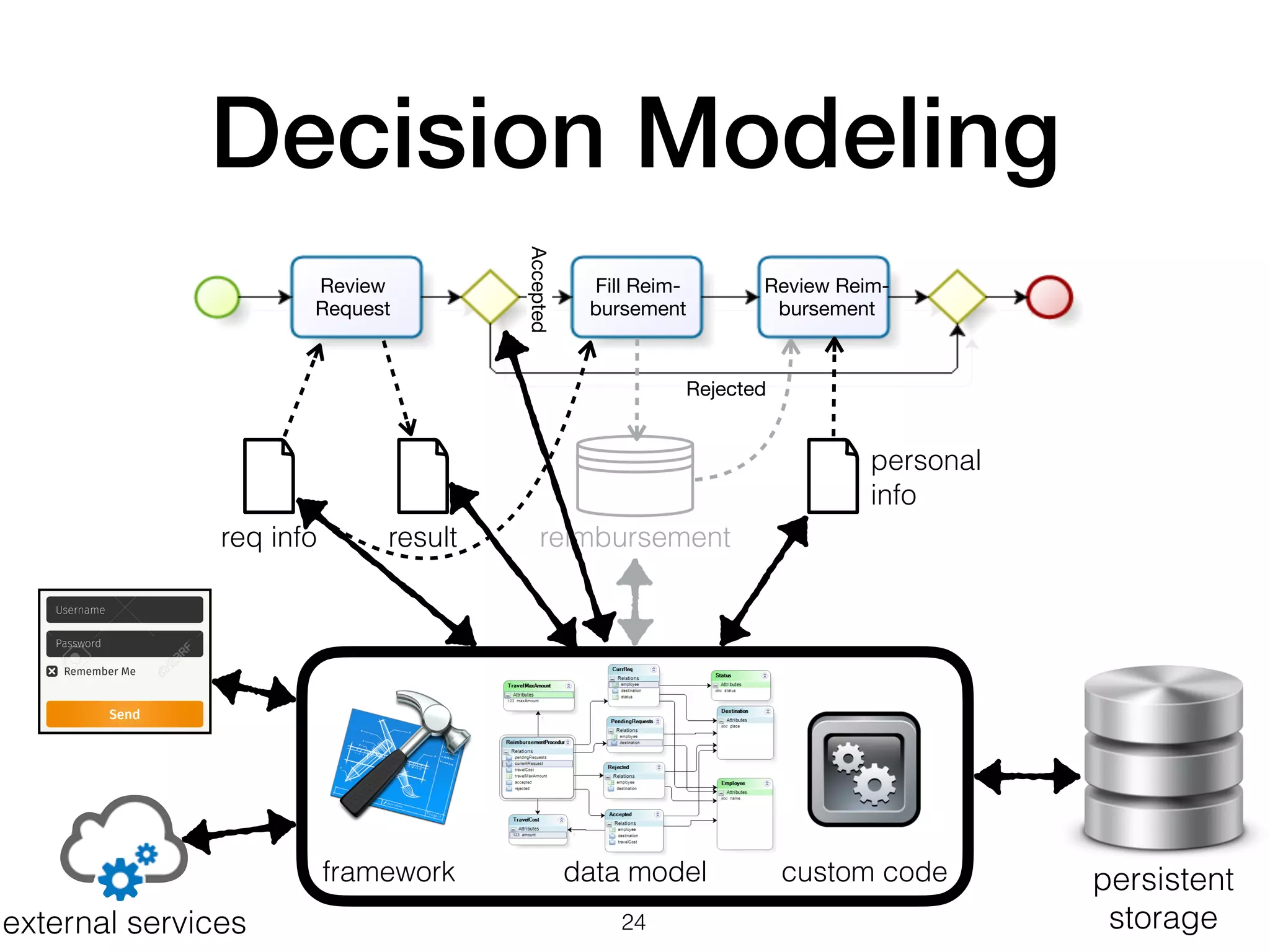

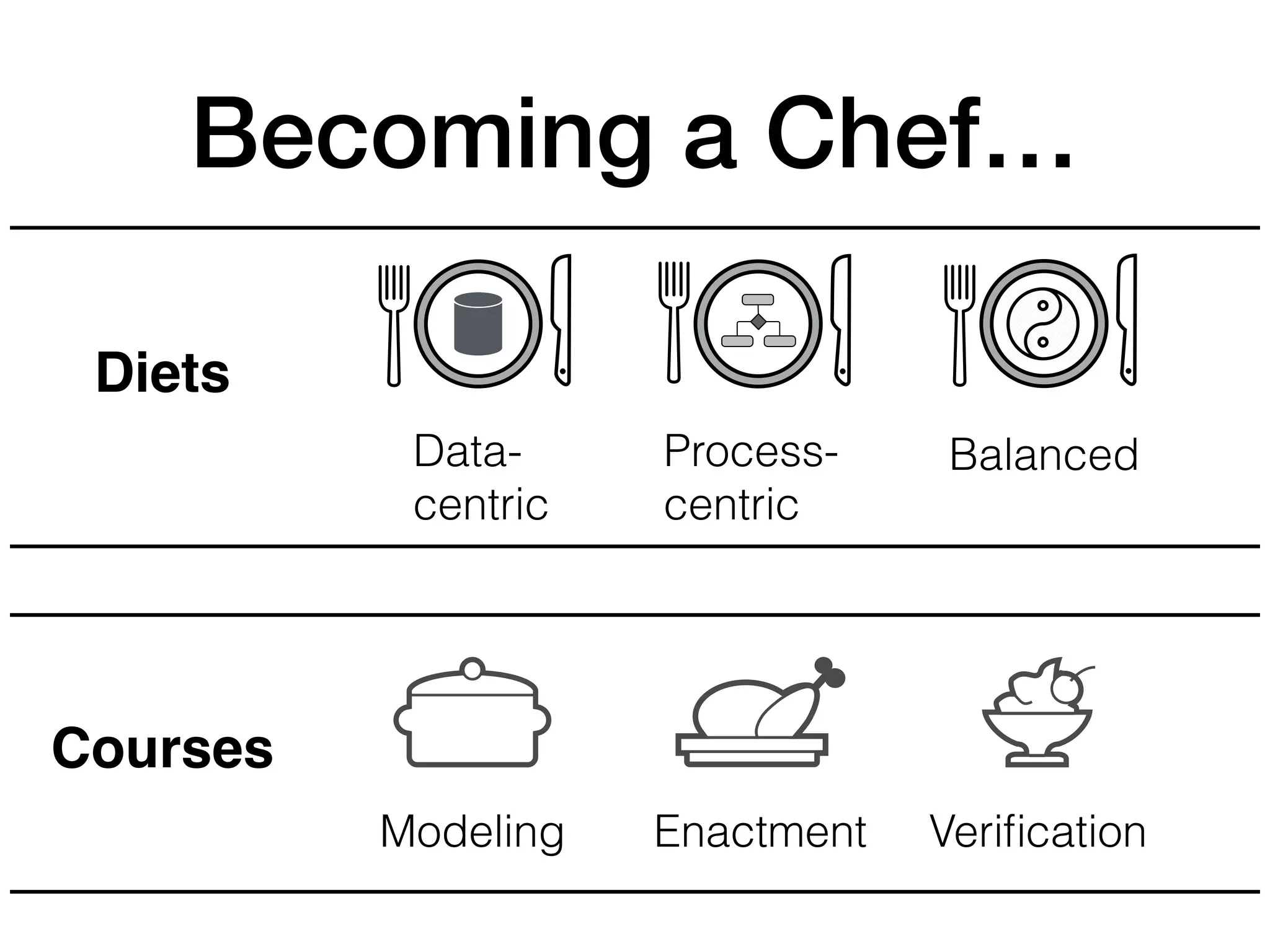

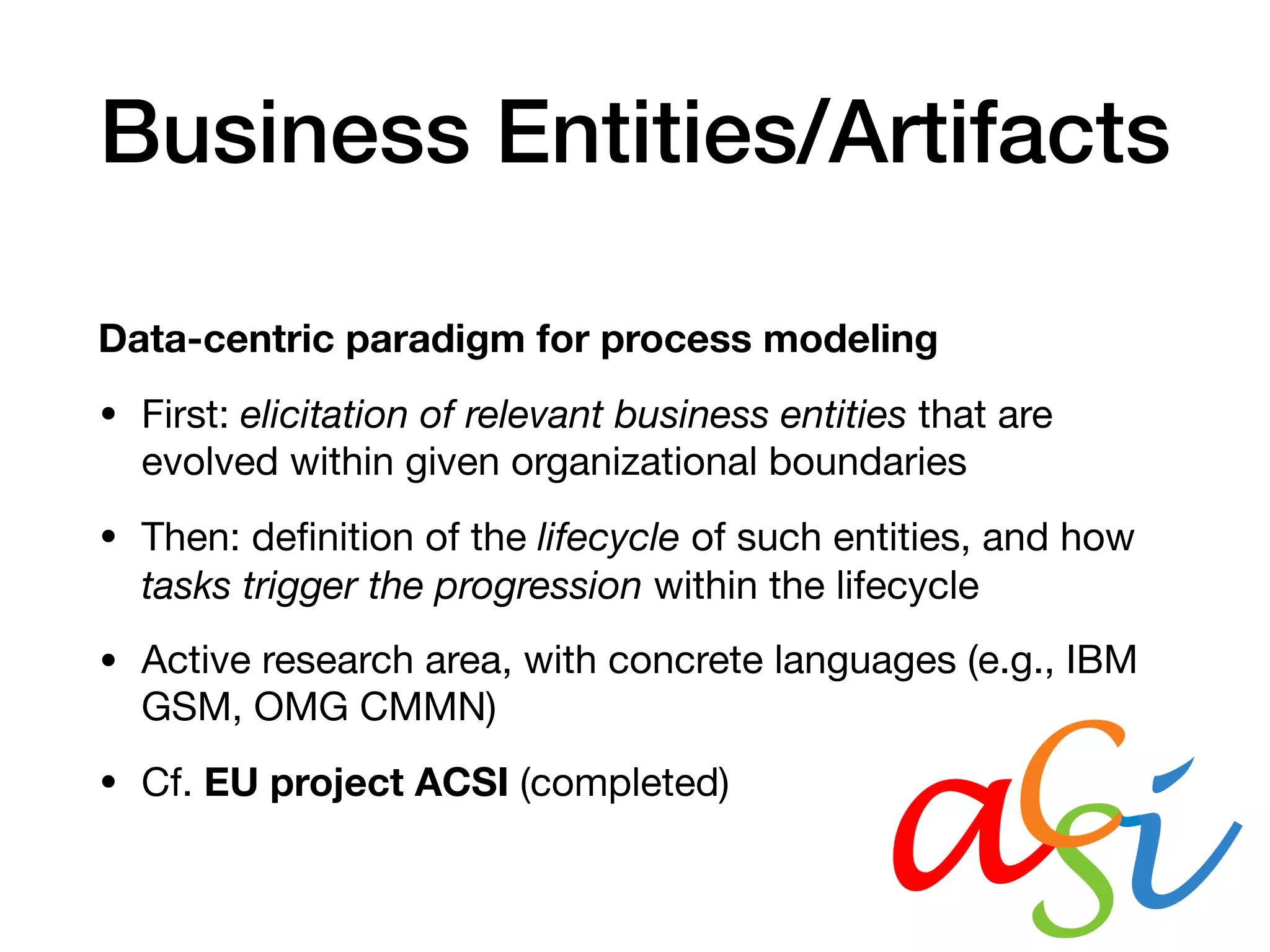
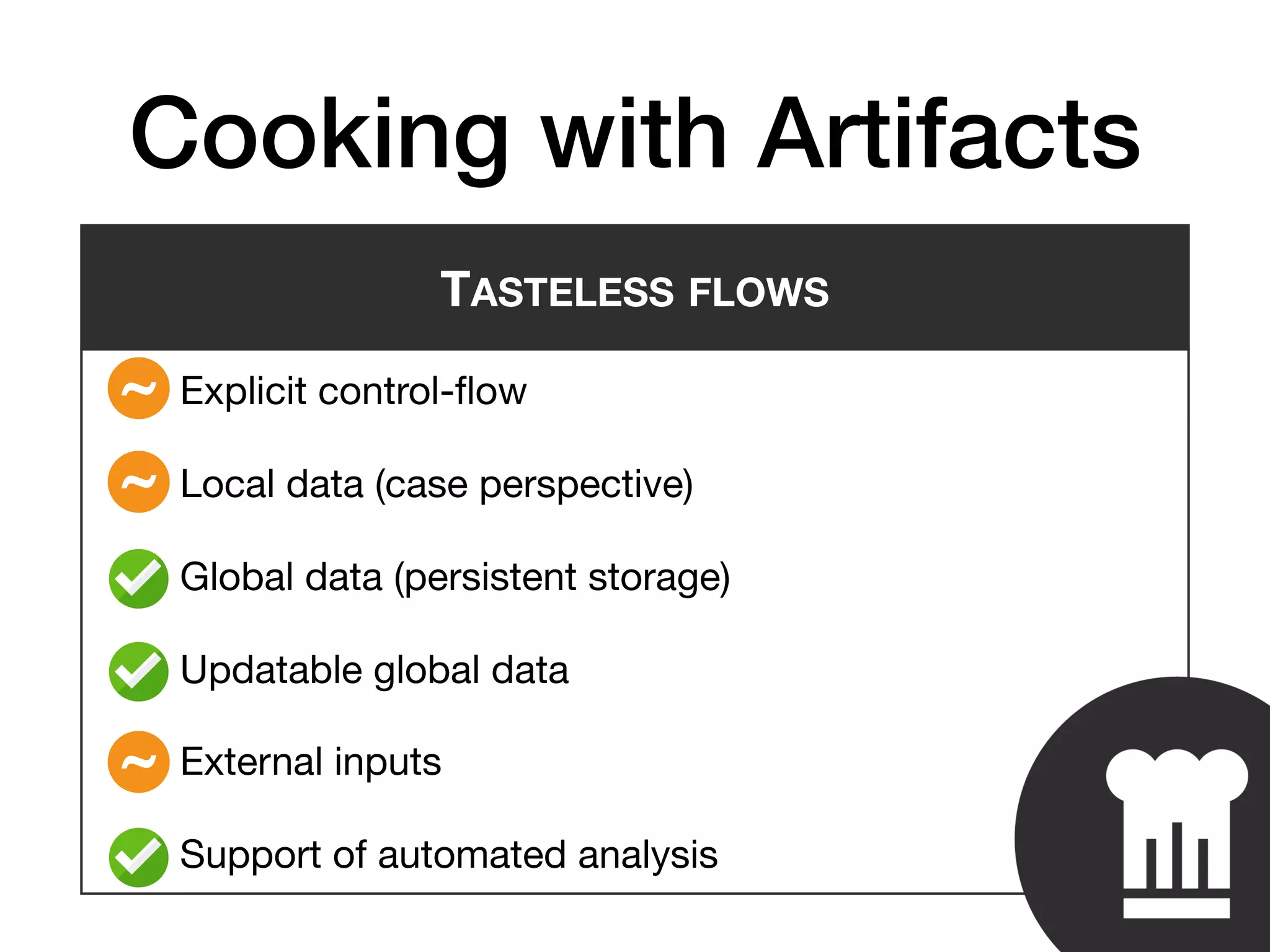
![Key Foundational Results
Artifact-centric systems can be formalized using Data-
Centric Dynamic Systems (DCDSs) [PODS 2013]
DCDSs provide:
• an execution semantics based on relational transition
systems
• verification results when the system is studied starting
from an initial, fixed instance
Confront with the line of research on parameterised
verification](https://image.slidesharecdn.com/cooking-data-processes-tue-feb-2019-190520214845/75/Cooking-with-Data-and-Processes-30-2048.jpg)
![DCDS Modeling
Data layer: persistent data
•Relational database with integrity constraints
Process layer: evolves the data
•Atomic actions: update the data
•CA rules: a control-flow component that determines when actions
can be executed
•Service calls: interact with external world, inject new data!
Data-centric Dynamic Systems (DCDSs) [PODS’13]
DCDS
Data
Layer
Process
Layer ...
Services
Data layer: maintains data of interest
I Relational database with integrity constraints
Process layer: evolves the data
I Atomic actions: update the data
I CA rules: a control-flow component that determines when actions
can be executed
I Service calls: interact with external world, inject new data!
[PODS’13] Bagheri Hariri B., Calvanese D., De Giacomo G., Deutsch A., and Montali M. â ˘AIJVerification of Relational
Data-centric Dynamic Systems with External Servicesâ ˘A˙I. In: Proc. of PODS. ACM, 2013, pp. 163â ˘A ¸S174
Modeling, Enactment and Verification of Data-Aware Processes 17 / 55](https://image.slidesharecdn.com/cooking-data-processes-tue-feb-2019-190520214845/75/Cooking-with-Data-and-Processes-31-2048.jpg)
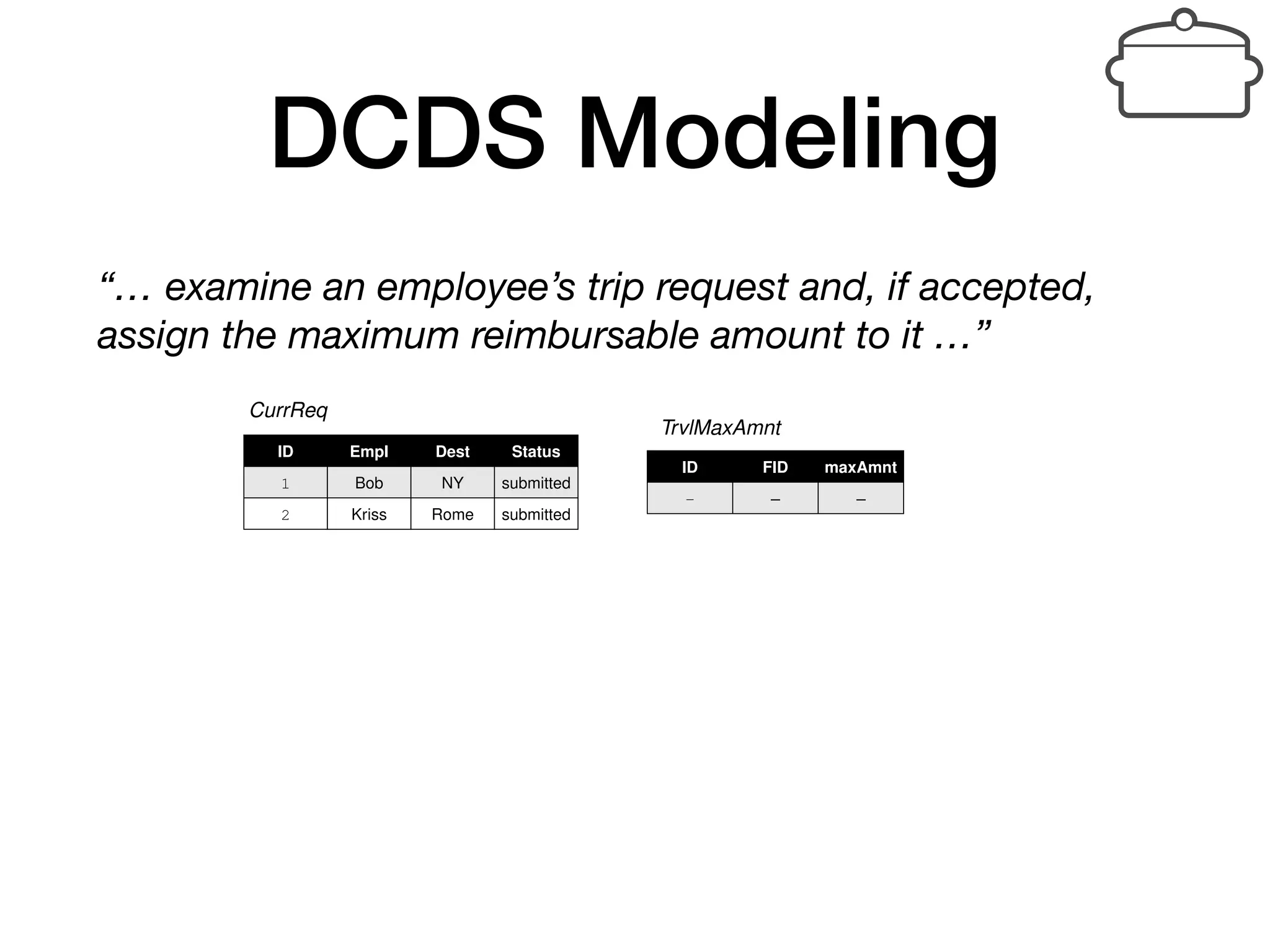
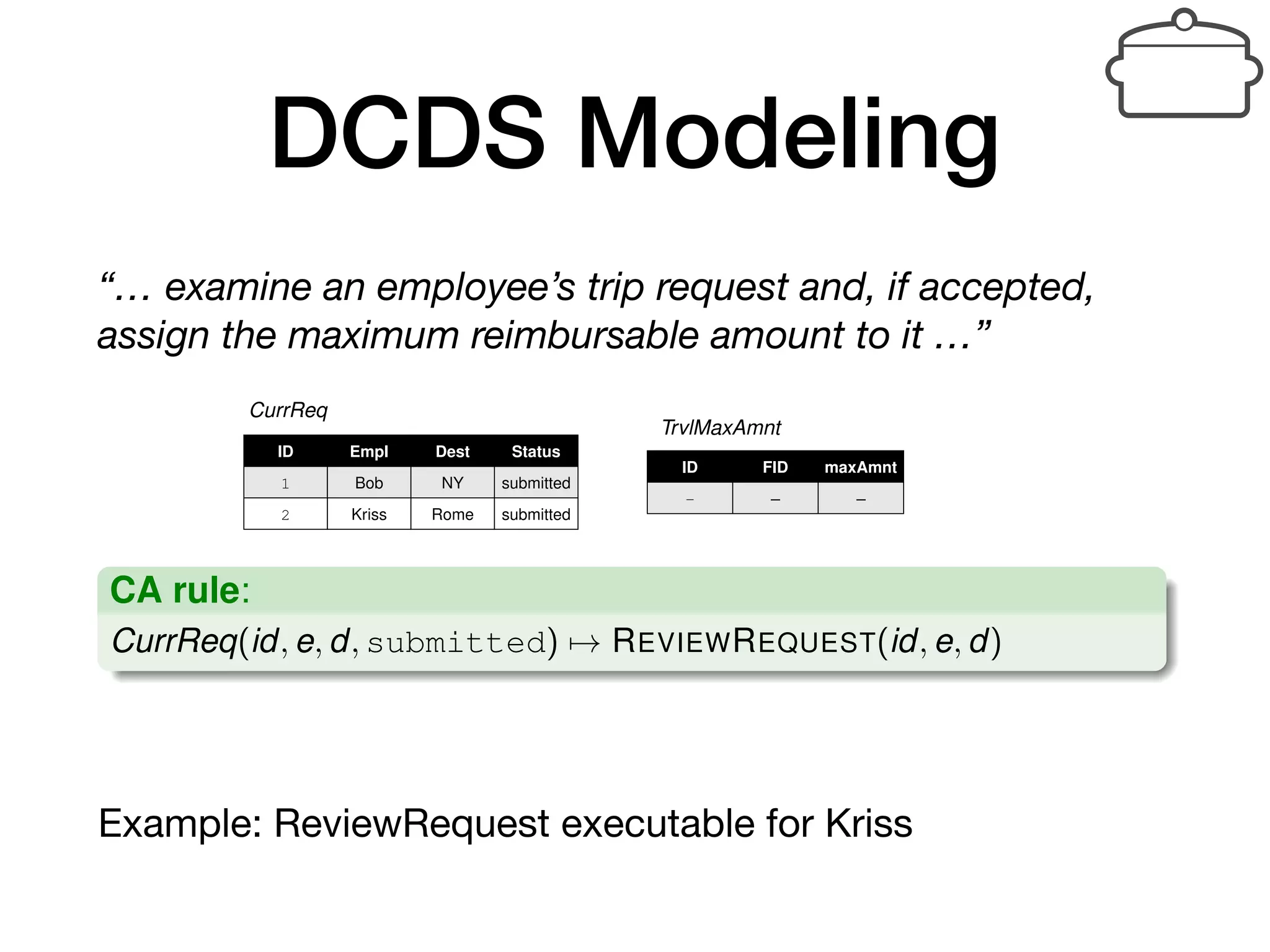
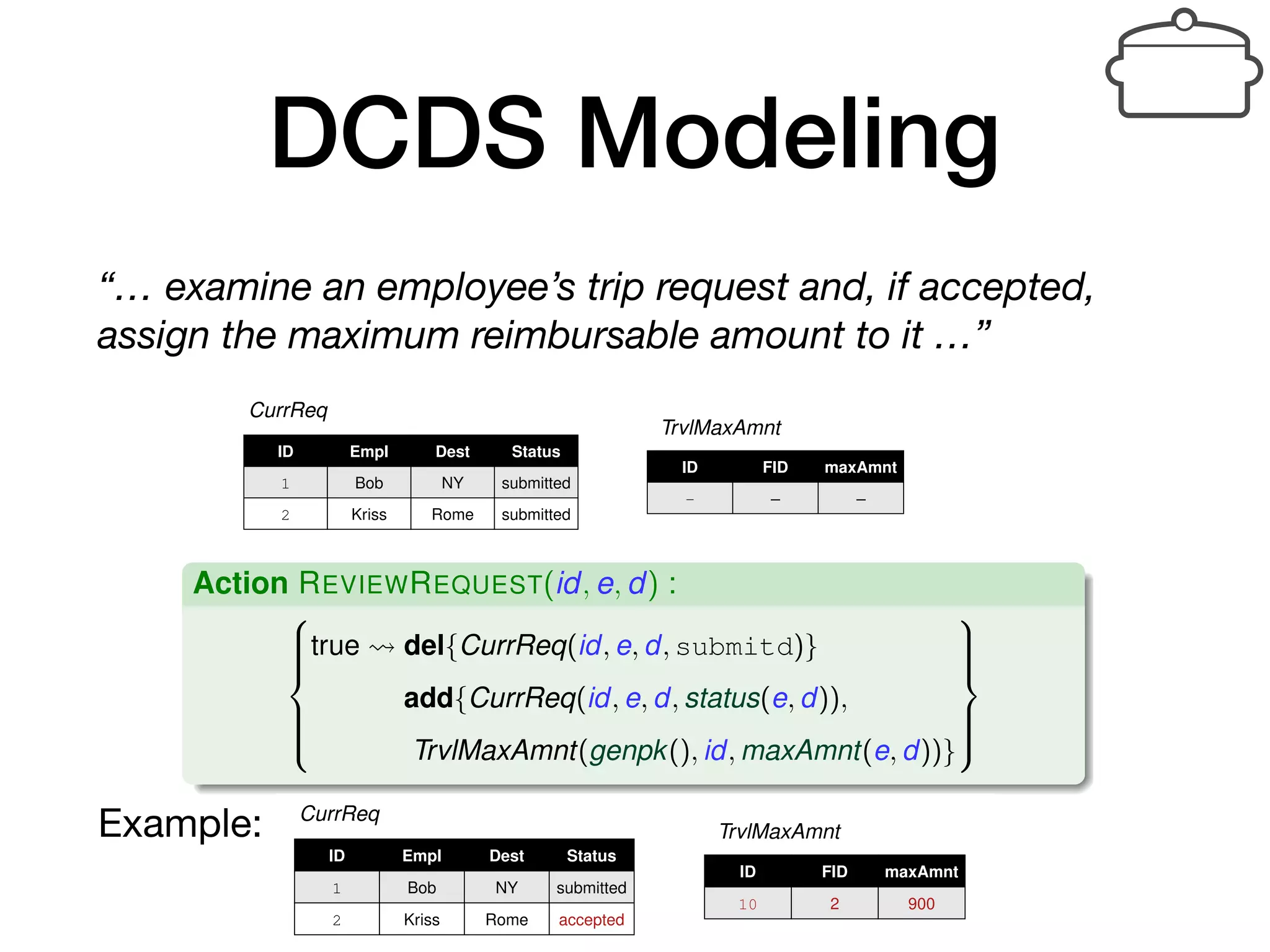
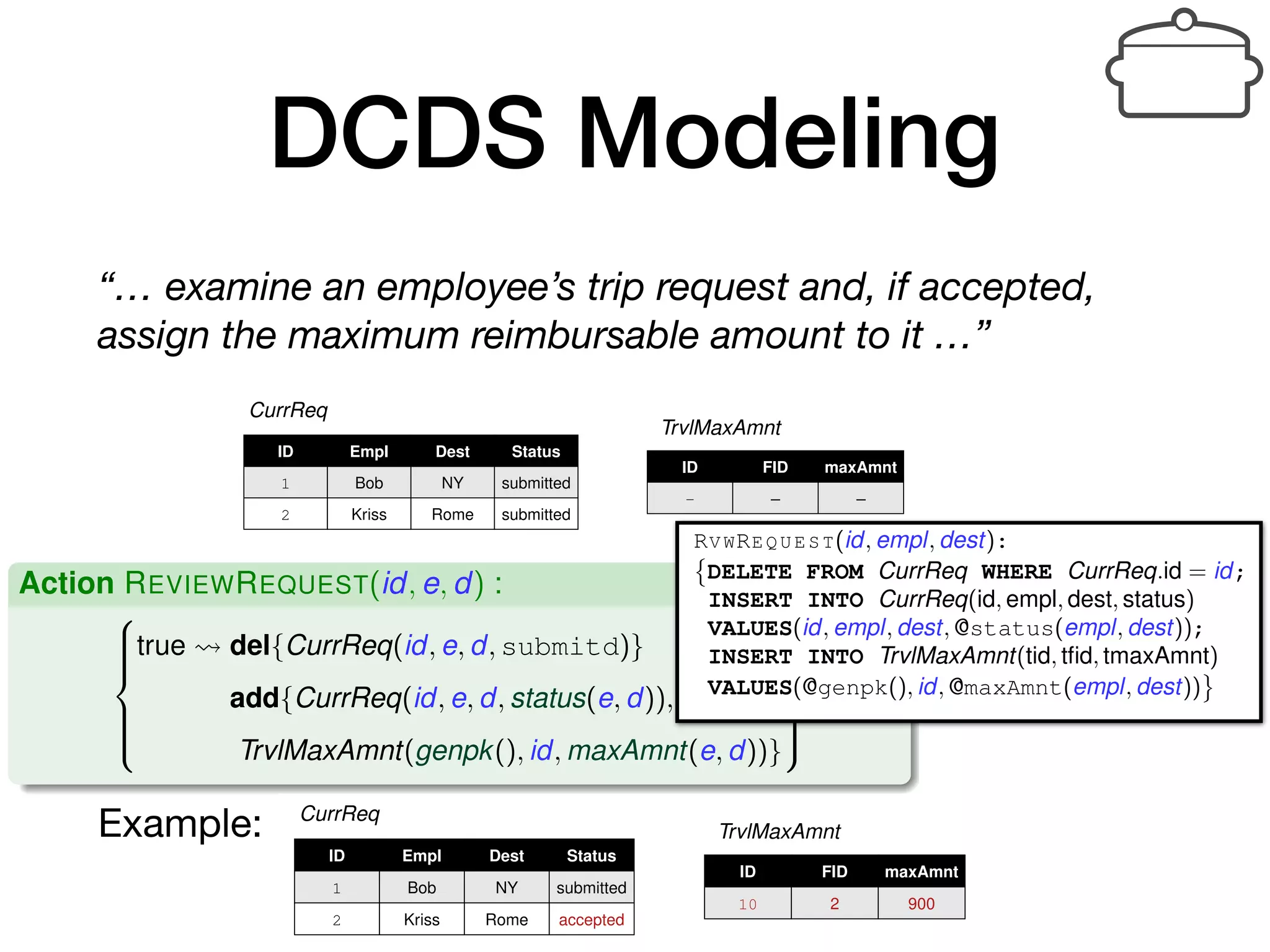
![DCDS Enactment
DAPHNE: SQL+Java executor for DCDSs [Hopefully CAiSE 2019]
• SQL-like frontend
• Translation into procedural SQL stored procedures
• Management of external services
• Execution directly on top of the database, with different
execution modalities (including state-space construction)
Towards implementing RDSs
A RDS model is maintained by the RDBMS (e.g., PostgreSQL)
Interaction provided by the Flow Engine, which:
I executes calls to the RDBMS
I interplays with external services through a Service Manager
Modeling, Enactment and Verification of Data-Aware Processes 21 / 55](https://image.slidesharecdn.com/cooking-data-processes-tue-feb-2019-190520214845/75/Cooking-with-Data-and-Processes-36-2048.jpg)
![DCDS Verification
Highly-undecidable in general
Attacked for “state-bounded” systems
[PODS 2013]
In a state-bounded system, the number of
tuples accumulated in a single state cannot
exceed a pre-defined bound
• Still, infinitely many distinct values can be
encountered within and across runs](https://image.slidesharecdn.com/cooking-data-processes-tue-feb-2019-190520214845/75/Cooking-with-Data-and-Processes-37-2048.jpg)
![Verification of State-Bounded DCDSs
[PODS 2013, Inf. Com. 2018]
Branching-time FO logics (contain reachability, soundness,..)
• decidable and reducible to standard finite-state model
checking
—> hence, so are soundness properties
Linear-time FO logics
• Undecidable in general: the system is not Turing-powerful
on its own, but the logics isolate runs and separate
spurious from genuine ones
• Decidable and reducible to standard finite-state model
checking by controlling the interplay between FO
quantifiers and temporal modalities (object persistency)](https://image.slidesharecdn.com/cooking-data-processes-tue-feb-2019-190520214845/75/Cooking-with-Data-and-Processes-38-2048.jpg)
![Is My System State-Bounded?
• For a fixed k: decidable.
• For “some” bound: undecidable.
• Classes with decidable state boundedness
• Reasonable for the control layer, not for the data
logic [KR2014,ACSD2018,Formal Asp. Comp.2016]
• Sufficient, syntactic conditions [PODS2013,KR2014]
• Methodologies to guarantee state-boundedness by
design [ICSOC2013,CIKM14,STTT16,Formal Asp.
Comp.2016]](https://image.slidesharecdn.com/cooking-data-processes-tue-feb-2019-190520214845/75/Cooking-with-Data-and-Processes-39-2048.jpg)

![ν-Petri Nets
[Rosa-Velardo and de Frutos-Escrig, Fund. Inf. 2008]
Petri nets with name creation and management
• Tokens carry names: ids coming from an infinite domain,
can be compared for equality via arc inscriptions
• ν variables indicate the generation of fresh names not
present in the net
• ν-PNs are WSTS —> termination, coverability,
boundedness decidable](https://image.slidesharecdn.com/cooking-data-processes-tue-feb-2019-190520214845/75/Cooking-with-Data-and-Processes-41-2048.jpg)
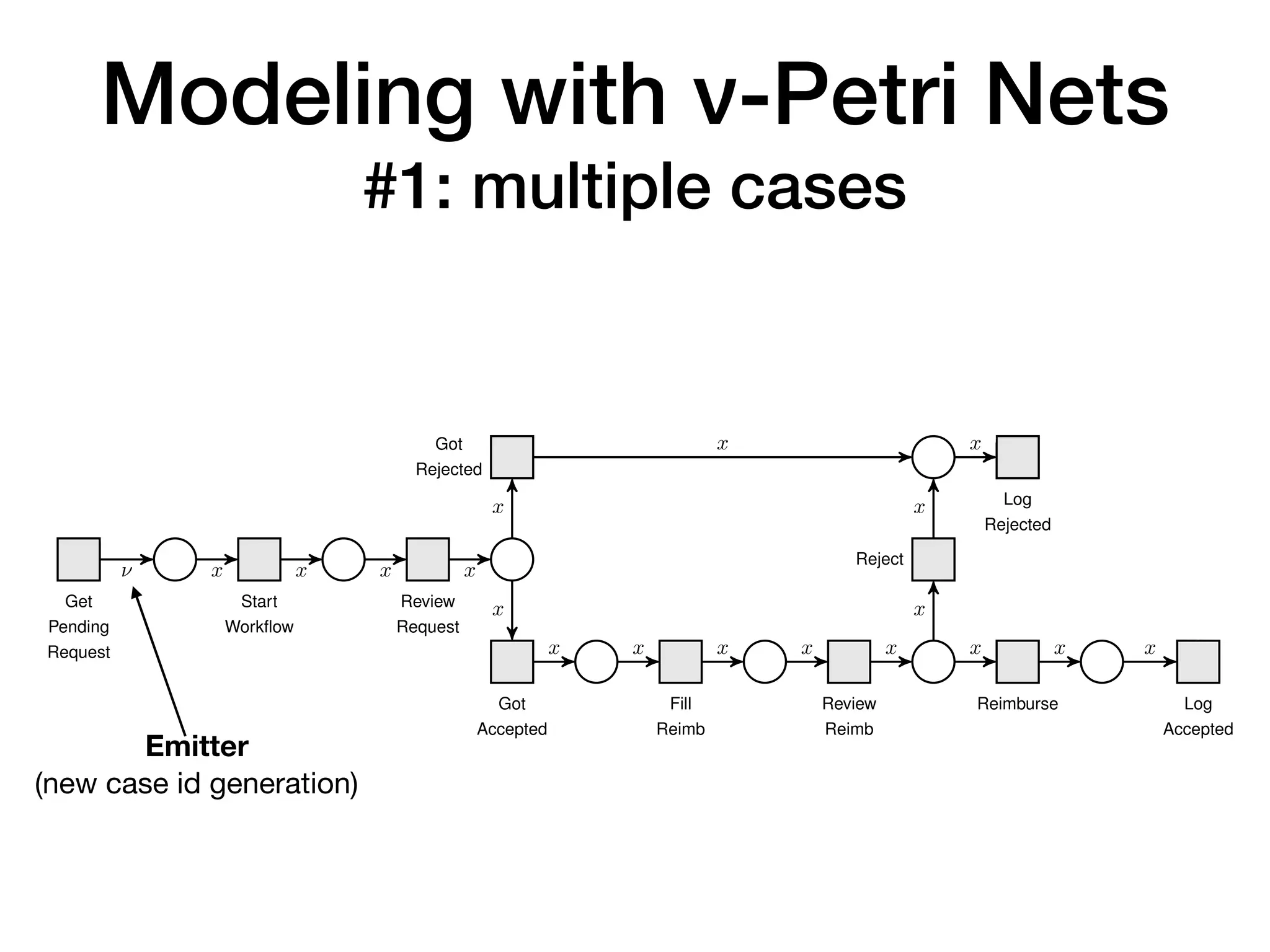

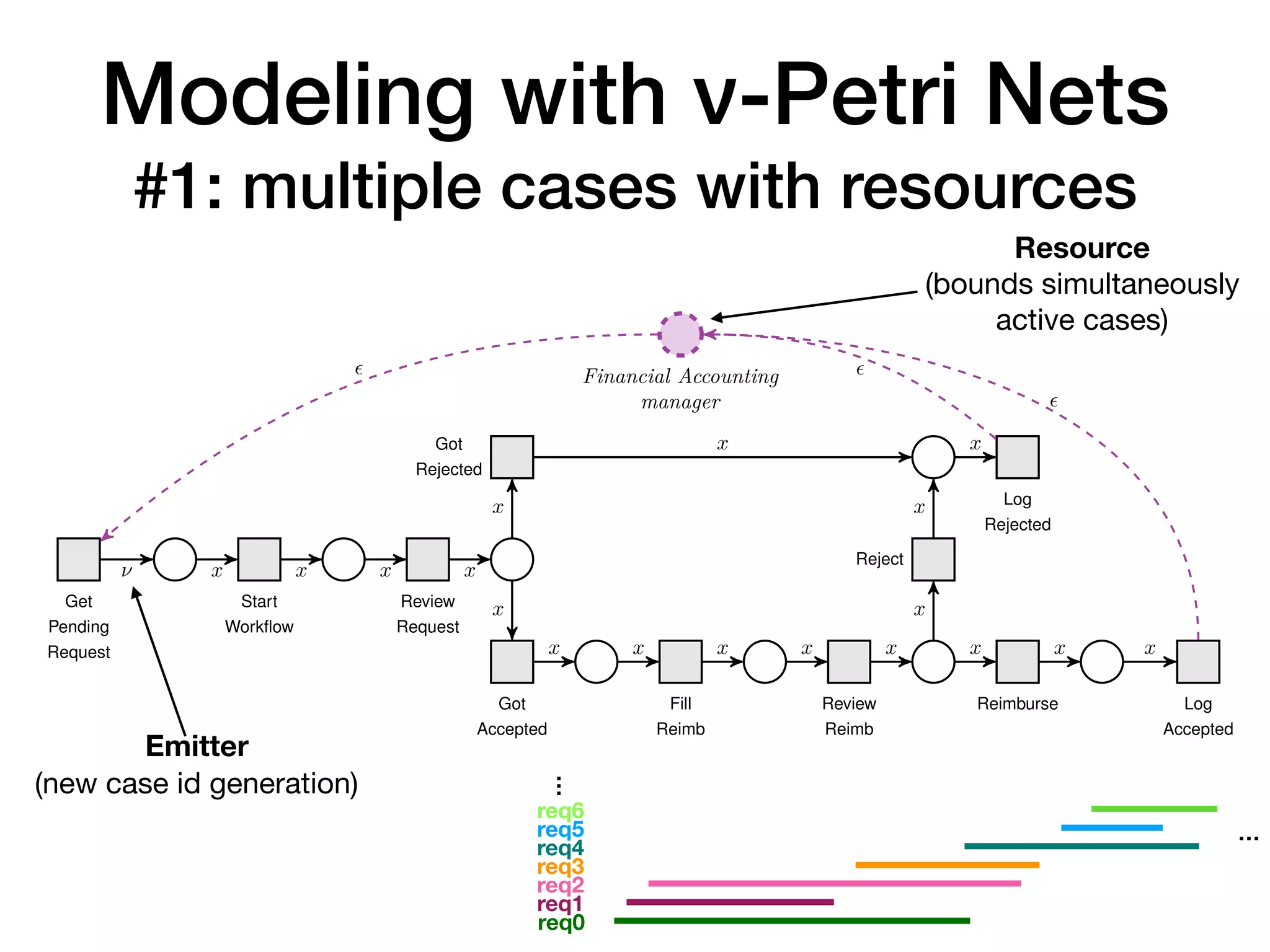
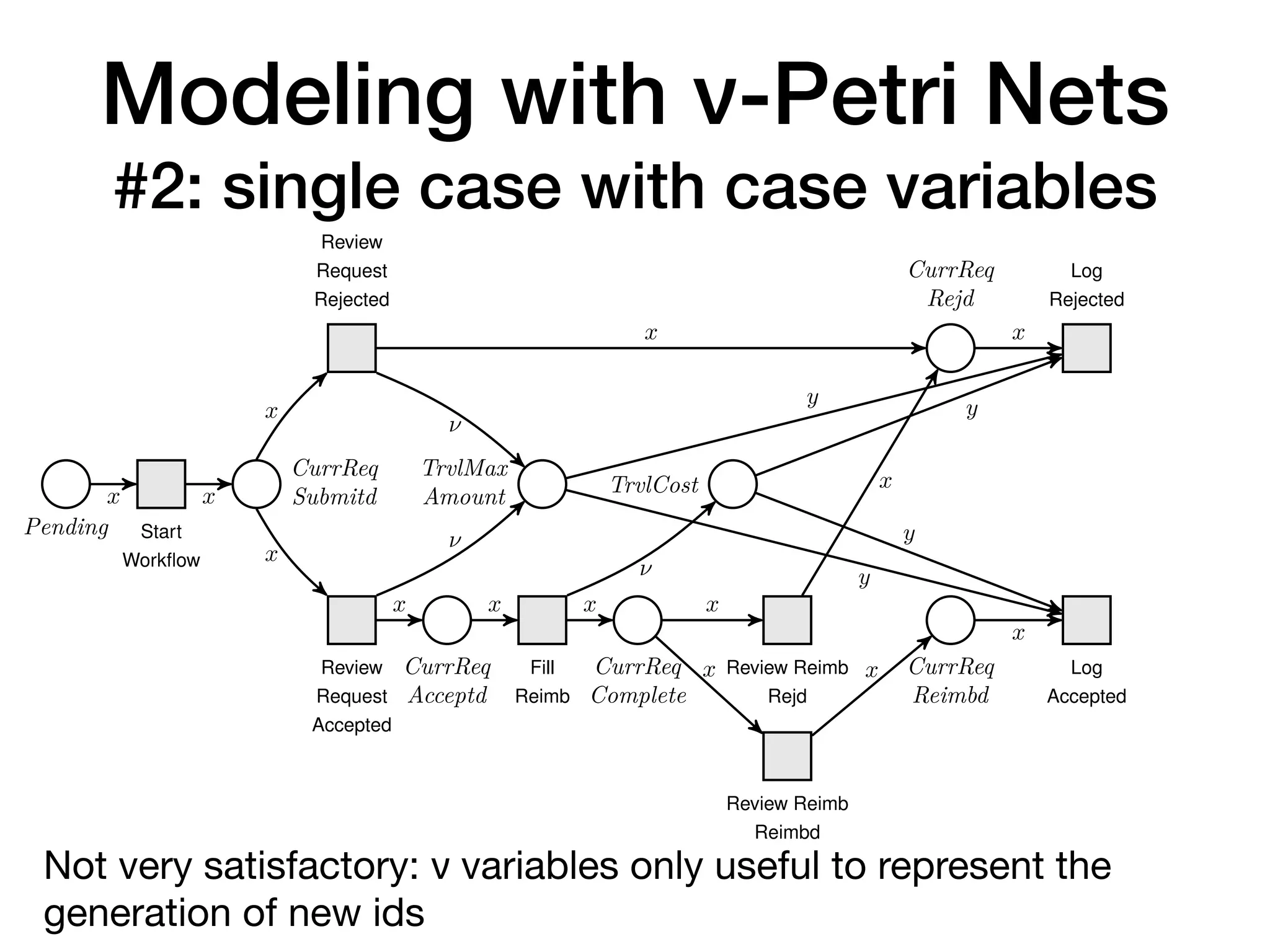
![Model Ceckhing ν-Petri Nets
[Formal Asp. Comp. 2016]
Encoding of ν-PNs into DCDSs
Bounded ν-PNs translate into state-bounded DCDSs
—> An interesting class of DCDSs with decidable state-
boundedness
<— Verification against FO temporal logics](https://image.slidesharecdn.com/cooking-data-processes-tue-feb-2019-190520214845/75/Cooking-with-Data-and-Processes-46-2048.jpg)
![Data Petri Nets
[Mannhardt PhD Thesis 2018]
• Petri nets with external (case) variables
• Each variable has a datatype (with possibly infinite domain)
• Transitions read and write variables
• Boolean formulae used to express
• guards
• constraints on value insertion
• In [ER 2018] we argued that DPNs elegantly capture decision-
aware process models with DMN tables [Batoulis et al, ER 2017]
D
M
Ndiscoverable](https://image.slidesharecdn.com/cooking-data-processes-tue-feb-2019-190520214845/75/Cooking-with-Data-and-Processes-47-2048.jpg)
![DPN ExampleM. de Leoni, P. Felli, M. Montali
i
credit
request
[amountw
≥ 0]
p1
verify
[okw
]
renegotiate
request
!
amountr
> 15000
∧ okr
== false
"
skip
assessment
!
okr
== false
"
p2
simple
assessment
!
okr
== true ∧ okw
∧ amountr
< 5000
"
advanced
assessment
!
okr
== true ∧ okw
∧ amountr
≥ 5000
"
p3
AND split p5p4
open
credit loan
[okr
== true]
inform acceptance
customer VIP
inform acceptance
customer normal
!
okr
== true
∧ amountr
< 10000
"
inform rejection
customer VIP
!
okr
== true
∧ amountr
≥ 10000
"!
okr
== false
∧ amountr
≥ 10000
"
p7p6 AND join
o
1. Our working example of a DPN. Writing operations exist every time guards mention
Managing a request with 2 case variables](https://image.slidesharecdn.com/cooking-data-processes-tue-feb-2019-190520214845/75/Cooking-with-Data-and-Processes-48-2048.jpg)
![Soundness of DPNs
with variable-constant conditions
[ER 2018]
Definition of data-aware soundness (soundness with “some”
variable assignment)
Data abstraction technique that preserves soundness
• Consider representative values instead of actual values
• There are finitely many constants used in the net, so
representatives are finite
• Propositionalize the data and analyze the resulting net
Recently extended to variable-variable conditions, using
constraints instead of representative values](https://image.slidesharecdn.com/cooking-data-processes-tue-feb-2019-190520214845/75/Cooking-with-Data-and-Processes-49-2048.jpg)
![• Implementation in CPN Tools / ProM
1. Translate the DPN into a CPN
• Each variable becomes a coloured place
• The place always contains a single token tracking the variable value
• Read-write operations —> outgoing/incoming arcs
2. Fix the domain of a variable place to contain only its finitely many
representatives —> bounded CPN!
Soundness of DPNs
with variable-constant conditions
[ER 2018]
Soundness Verification of Decision-Aware Process Models 9
i
A
[xw
] p1
B
[xr
> 10]
C
[xr
≤ 10]
Fig. 2. Conversion of a simple DPN to CPN (left to right). The green token represents a token with
value 0. Arcs without annotations are considered annotated by v• and places with no color are
associated with •. Double-headed arcs stand for two arcs with same inscription in both directions.](https://image.slidesharecdn.com/cooking-data-processes-tue-feb-2019-190520214845/75/Cooking-with-Data-and-Processes-50-2048.jpg)
![• Implementation in CPN Tools / ProM
1. Translate the DPN into a CPN
• Each variable becomes a coloured place
• The place always contains a single token tracking the variable value
• Read-write operations —> outgoing/incoming arcs
2. Fix the domain of a variable place to contain only its finitely many
representatives —> bounded CPN!
Soundness of DPNs
with variable-constant conditions
[ER 2018]
Soundness Verification of Decision-Aware Process Models 9
i
A
[xw
] p1
B
[xr
> 10]
C
[xr
≤ 10]
Fig. 2. Conversion of a simple DPN to CPN (left to right). The green token represents a token with
value 0. Arcs without annotations are considered annotated by v• and places with no color are
associated with •. Double-headed arcs stand for two arcs with same inscription in both directions.
Soundness Verification of Decision-Aware Process Models](https://image.slidesharecdn.com/cooking-data-processes-tue-feb-2019-190520214845/75/Cooking-with-Data-and-Processes-51-2048.jpg)


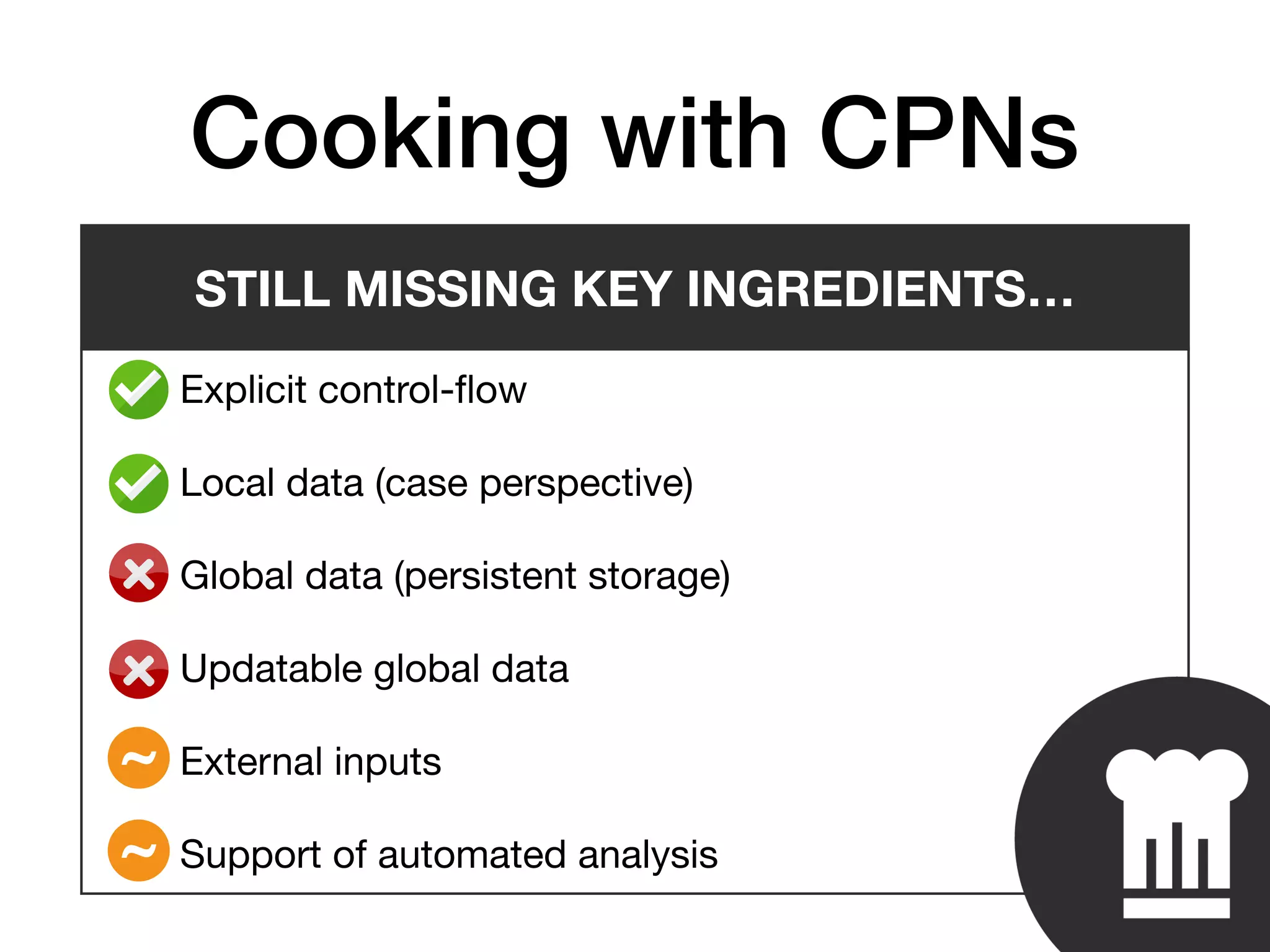

![DB-Nets
[ToPNoC 2017]
Relational DB with constraints
Persistence
layer
“basic” CPN
Control
layer](https://image.slidesharecdn.com/cooking-data-processes-tue-feb-2019-190520214845/75/Cooking-with-Data-and-Processes-56-2048.jpg)
![DB-Nets
[ToPNoC 2017]
Relational DB with constraints
Persistence
layer
“basic” CPN
Control
layer
Data logic layer
query action](https://image.slidesharecdn.com/cooking-data-processes-tue-feb-2019-190520214845/75/Cooking-with-Data-and-Processes-57-2048.jpg)
![DB-Nets
[ToPNoC 2017]
Relational DB with constraints
Persistence
layer
“basic” CPN
Control
layer
SQL/DCDSquery action
view place
Data logic
layer](https://image.slidesharecdn.com/cooking-data-processes-tue-feb-2019-190520214845/75/Cooking-with-Data-and-Processes-58-2048.jpg)
![DB-Nets
[ToPNoC 2017]
Relational DB with constraints
Persistence
layer
“basic” CPN
Control
layer
SQL/DCDSquery action
view place
a(x,y)
action-bound trans.
X
Data logic
layer](https://image.slidesharecdn.com/cooking-data-processes-tue-feb-2019-190520214845/75/Cooking-with-Data-and-Processes-59-2048.jpg)
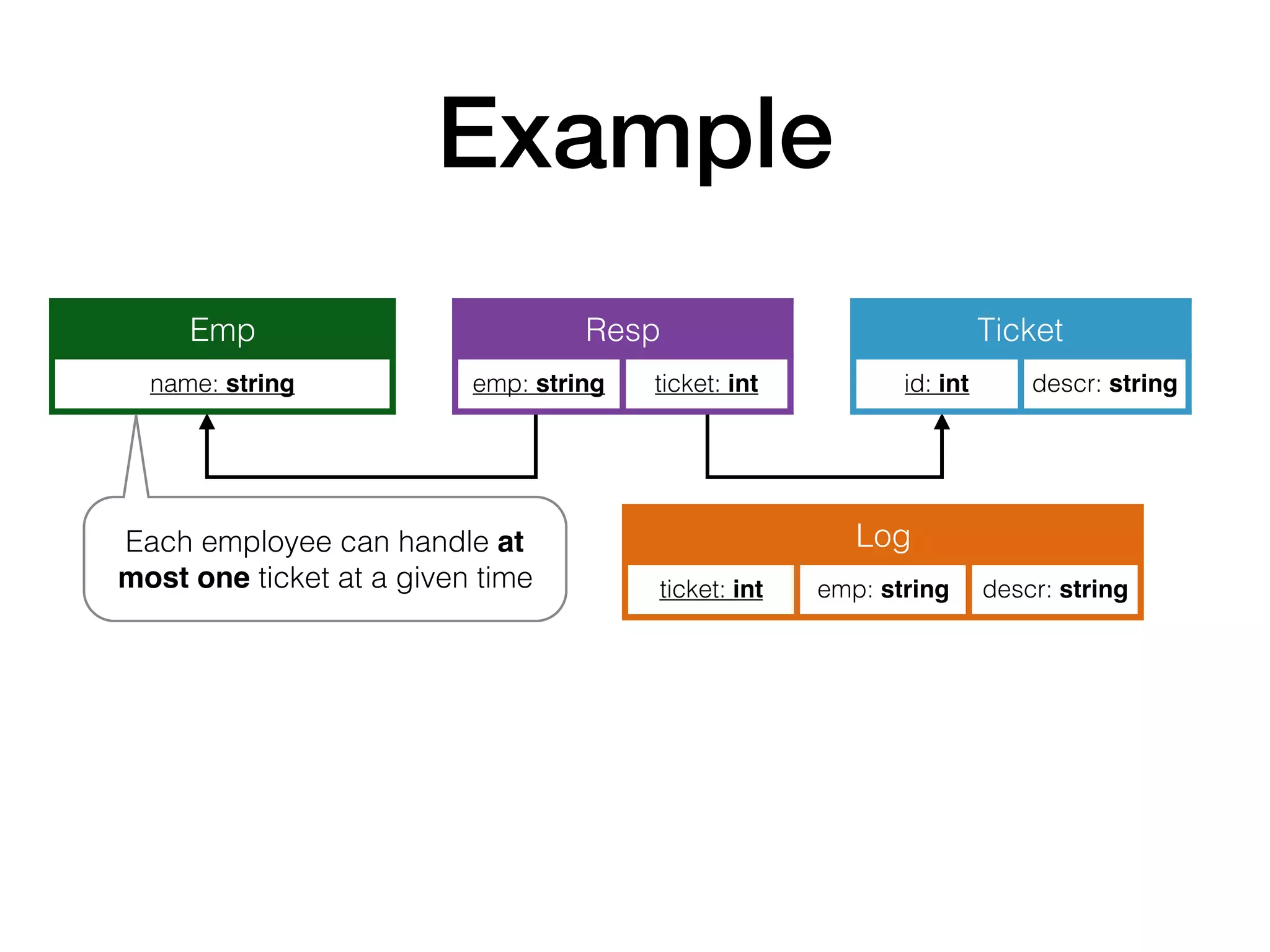
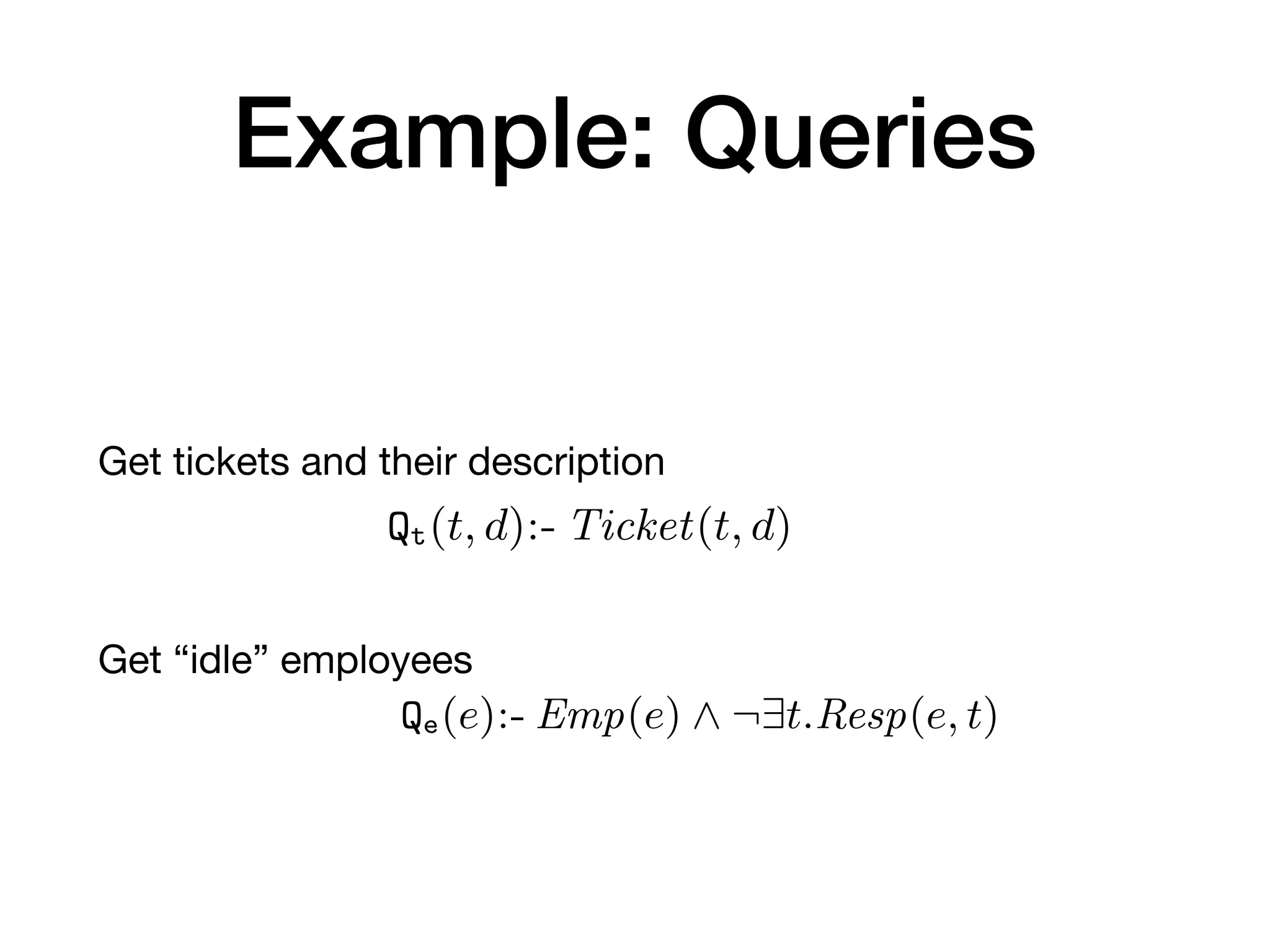
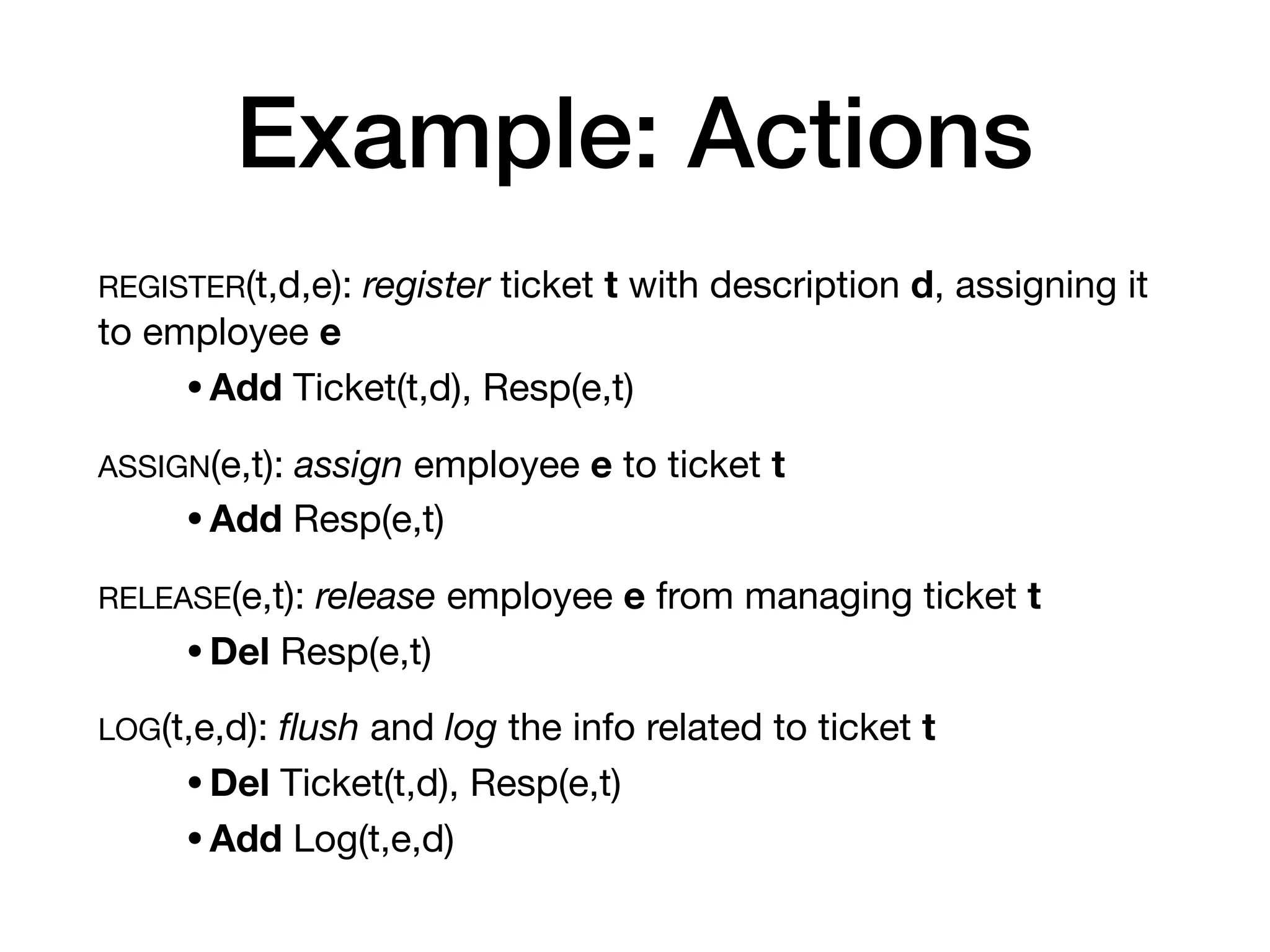
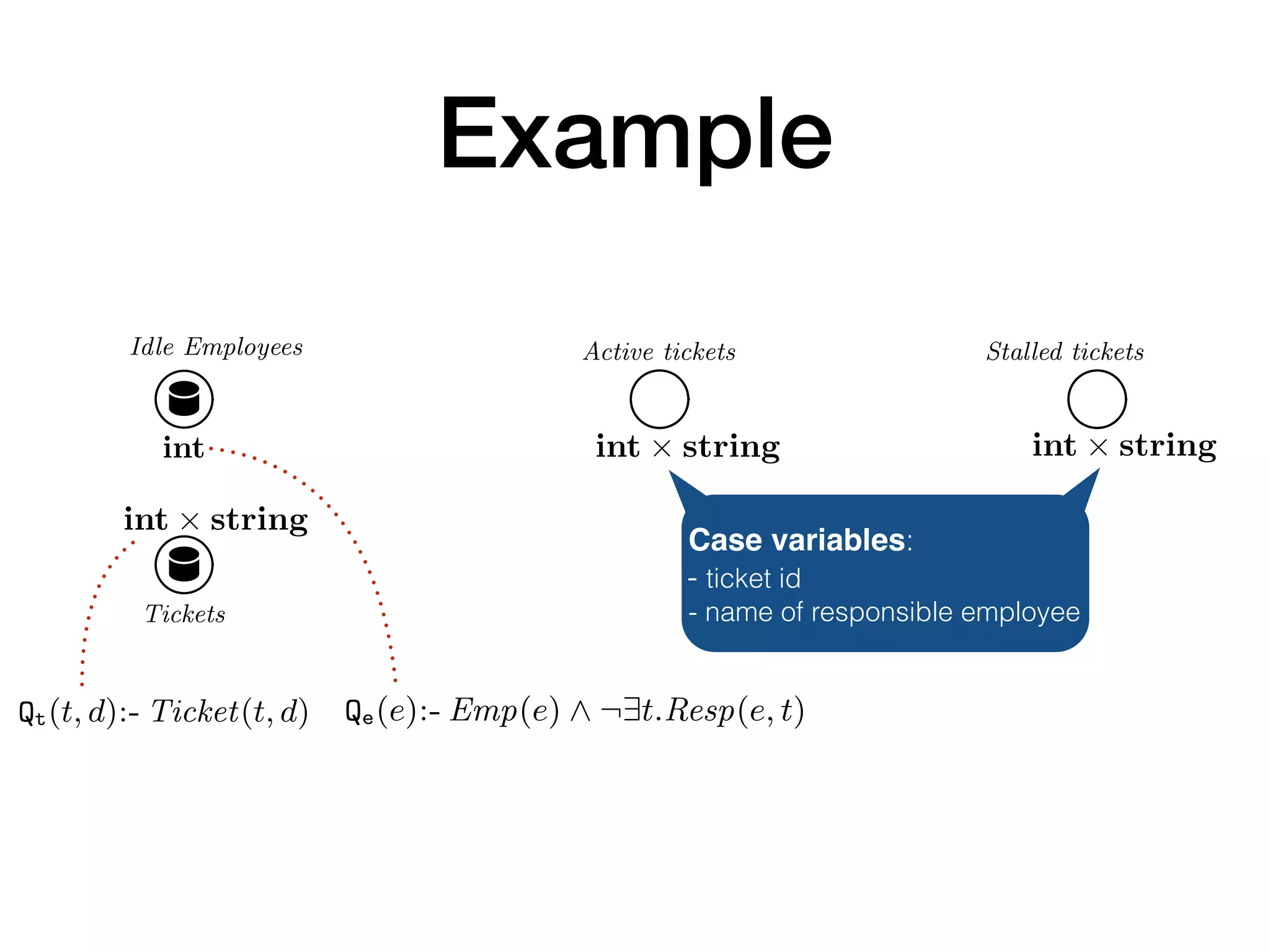
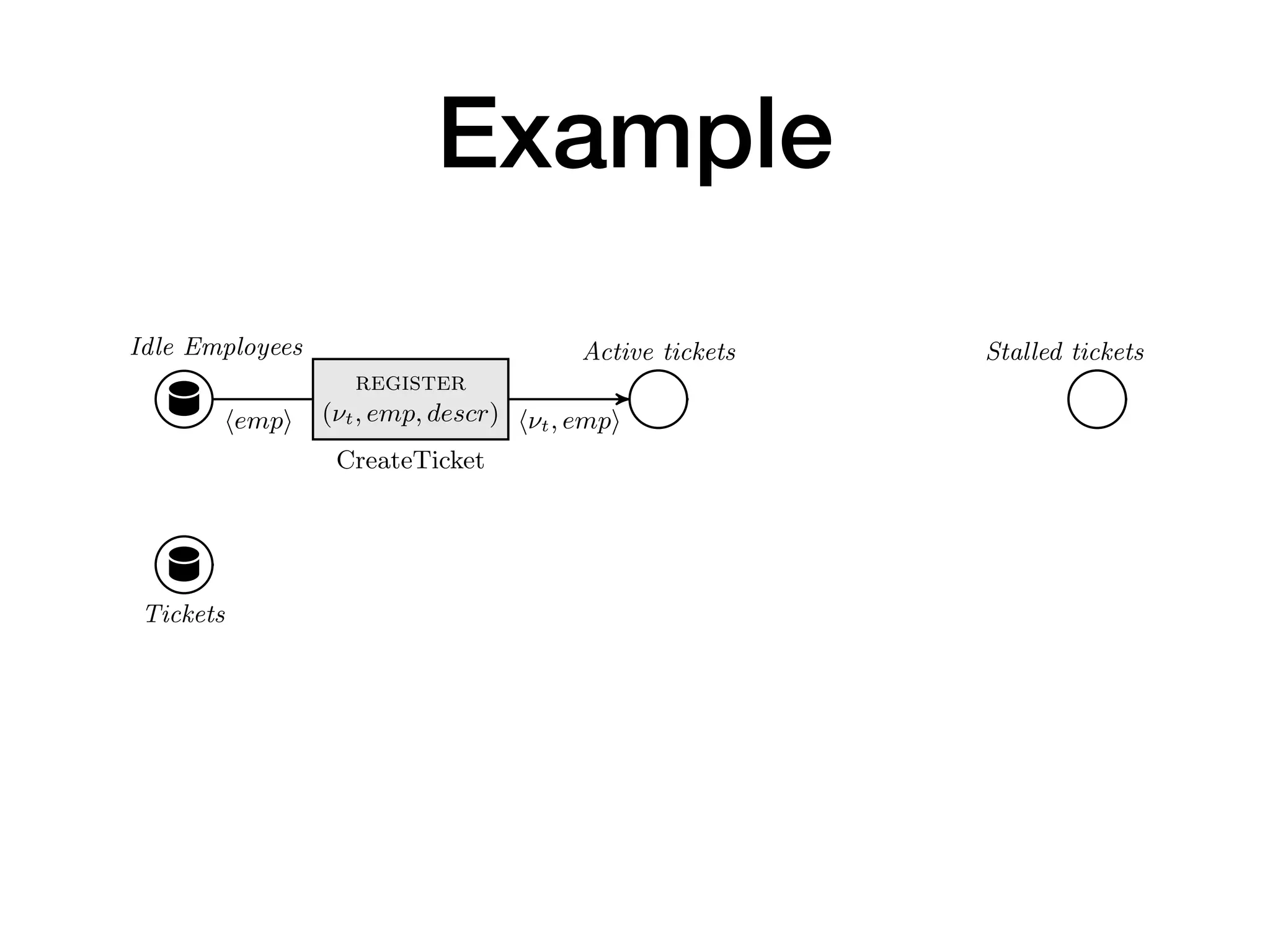
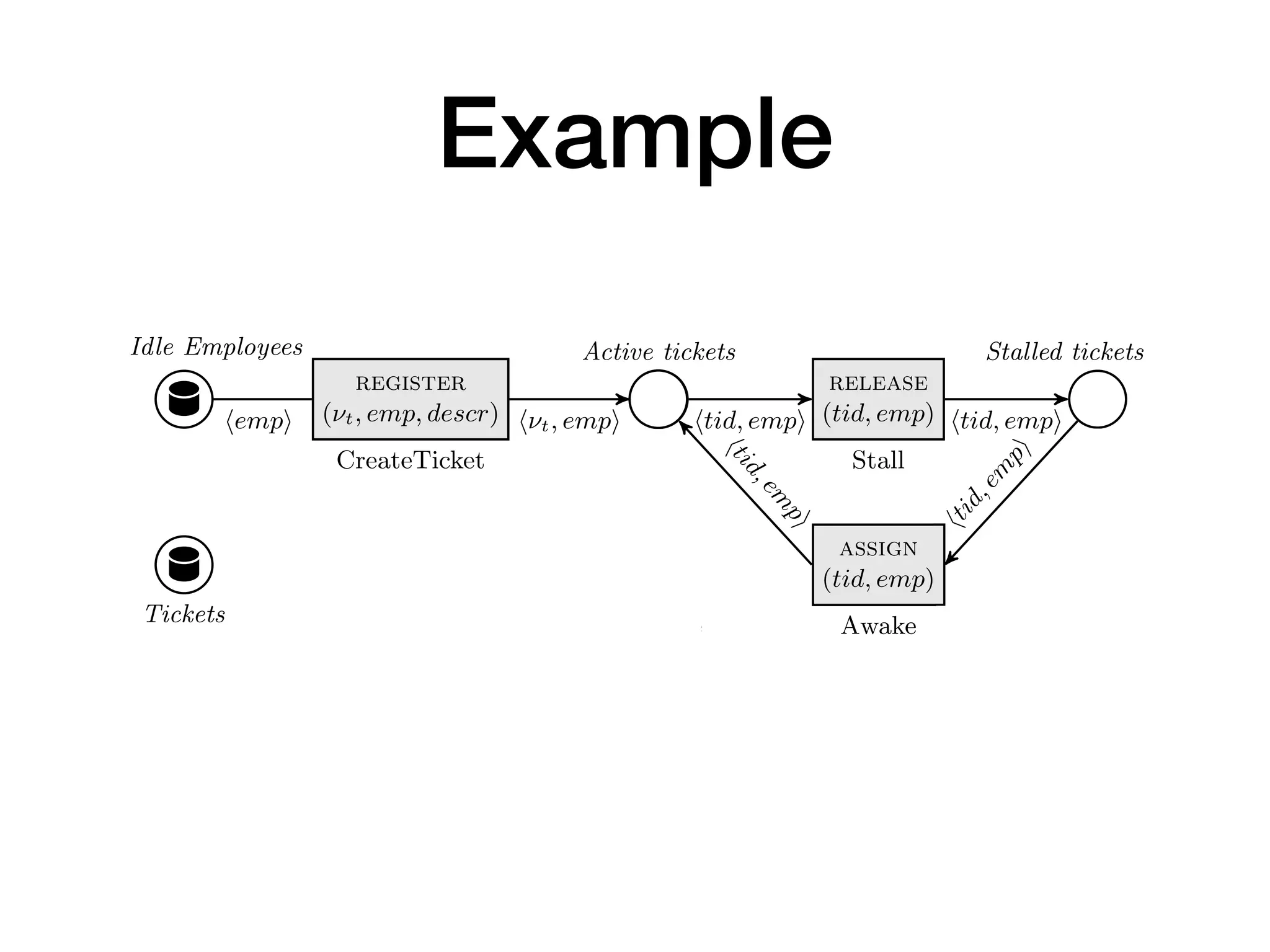
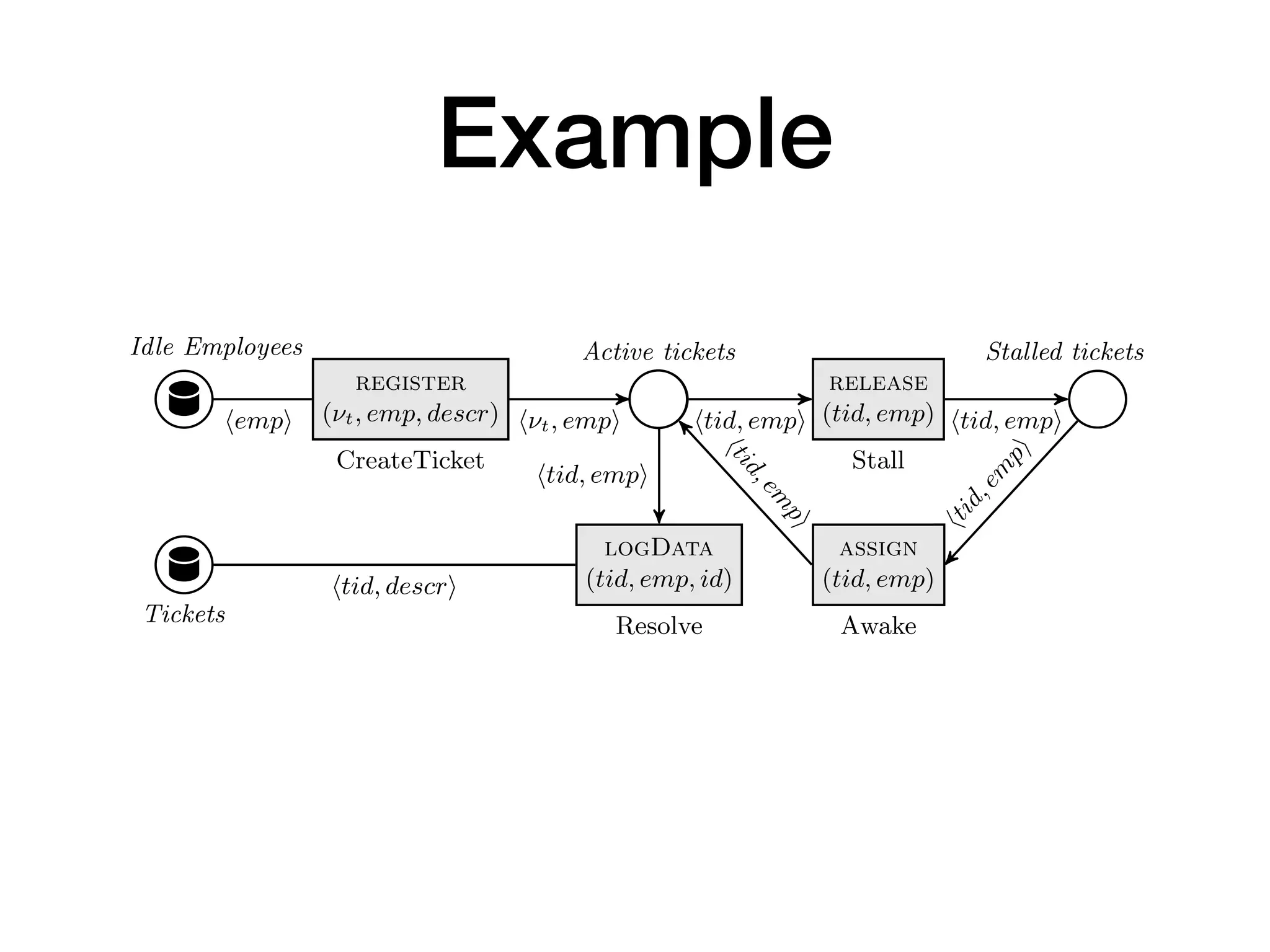
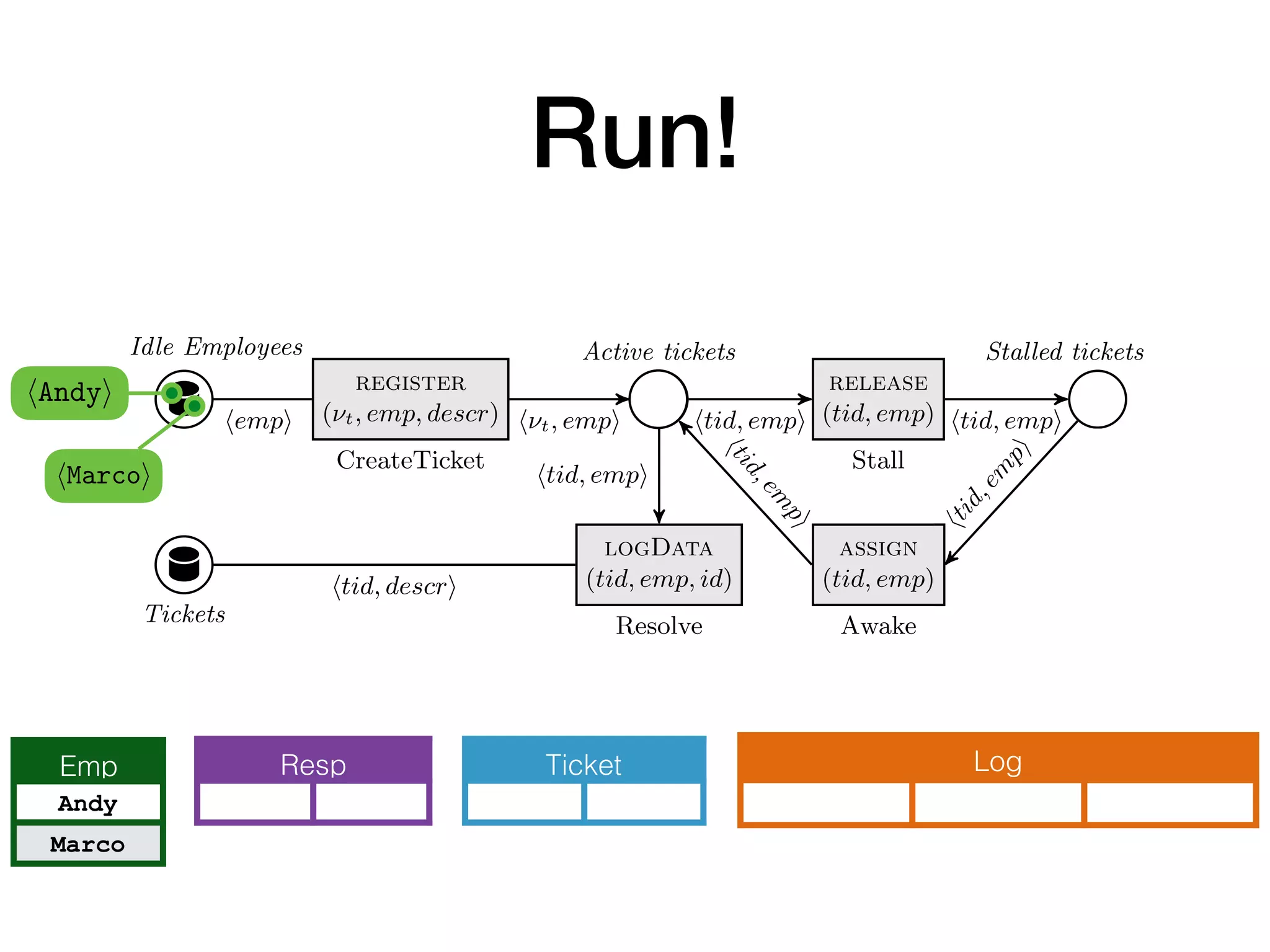
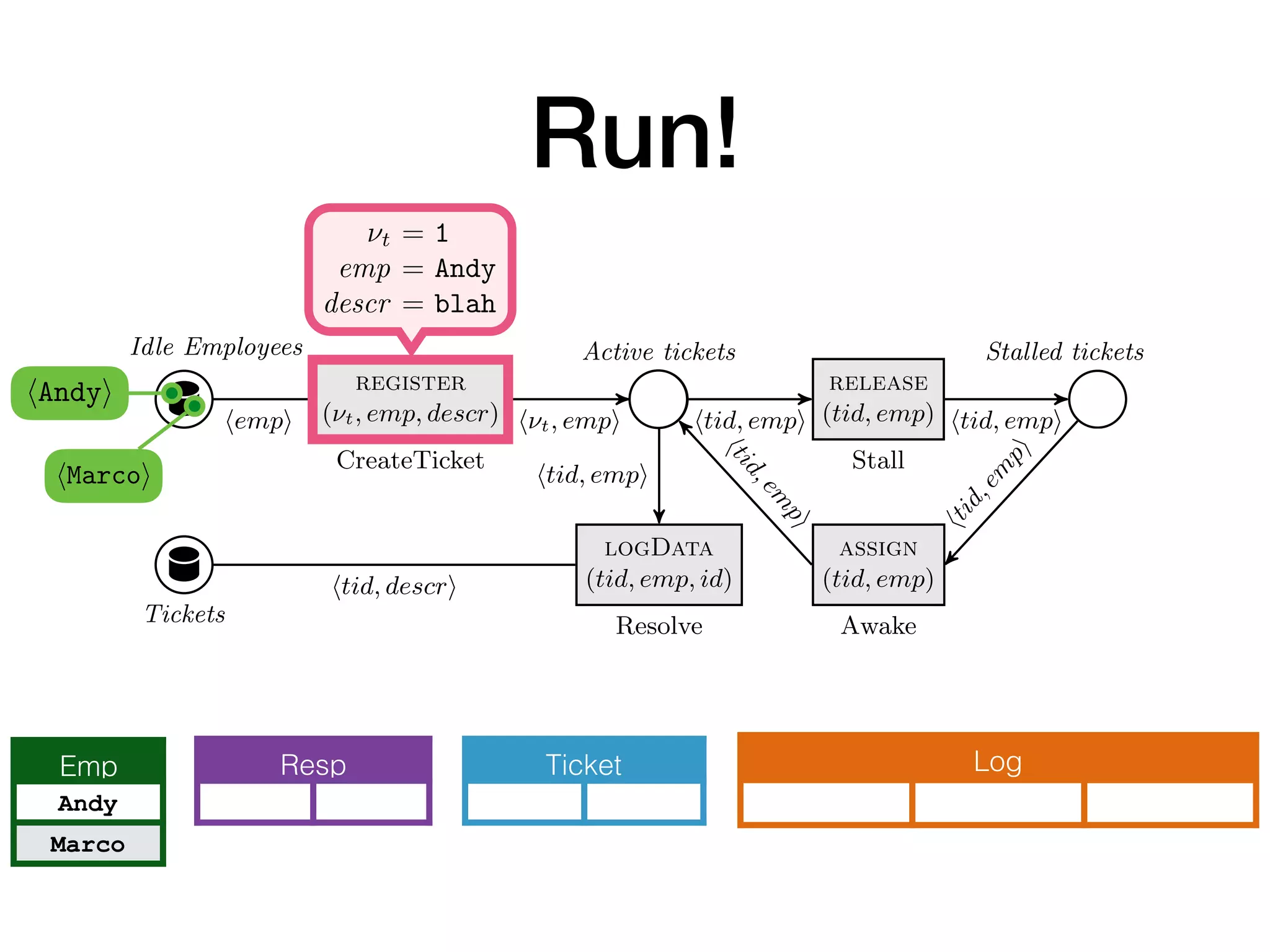
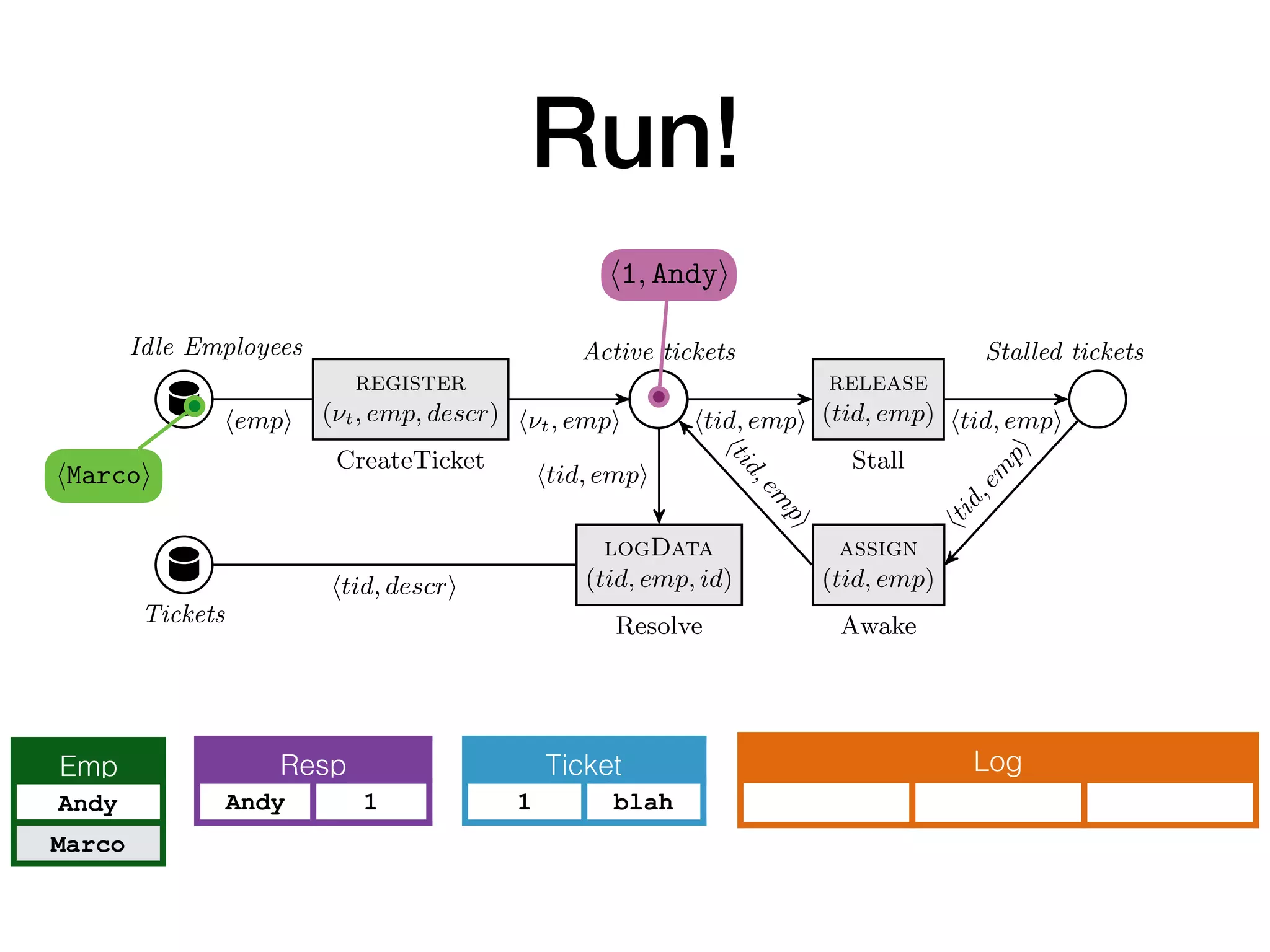
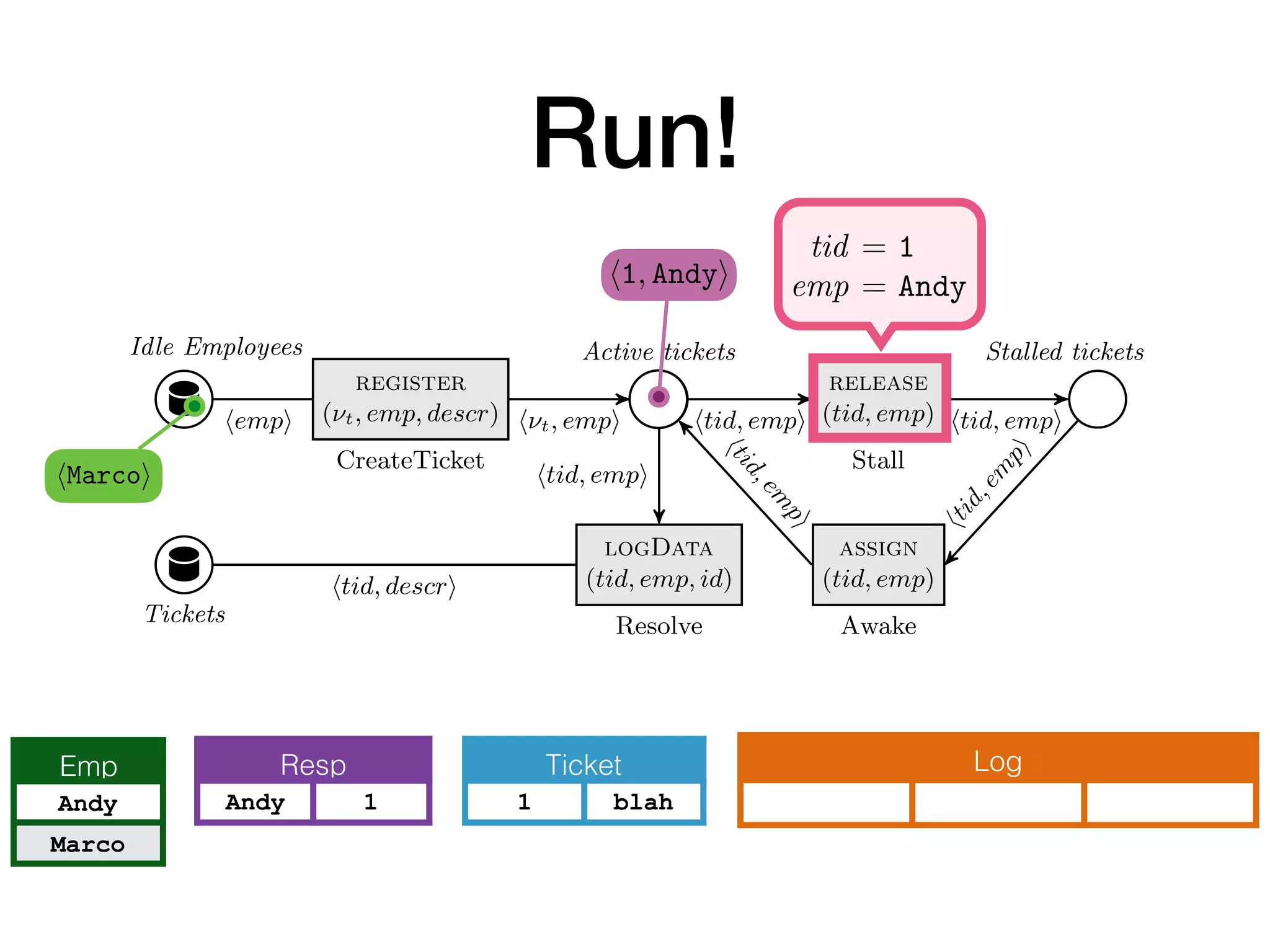
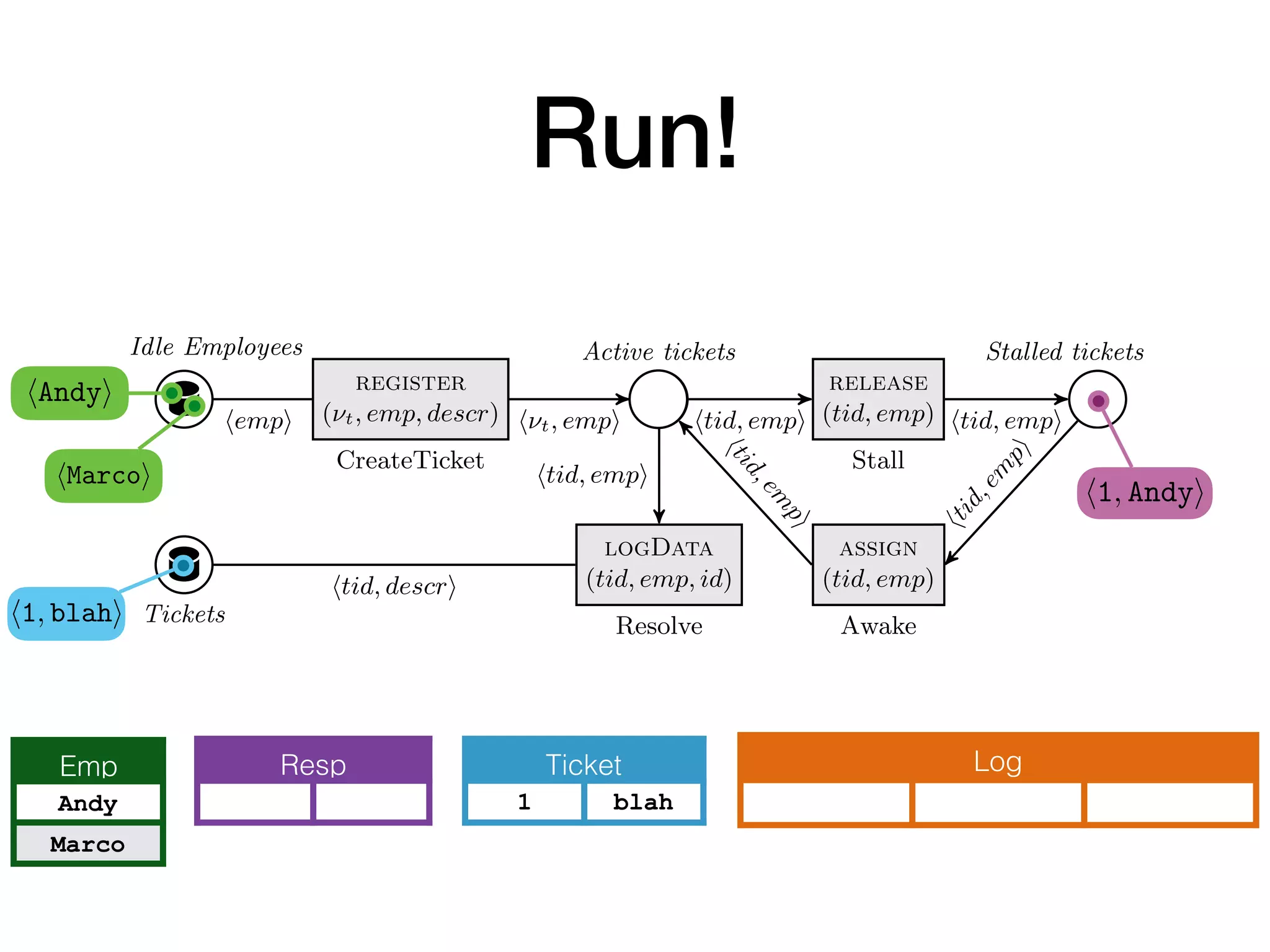
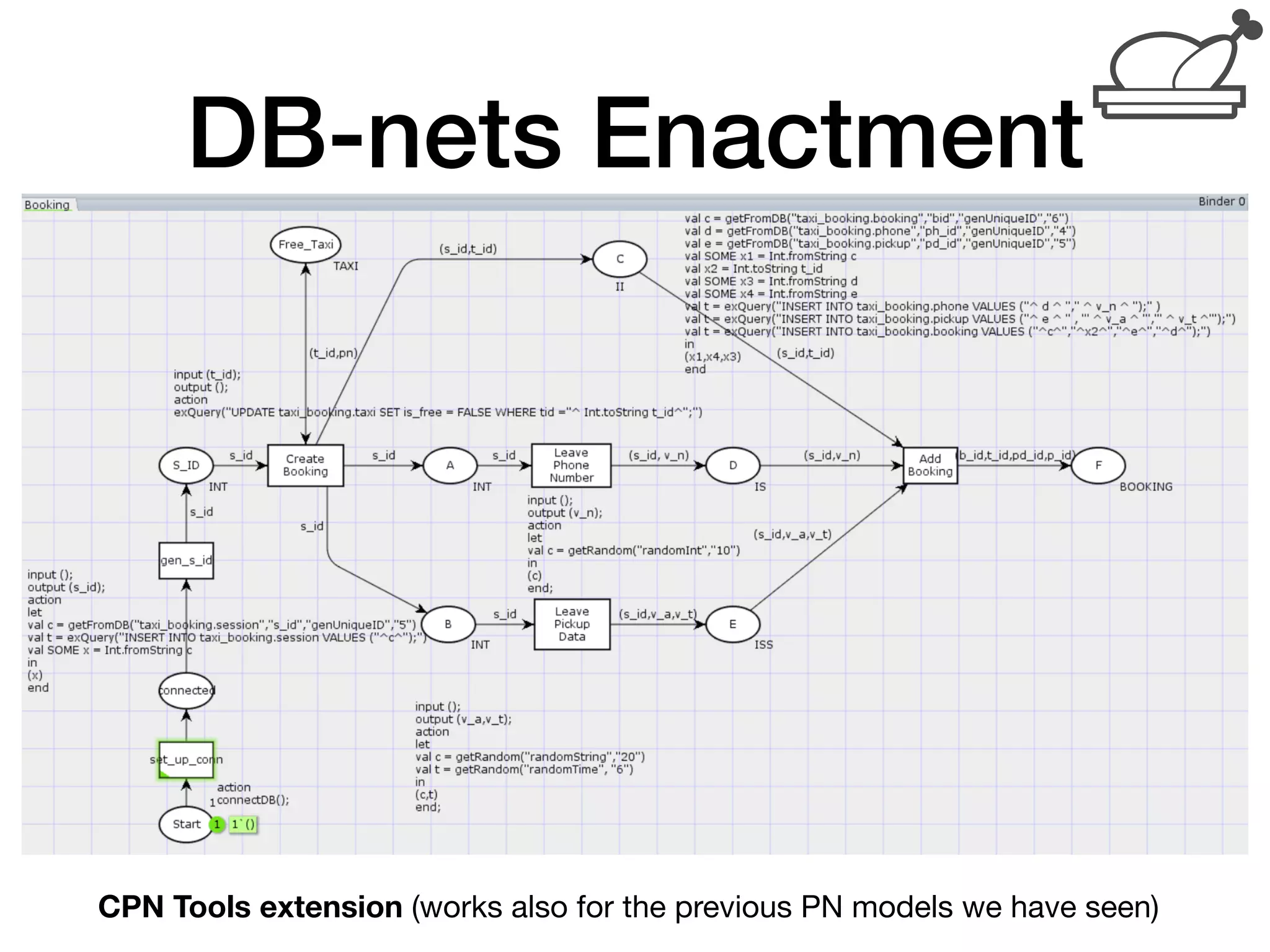
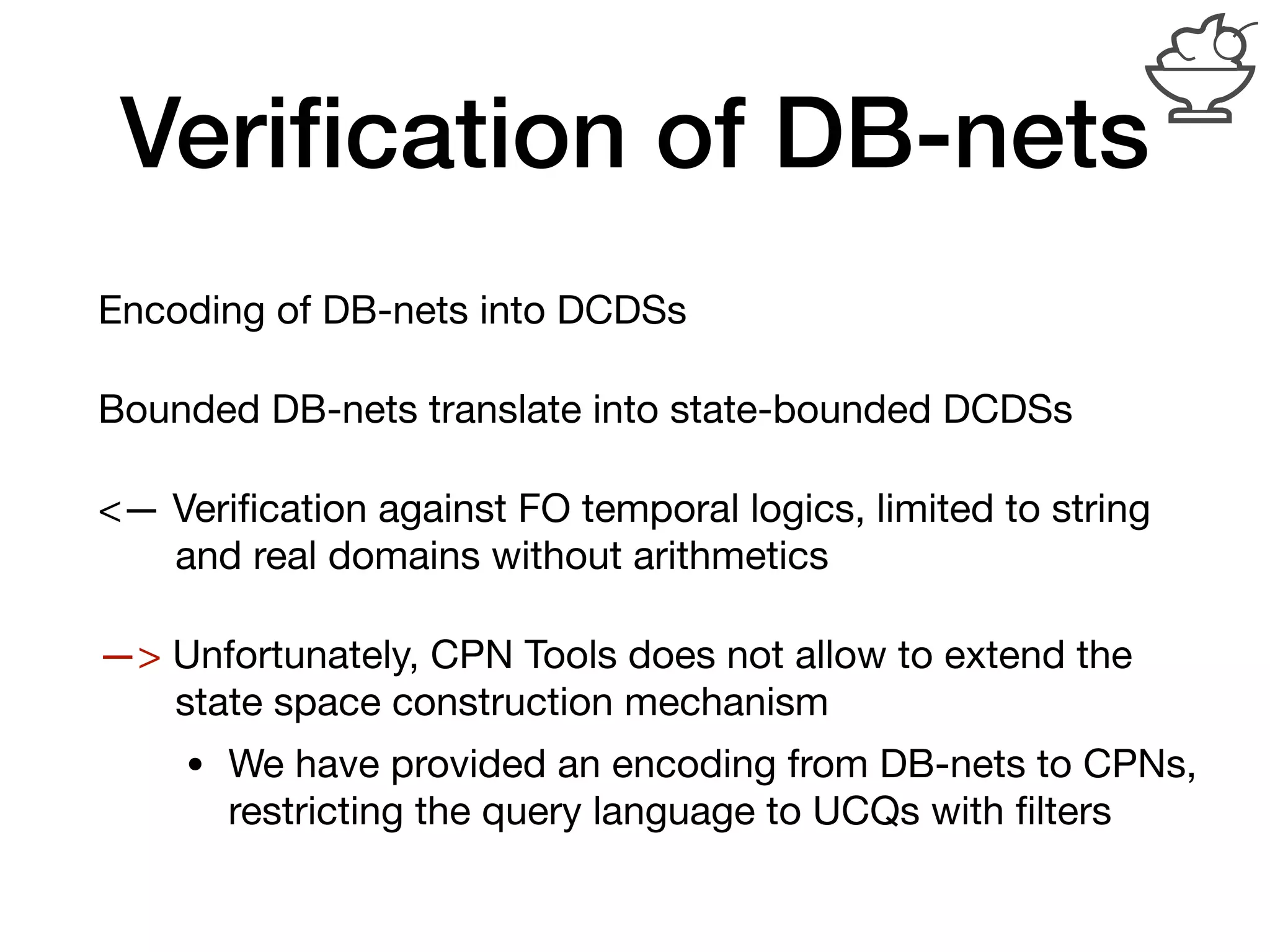
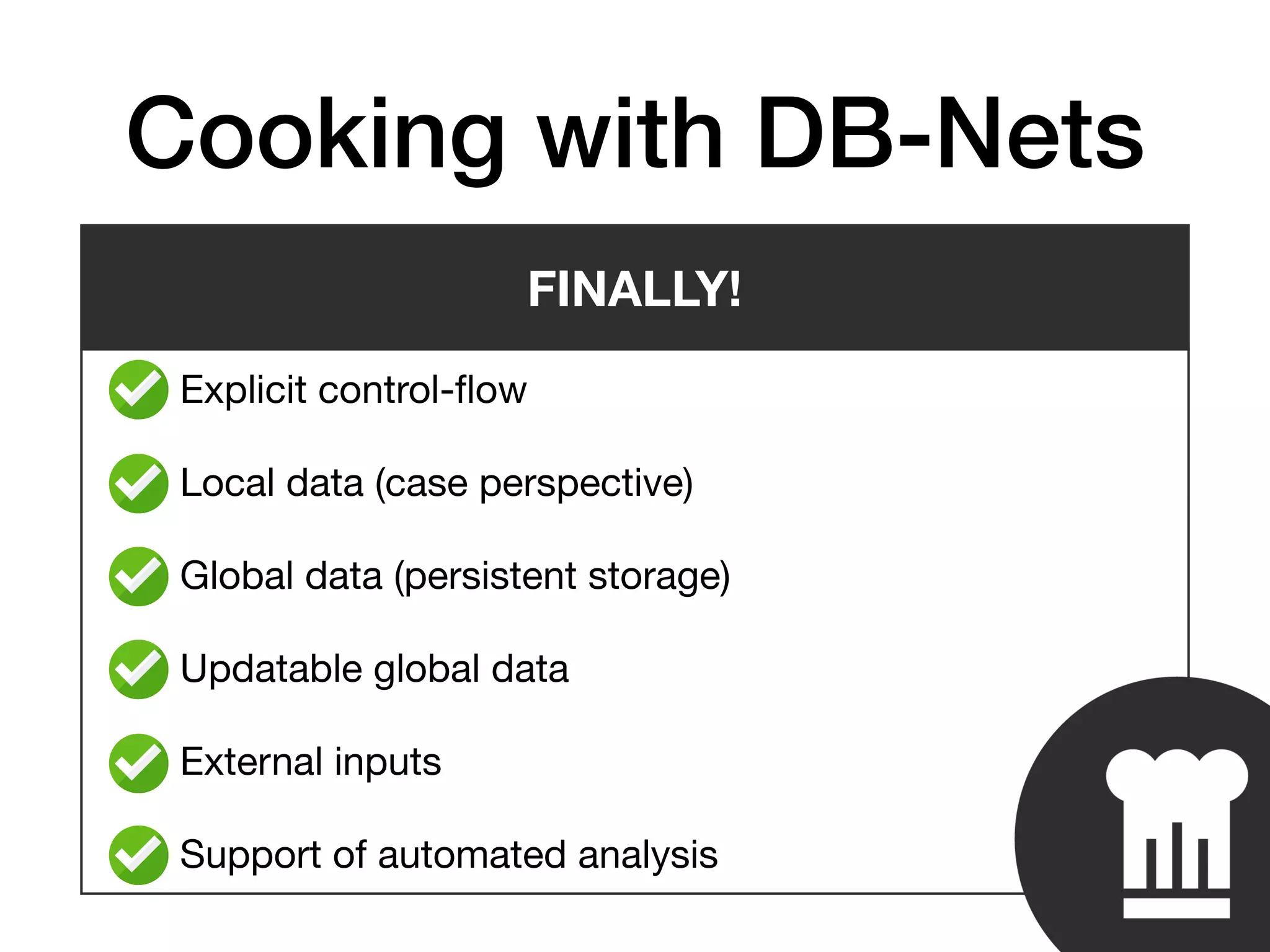
![Conclusion
A cookbook for integrated models of data and processes
• with increasing sophistication of the data component
• paying attention to modeling, enactment, and automated analysis
Which models for which scenarios?
• Application of DB-nets to application integration patterns [EDOC
2018]
Some open points for modeling
• Arithmetics?
• Connection with front-end languages
(data-aware BPMN soon to come)
• Connection with interaction models (Proclets)](https://image.slidesharecdn.com/cooking-data-processes-tue-feb-2019-190520214845/75/Cooking-with-Data-and-Processes-75-2048.jpg)
